Views: 150
New Works – July 2025
Bio (life) + Tope (place) – Water Lilies – July 2025
Water lilies float gently on the surface of the water, with their round leaves and softly coloured blossoms. Their name derives from the fact that the flowers close at night, as if they were “sleeping lotuses.”
In recent years, water lilies have become symbolic of “biotopes” — harmonious spaces where humans and nature coexist. Along the waterside, they provide important habitats for frogs, dragonflies, and wild birds, playing a vital role in nearby ecosystems.
*Biotope* comes from the Greek words “bios” (life) and “topos” (place).
July 5, 2025 (Reiwa 7)
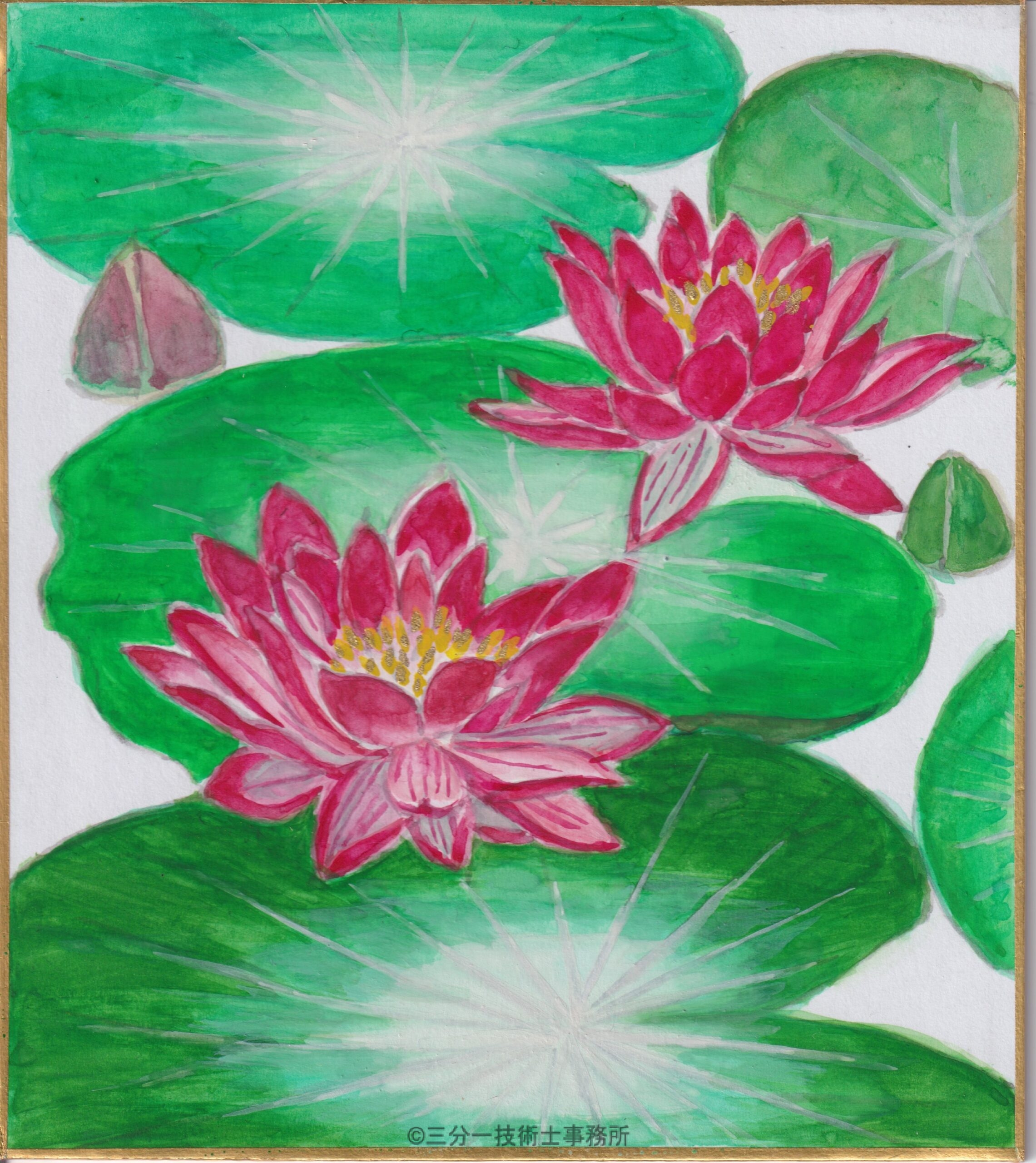
Sunshōan Color Paper (1/4 size 136×120mm)
Hangeshō – Chinese Lizard’s Tail – June 2025
In the traditional Japanese calendar, *Hangeshō* refers to the five-day period from July 2 to July 7, beginning 11 days after the summer solstice.
The plant *Hangeshō* (Saururus chinensis, of the Saururaceae family) is named after this season, as it blooms around this time.
Its name, meaning “half-makeup,” comes from the way its green leaves partially turn white during this season — as if they were modestly made-up.
The “72 micro-seasons” (shichijūni kō) divide the year into five-day segments, marking subtle seasonal transitions.
June 15, 2025 (Reiwa 7)
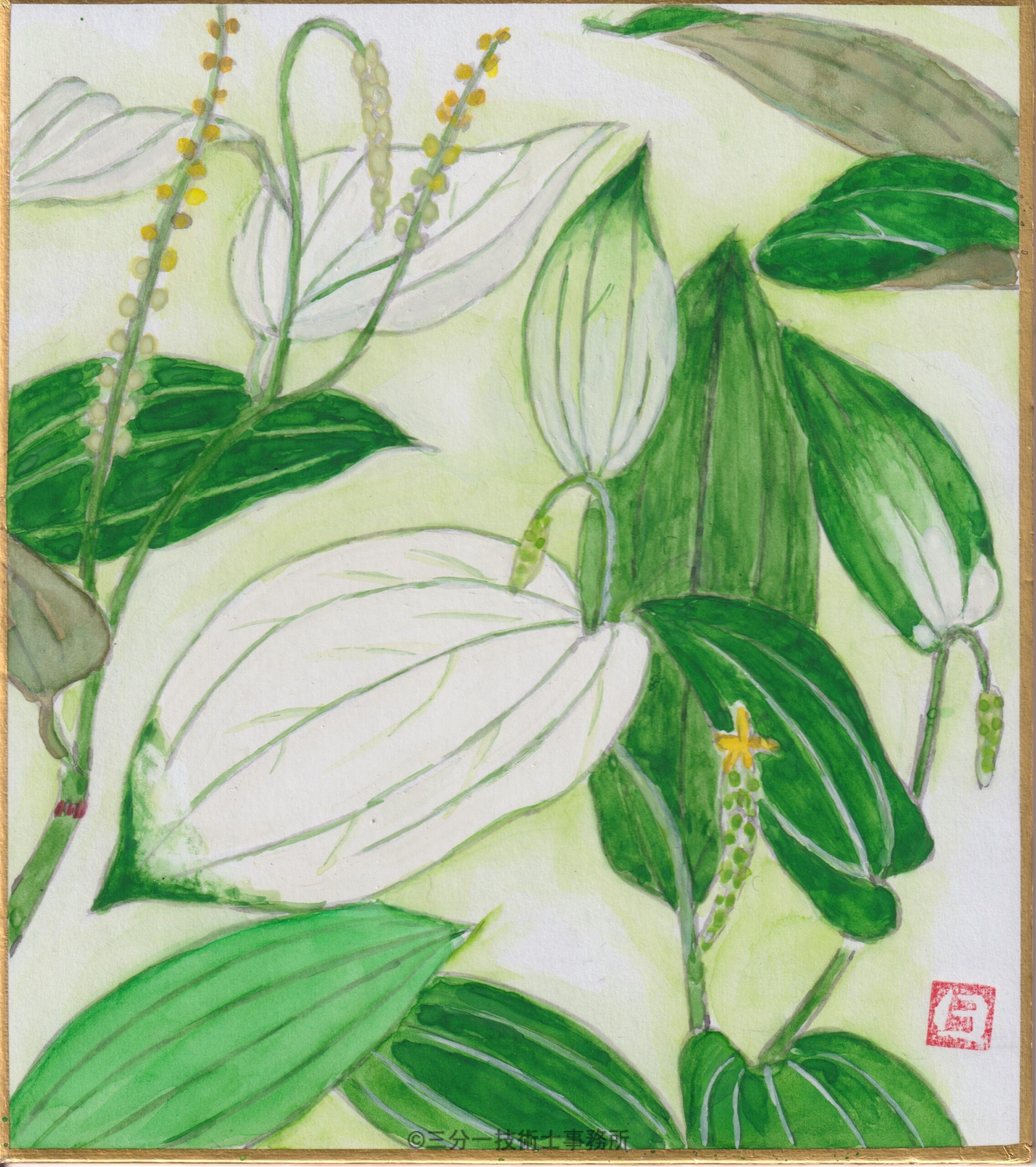
Sunshōan Color Paper (1/4 size 136×120mm)
Ume-no-mi Ripening – May 2025
Plum trees are enjoyed both for their blossoms (*hanaume*) and their fruit (*miume*).
As the fruits ripen, their ideal use varies — for instance, making umeshu (plum wine) or umeboshi (pickled plums) — with different levels of ripeness required.
The Japanese word “anbai” (balance or condition) originally referred to the balance of salt and plum vinegar used in pickling, and later came to describe balance or condition more broadly.
When the plum seed is cracked open, a kernel called *jin* is found inside, which has been affectionately referred to as *Tenjin-sama* (a divine spirit).
May 11, 2025 (Reiwa 7)
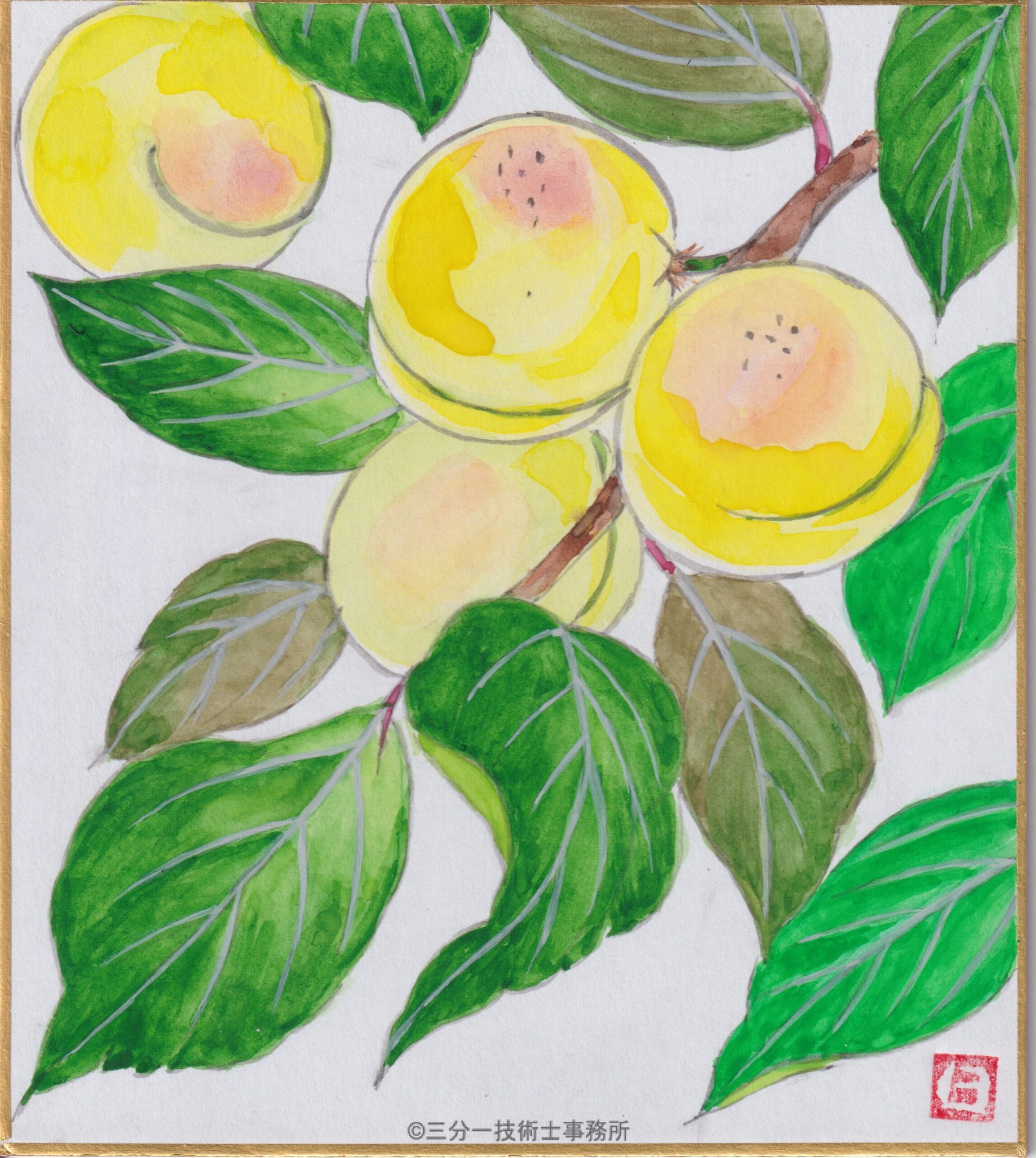
Sunshōan Color Paper (1/4 size 136×120mm)
Early Summer – Kingfisher Illustration (April 2025)
The kingfisher, with its cobalt blue feathers, is a stunning bird often called a “flying jewel.” It hunts small fish in freshwater habitats like ponds and rivers. In the refreshing breeze of a clear May day, as yellow irises bloom by the water’s edge, we imagine a kingfisher clutching a small fish in its beak – the essence of “Rikka,” the start of summer.
April 7, Reiwa 7
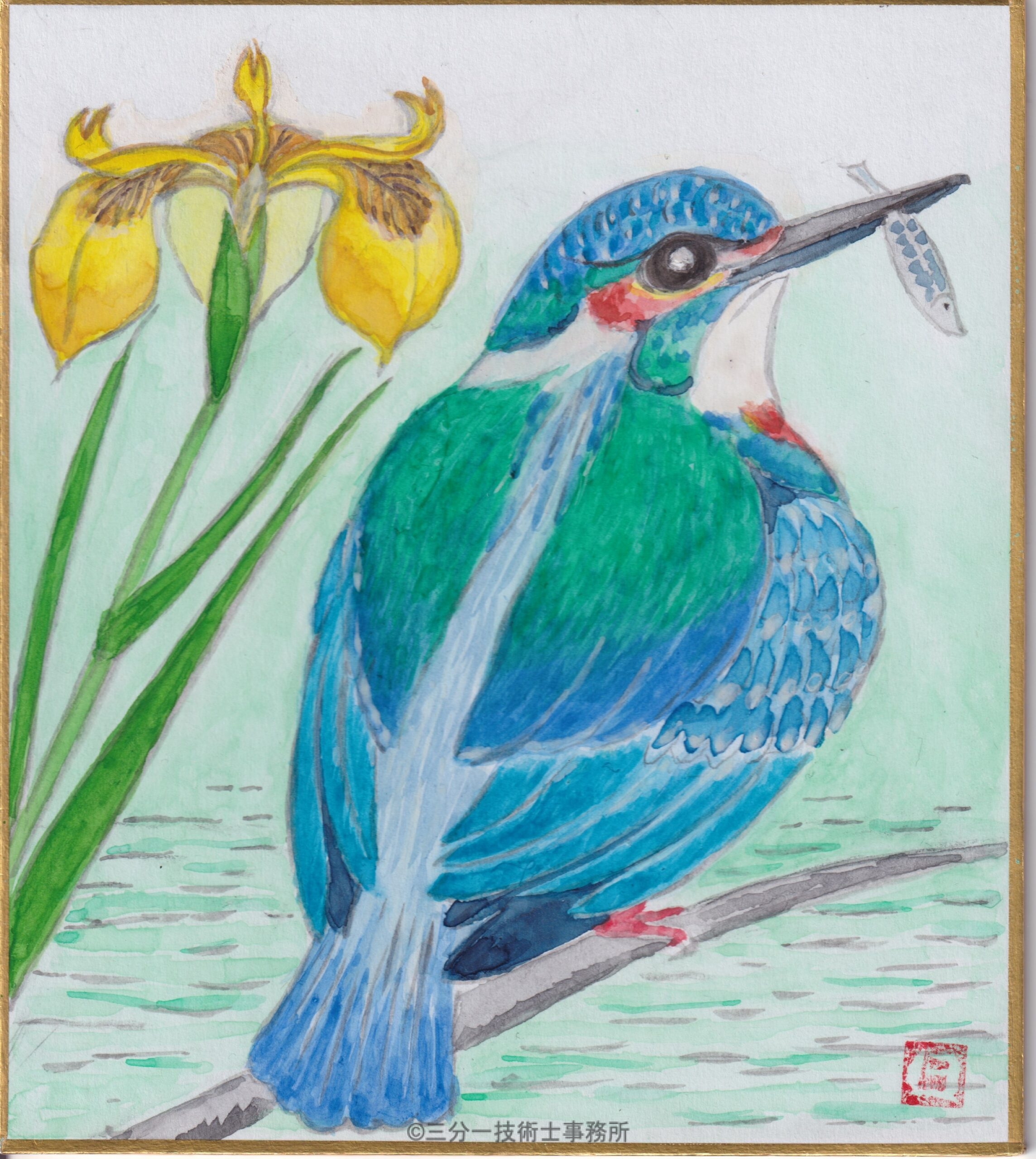
Sunsho-an Color Paper (1/4 size 136×120mm)
Wisteria – Ancient name “Fuji” (March 2025)
The name “Fuji” comes from the way the hanging blossoms sway in the breeze, as if the petals are “blown and scattered.” A native species of Japan, wisteria has long been cherished for its noble purple hues. Its vines were used to weave “Fuji cloth,” making durable workwear and rice sacks. Even today, “Fuji weaving” remains a prized local craft in rural villages.
March 10, Reiwa 7
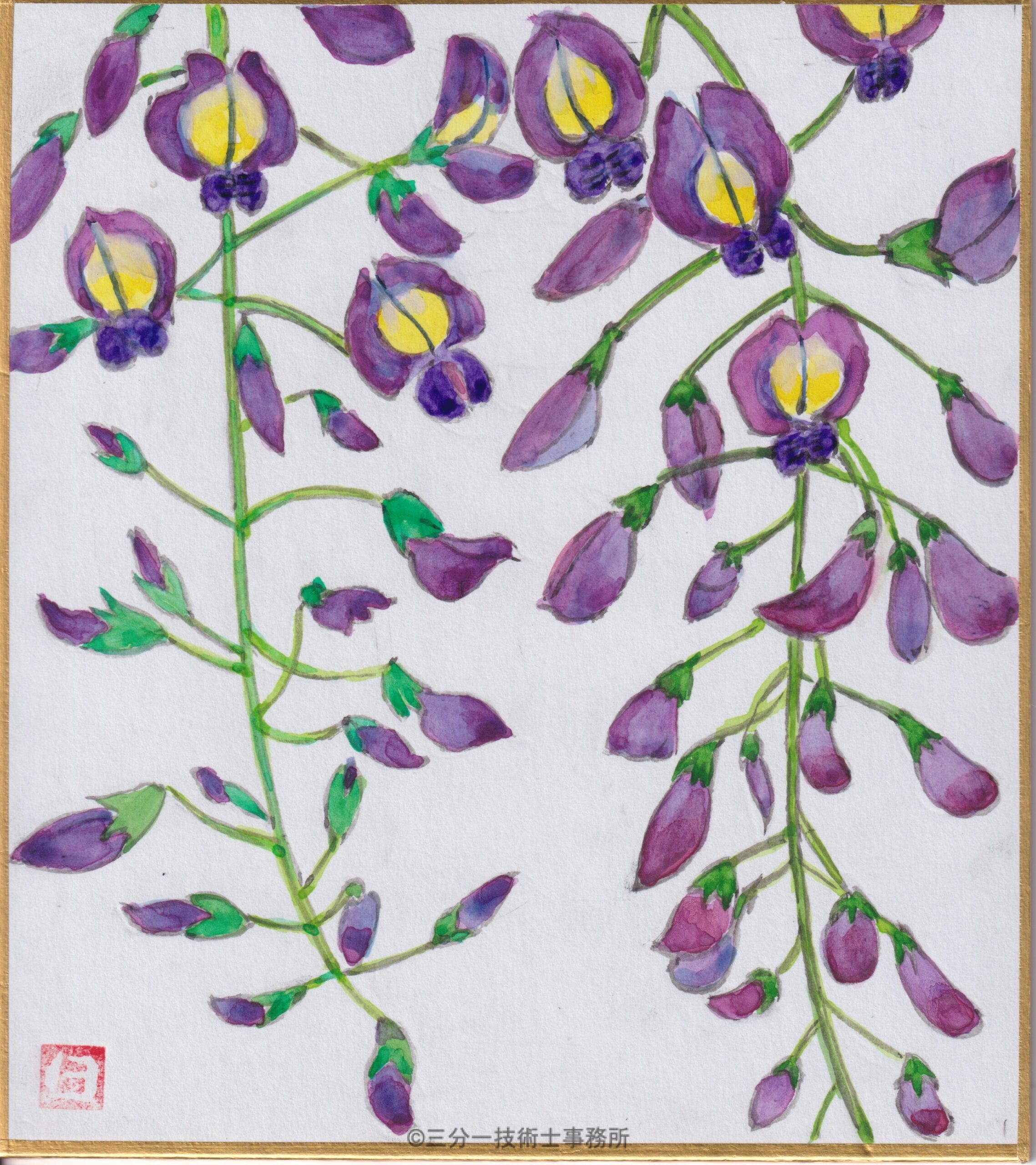
Sunsho-an Color Paper (1/4 size 136×120mm)
Early Spring Delights – Wild Greens (February 2025)
There’s an old saying, “In spring, serve bitterness.” The bitter taste of wild mountain vegetables is believed to help cleanse the body of winter toxins. As spring arrives, the budding greenery of fields and hills brings vitality to both nature and people.
February 15, Reiwa 7
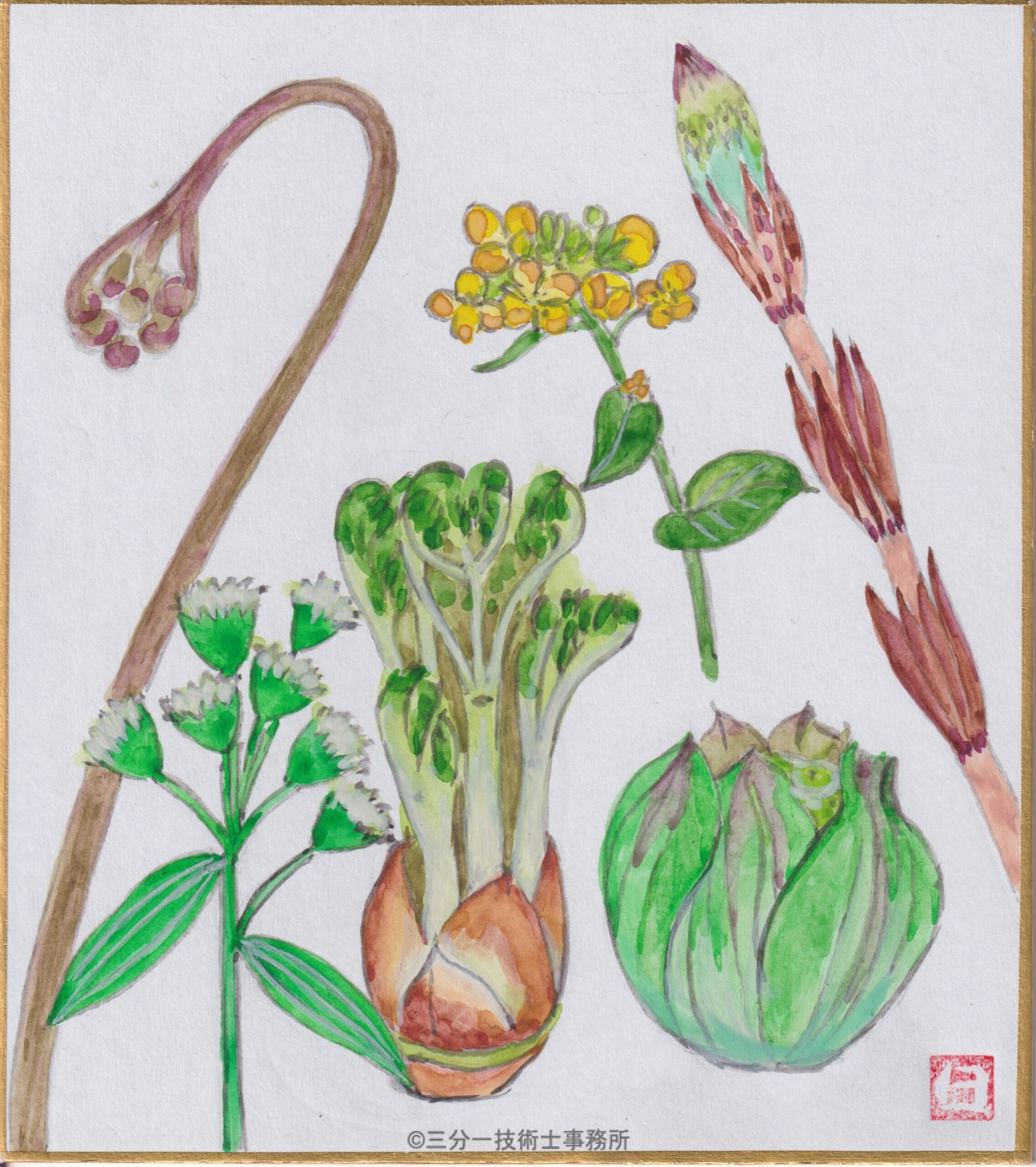
Sunsho-an Color Paper (1/4 size 136×120mm)
Beginning of Spring – Plum Blossoms (January 2025)
“Risshun,” the first day of spring, symbolises the turning point when cold transforms into warmth. Plum blossoms endure the chill to bloom gracefully, releasing a subtle sweet fragrance – a harbinger of spring. Plum trees have long lifespans, often living 100 to 300 years.
January 19, Reiwa 7
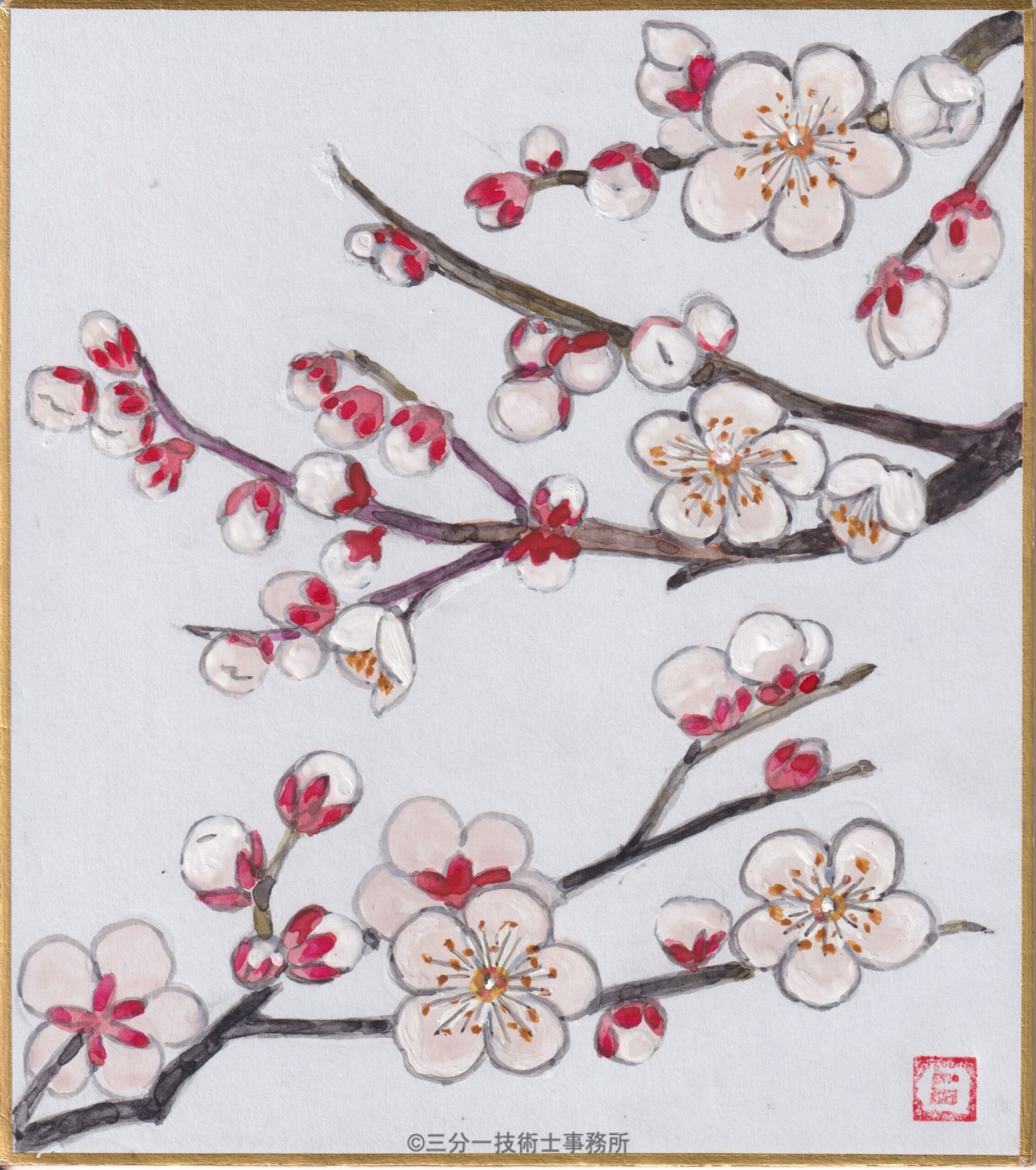
Sunsho-an Color Paper (1/4 size 136×120mm)
Year of the Snake – Wishing for Auspicious Beginnings (January 2025)
Snakes have long been revered as deities of abundance and weather. Because they shed their skin, snakes symbolize “rebirth and renewal.” They are considered auspicious creatures, associated with longevity and vitality. May this year bring health and happiness to all.
New Year’s Day, Reiwa 7
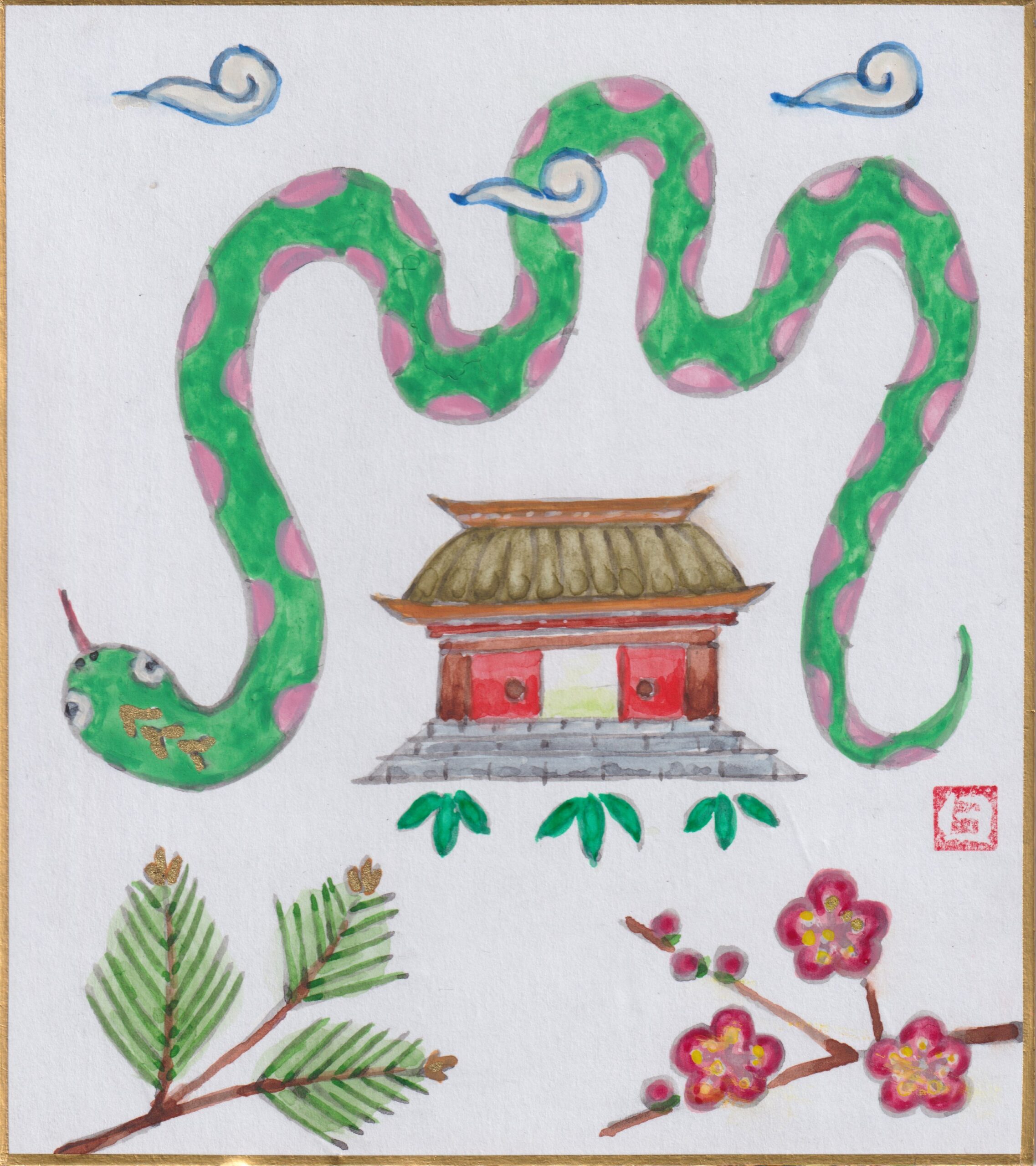
Sunsho-an Color Paper (1/4 size 136×120mm)
Winter Solstice – Yuzu Citrus Illustration (November 2024)
“Winter Solstice” marks the season when winter deepens. A traditional custom on this day is bathing with yuzu citrus, playing on the words *tōji* (solstice) and *tōji* (hot spring cure). Yuzu is also associated with *yūzū ga kiku* (flexibility). The rind of yuzu is rich in benefits – it helps prevent colds, moisturises skin, and improves circulation. After the solstice, the days gradually grow longer.
November 8, Reiwa 6
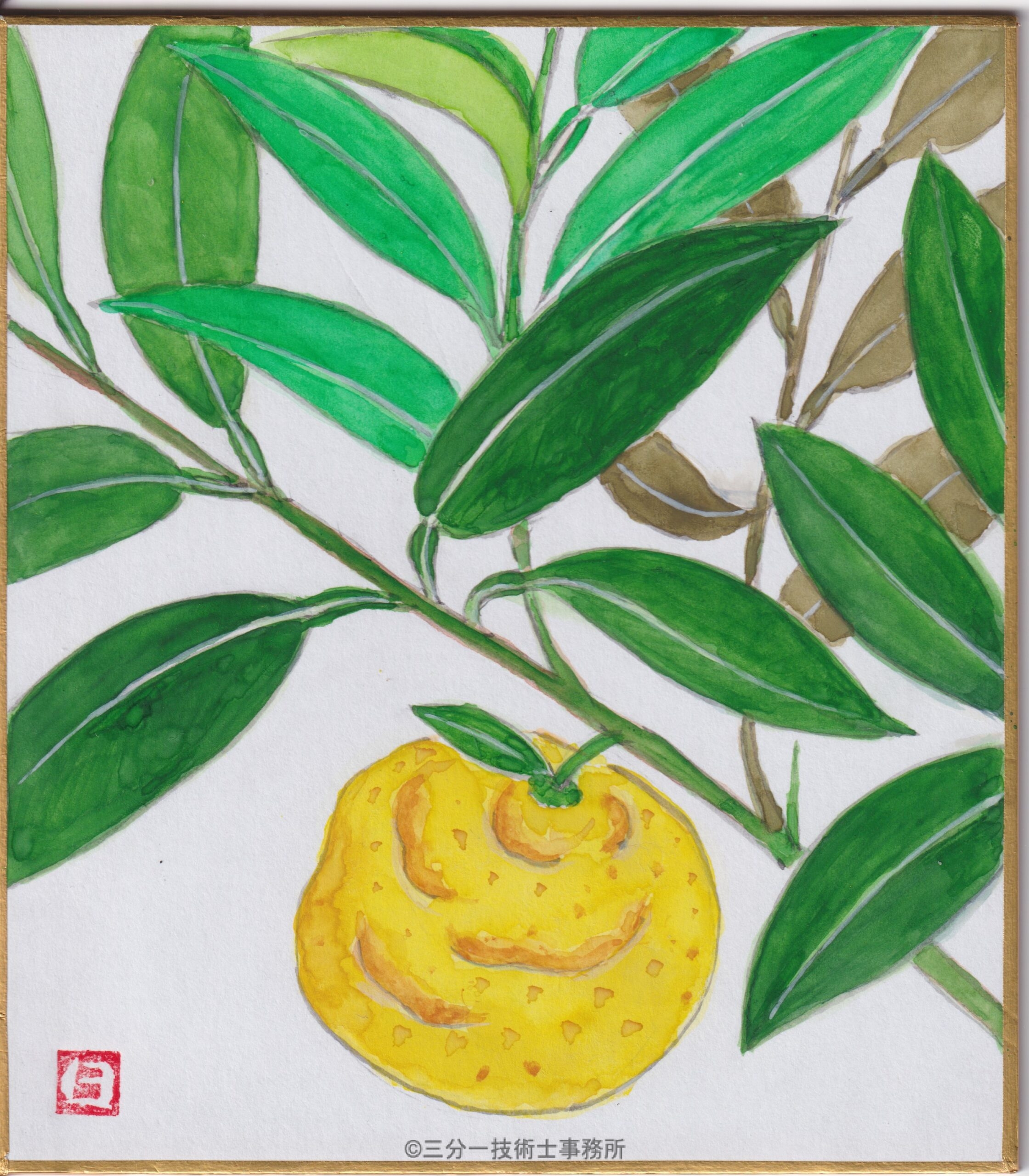
Sunsho-an Color Paper (1/4 size 136×120mm)
Murals of the Inner Sanctuary – Jifuku-ji Temple (October 2024)
Blooming lotuses and celestial maidens in flight. Heavenly flower petals drifting among the clouds, and a celestial maiden playing the ryūteki flute. October 25, Reiwa 6
Right wall of the inner sanctuary – Floating petals in the clouds

Left wall – Celestial maiden playing the ryūteki flute

All six murals connect together like a continuous scroll.

You can also view them from this page.
Ginkgo Tree and Nuts – October 2024
The ginkgo is called a “living fossil,” having survived for over 100
million years. The kanji 公孫樹 literally means “grandfather-grandchild tree” — it bears fruit only decades after being planted, hence the generational link. In autumn, ginkgo leaves shine in golden hues. Breaking open a ginkgo nut reveals a jade-green seed – slightly bitter, yet delicious. Ginkgo trees have been considered auspicious since ancient times.
October 12, Reiwa 6
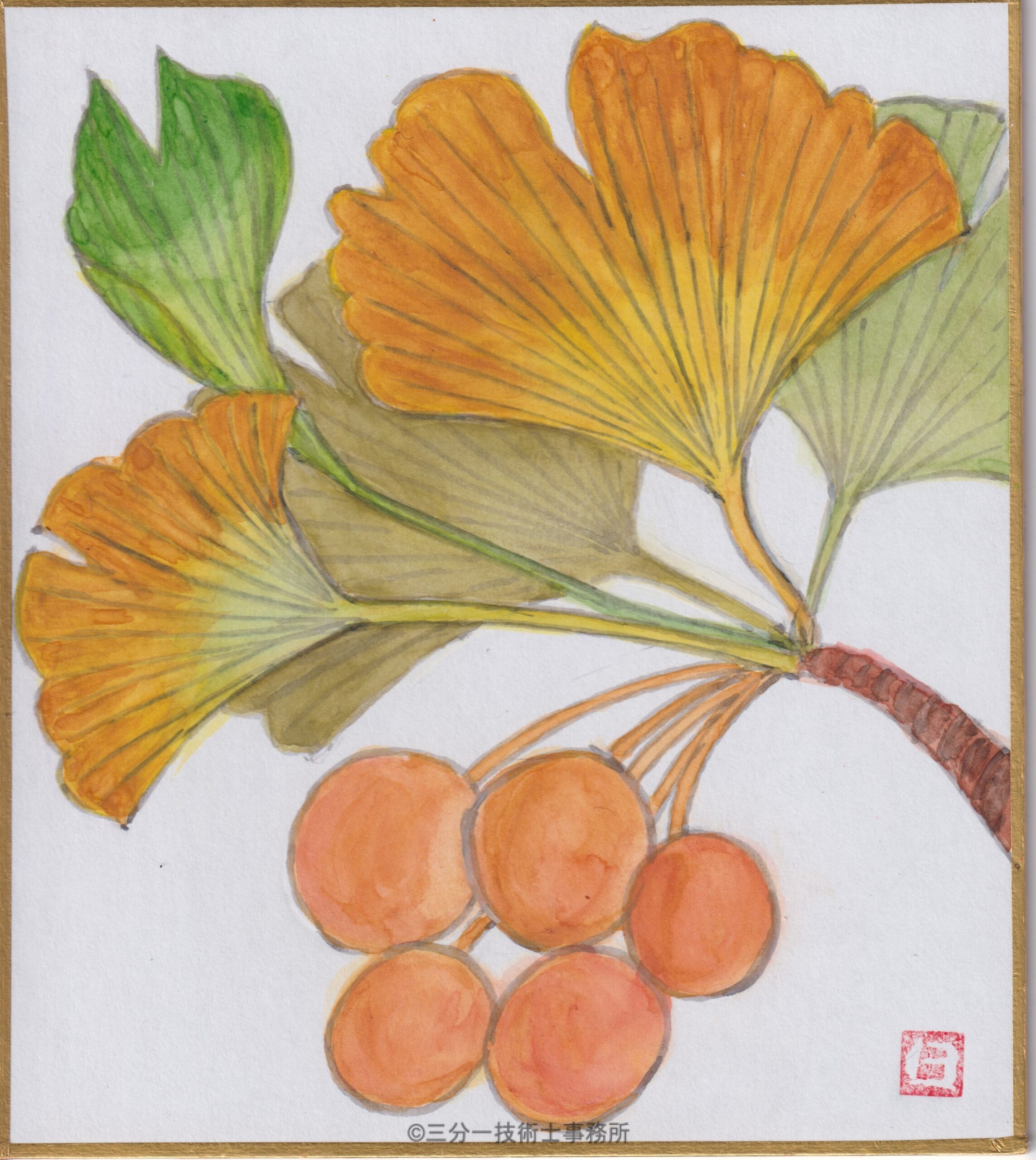
Sunsho-an Color Paper (1/4 size 136×120mm)
Autumn Equinox – Red Spider Lily (September 2024)
The red spider lily’s Sanskrit name *manjusaka* appears in Buddhist scriptures and is written in kanji as 曼珠沙華 (*manjushage*), meaning “heavenly flower.” It is said to bloom from the heavens as a sign of auspicious events. These flowers bloom around the autumn equinox and mark the beginning of long autumn nights.
September 5, Reiwa 6
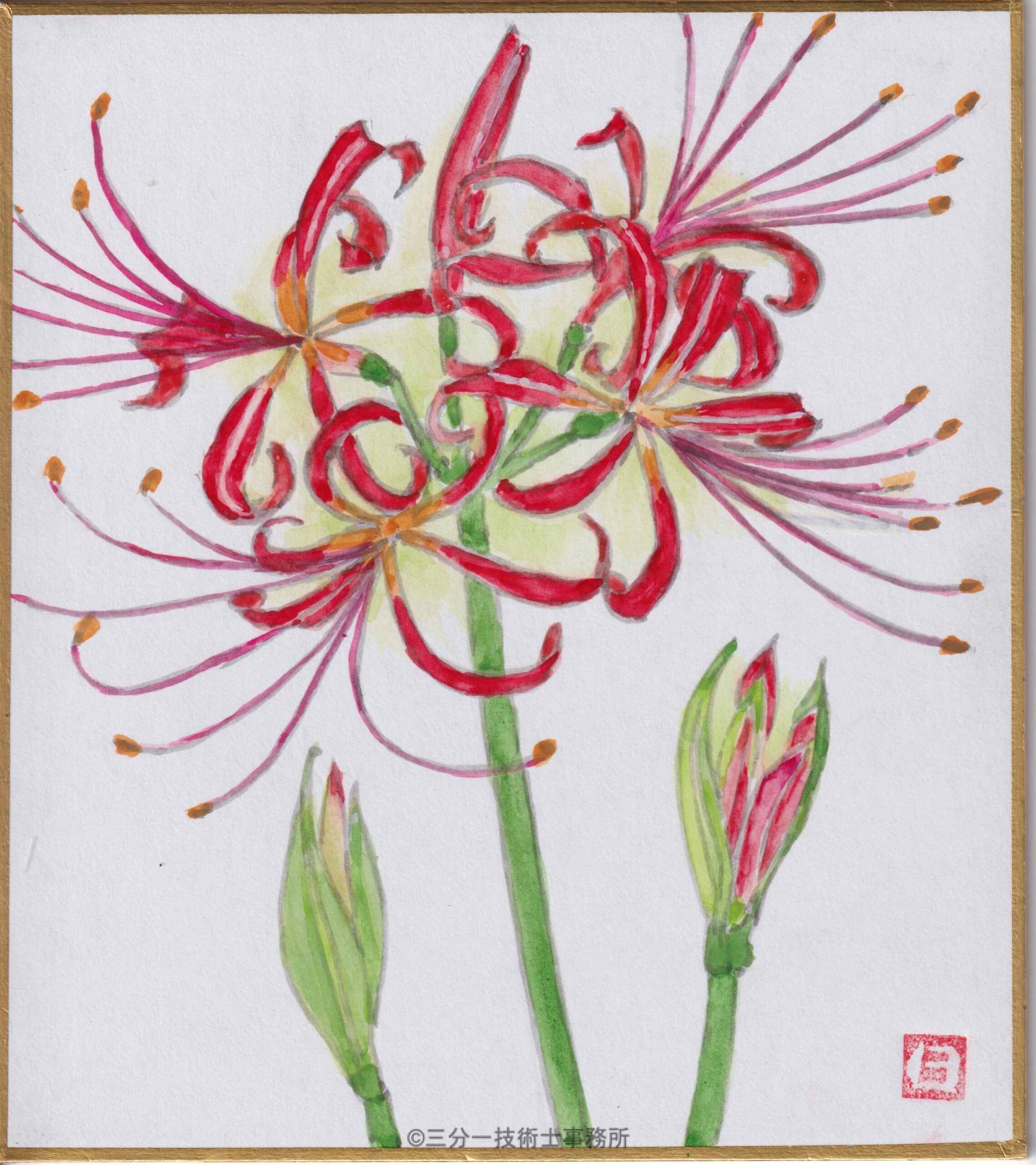
Sunsho-an Color Paper (1/4 size 136×120mm)
Grain Ripens – Rice Ears (August 2024)
The character 禾 (*nogi*) refers to grain crops like rice, wheat, and millet. 登 means “to ripen.” Around 210 days after the start of spring, during the rainy season, communities across Japan hold wind festivals to pray for calm weather and abundant harvests. In Etchu (modern-day Toyama), the *Owara Kaze no Bon* festival features dancers moving to the sound of kokyū (Japanese fiddle) music.
August 15, Reiwa 6
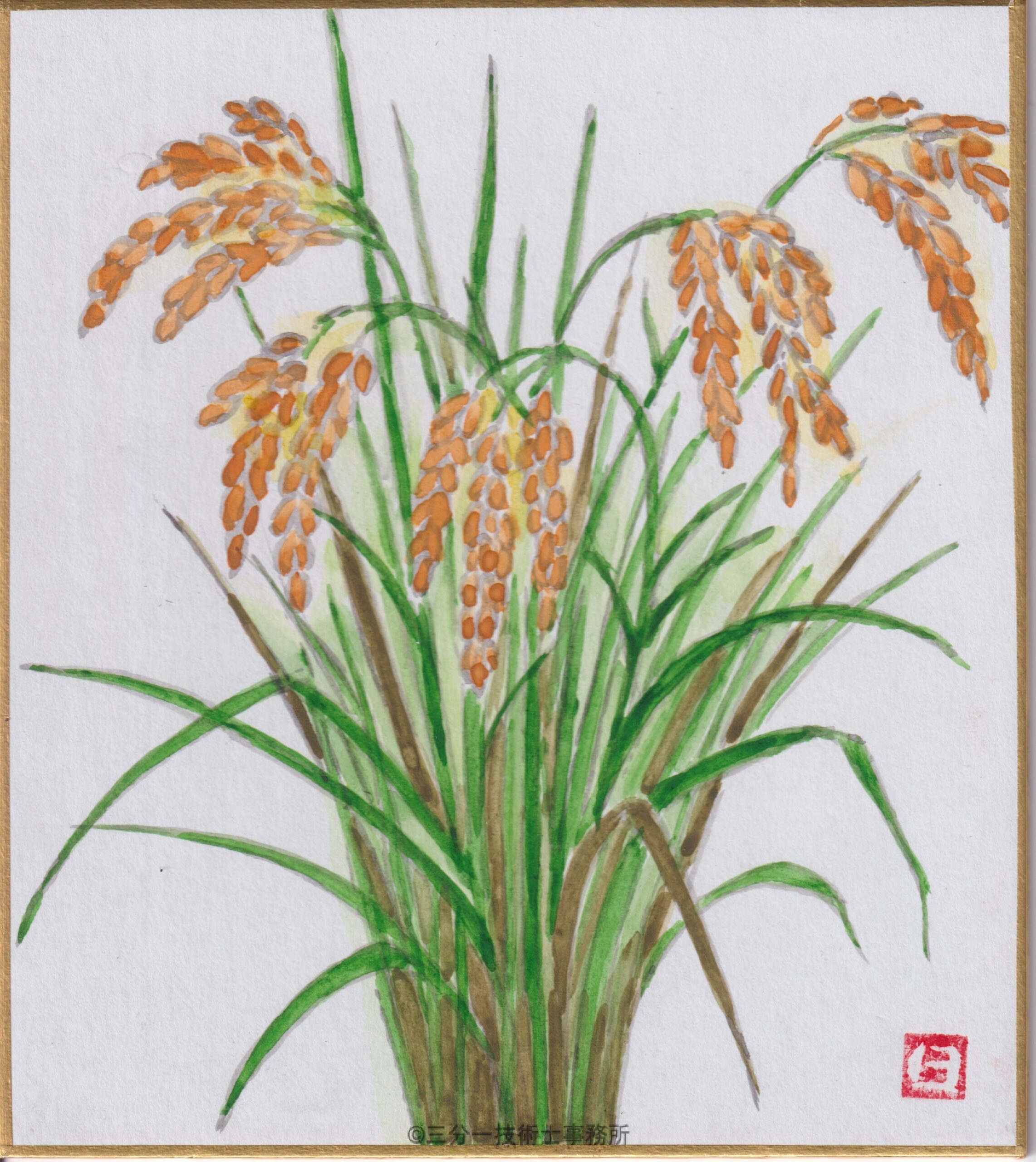
Sunsho-an Color Paper (1/4 size 136×120mm)
Damp Earth and Heavy Heat – July 2024
Passionflowers, now popular as green curtain plants, belong to the same family as passionfruit. In the stifling midsummer heat, people of the past used wisdom like cold baths and sprinkling water to cool down. Even summer banquets to ward off heat were a joy unique to the season. After the “Great Heat” (Taisho), the Buddhist Obon season begins — marking the start of autumn on the calendar.
July 10, Reiwa 6
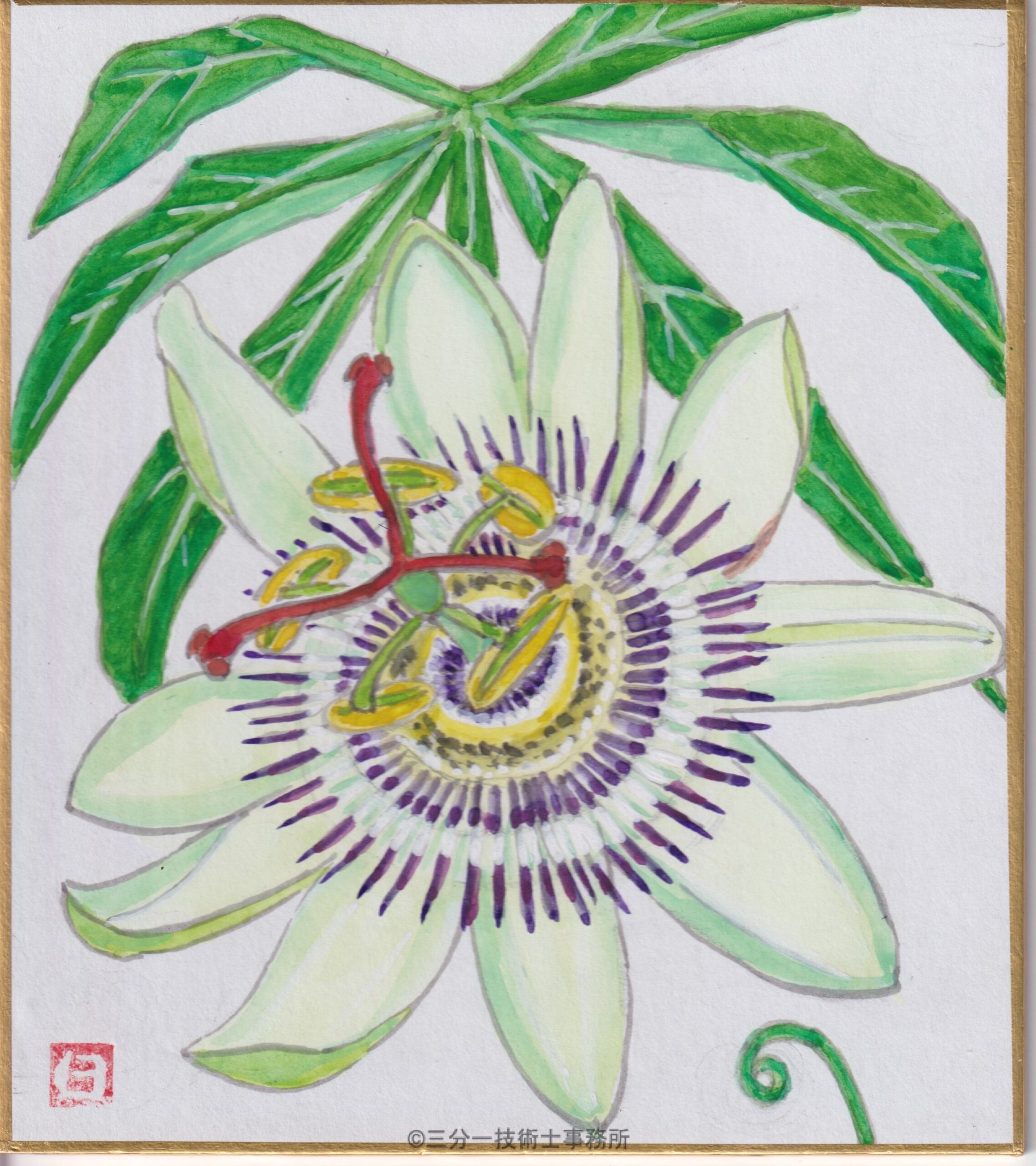 Sunsho-an Color Paper (1/4 size 136×120mm)
Sunsho-an Color Paper (1/4 size 136×120mm)
Summer Festival – July 2024
One lantern (consisting of four panels)
July 6, Reiwa 6
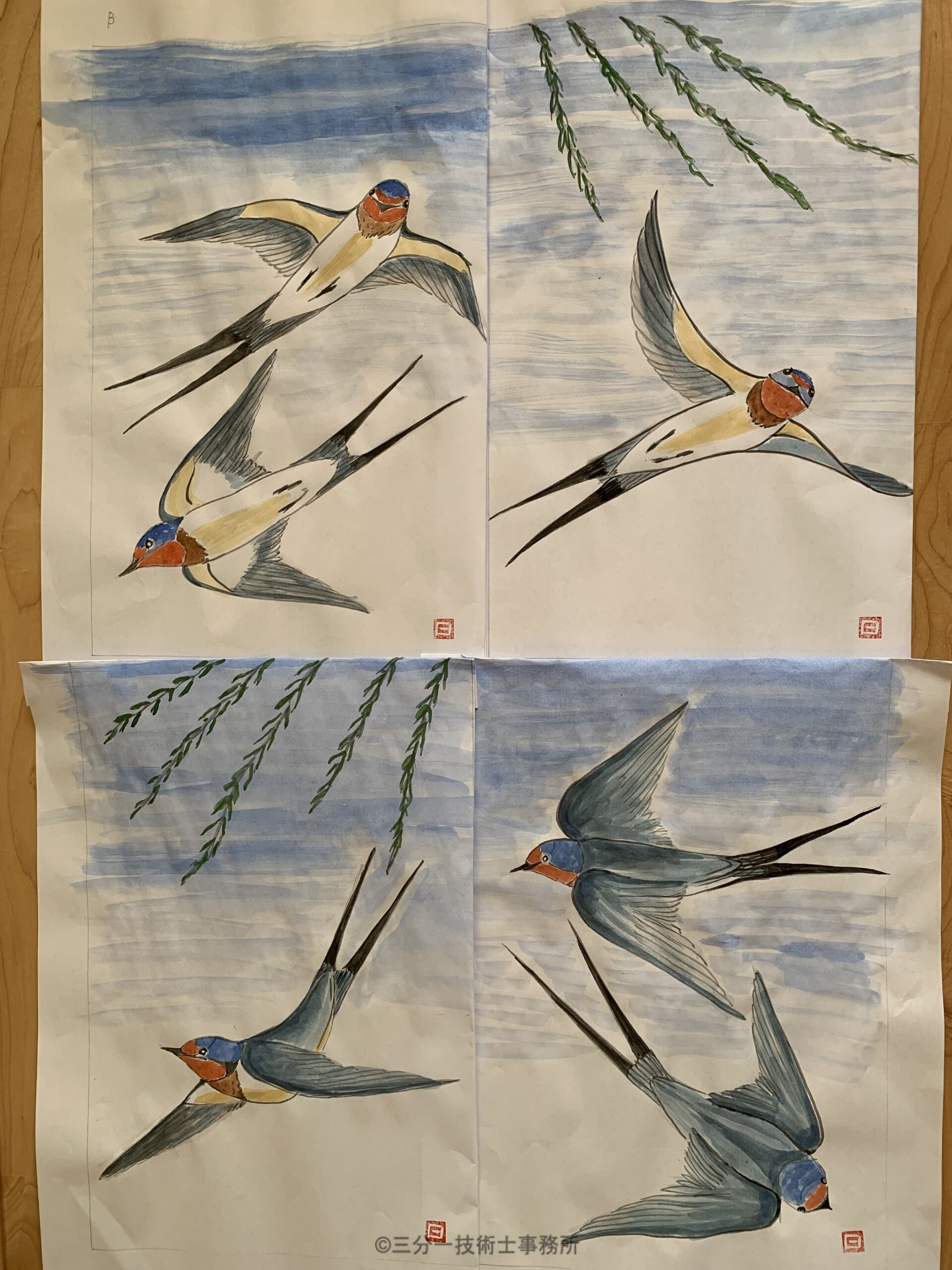
Willow and Swallow Design
First Lotus Blooms – Lotus Flower (June 2024)
Lotus flowers came to Japan along with Buddhism. The name *hasu* comes from *hachisu*, referring to the lotus seedpod resembling a honeycomb. The season *“Hasu hajimete hiraku”* marks the time of year when lotus blooms first open — around Obon in the modern calendar. They bloom at dawn and close past noon, each flower lasting about four days. There is a saying, “Born from mud, yet unstained by it.
June 13, Reiwa 6
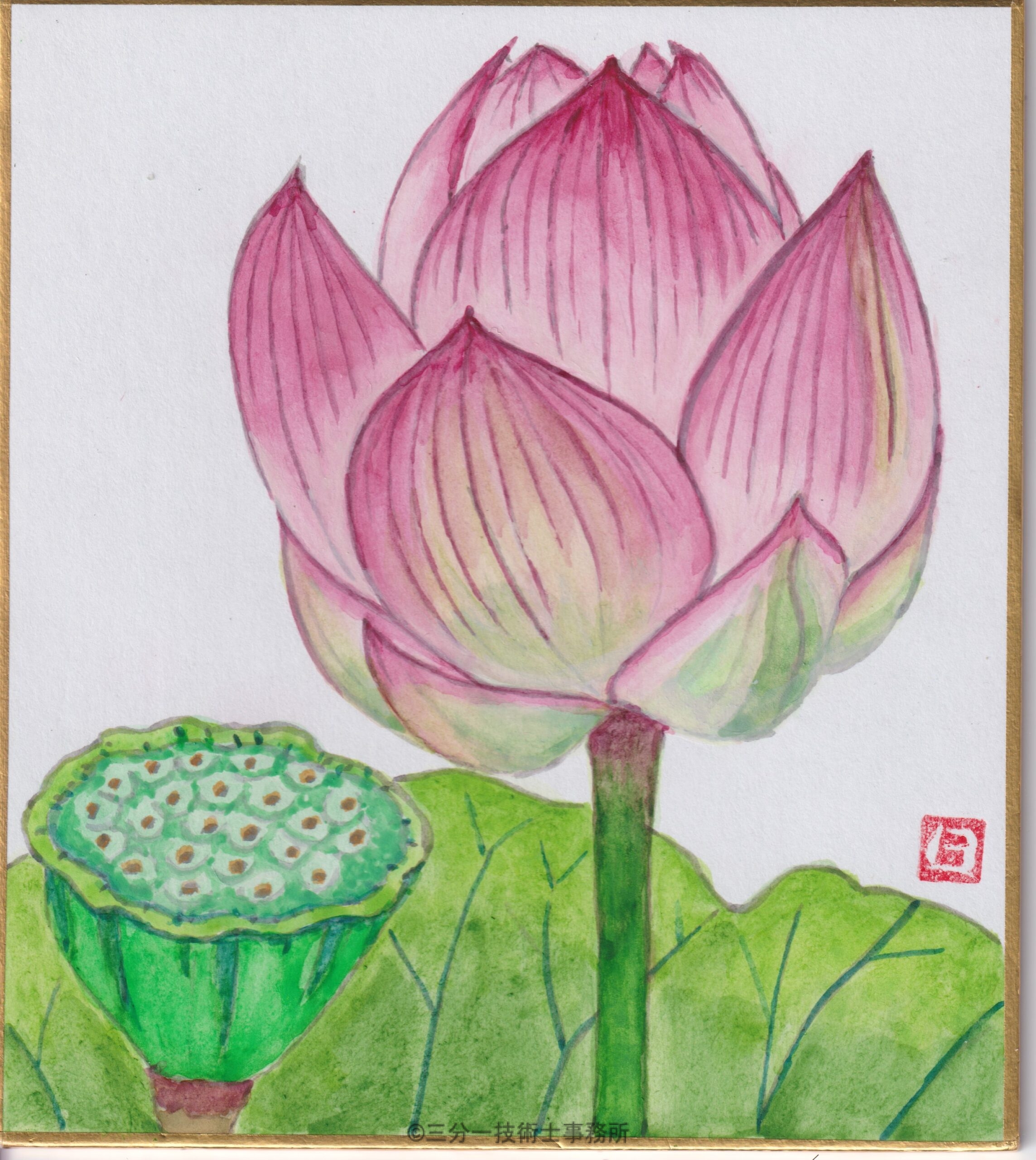
Sunsho-an Color Paper (1/4 size 136×120mm)
Minazuki – Hydrangea in Full Bloom (May 2024)
The name *Minazuki* (literally “Month of No Water”) ironically refers to the time when water is poured into rice fields. In ancient times, it was called the “Month of Water” or *Mizuharizuki* (Water-Filling Month). This name reflects the prayers for a good harvest. During this watery month, hydrangeas also bloom fully, nourished by the abundant rain.
May 14, Reiwa 6
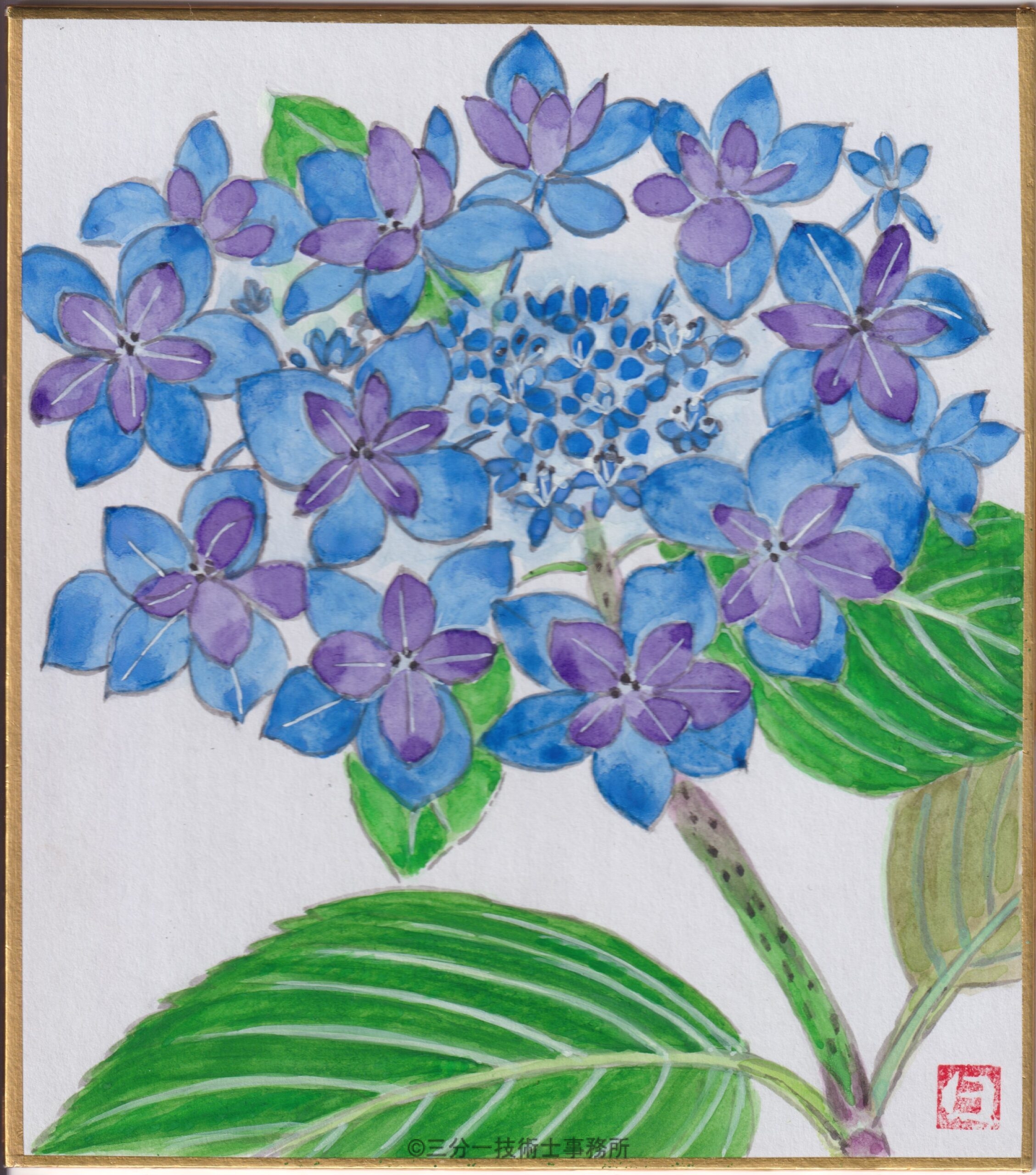
Sun Matsuan Color Paper (1/4 size 136×120mm)
Mural Painting in the Main Hall of the Temple
A 400-year-old temple on the Boso Peninsula in Chiba Prefecture was devastated by a severe typhoon in the autumn of the first year of Reiwa. Through the tireless efforts of many people, it has been newly rebuilt. I am fortunate to have the opportunity to contribute a mural painting for the interior of the main hall, which is currently in progress.
Hidemi
May 10, Reiwa 6
Early Summer: The Iris Painting 2024.4
During the early summer season, people are delighted by the sight of leafy irises and blooming irises.
Leafy iris, known as “
The identification of Iridaceae family is determined by the pattern at the base of the flower: if it’s a net-like pattern, it’s called “
April 17, Reiwa 6 (2024)
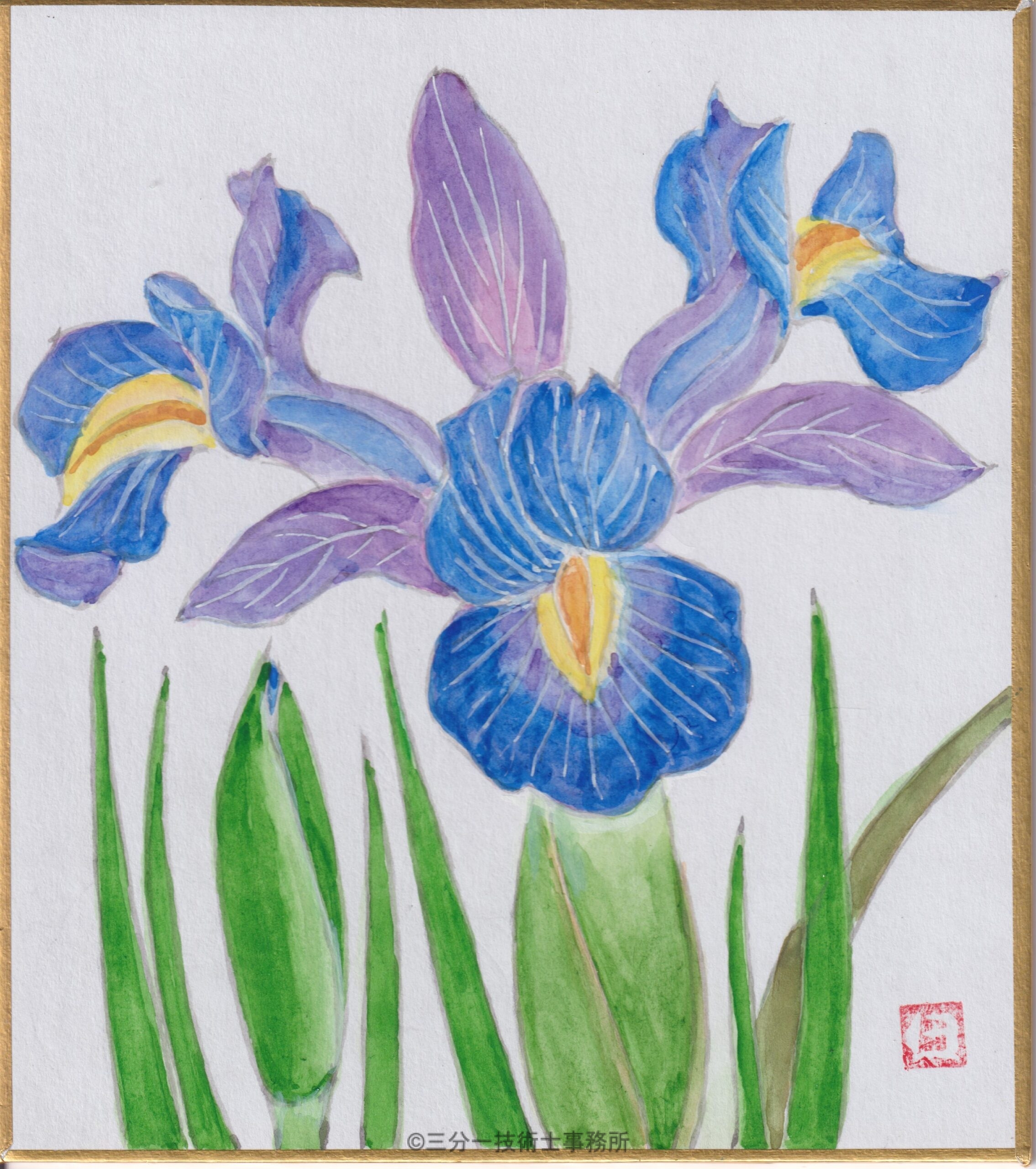
Sunsho-an Color Paper (1/4 size 136×120mm)
Spring: Cherry Blossoms and Japanese White-eye, March 2024
The origin of the word “spring” comes from the time when all things “sprout,” including the buds of plants “stretching,” the weather “clearing,” and fields being “cultivated.” Spring is the season that the Japanese, who love cherry blossom viewing, have always eagerly awaited for the full bloom of cherry blossoms. Wildlife and nature also become more radiant.
March 15, Year of Reiwa 6 (2024)
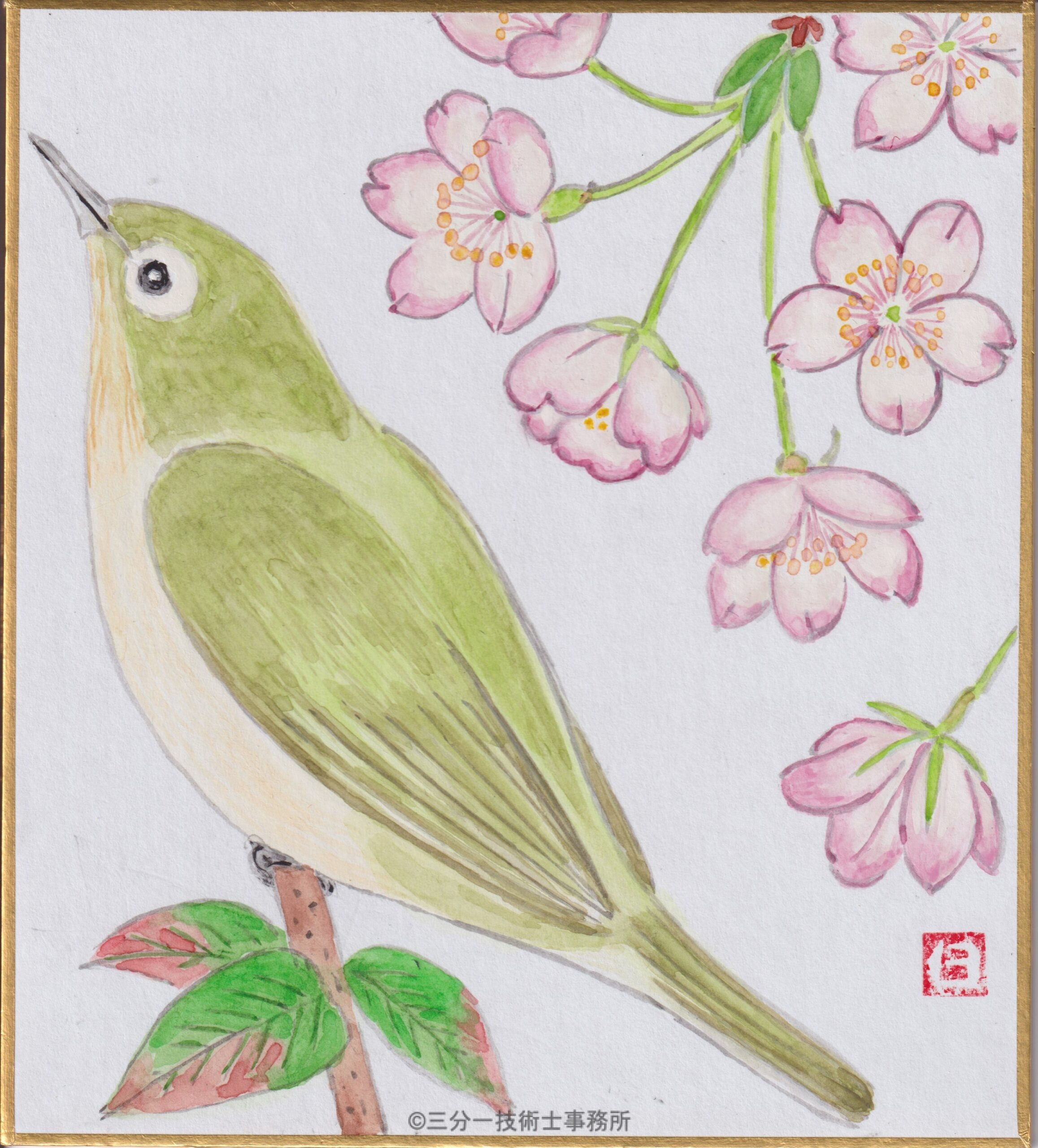
Sunsho-an Color Paper (1/4 size 136×120mm)
Japanese Daffodil, Flower in the Snow 2024.1
The name “daffodil” originated in China, but as it adapted well to the Japanese climate, it became known as the “Japanese daffodil.” It is also called “flower in the snow” because it blooms amidst the harsh cold of winter. As a cut flower, it lasts well, so it is often used in “Kakubana” for tea ceremonies and Ikebana. It is also brought into tea houses as a tea flower.
January 17, 2024, Reiwa 6.
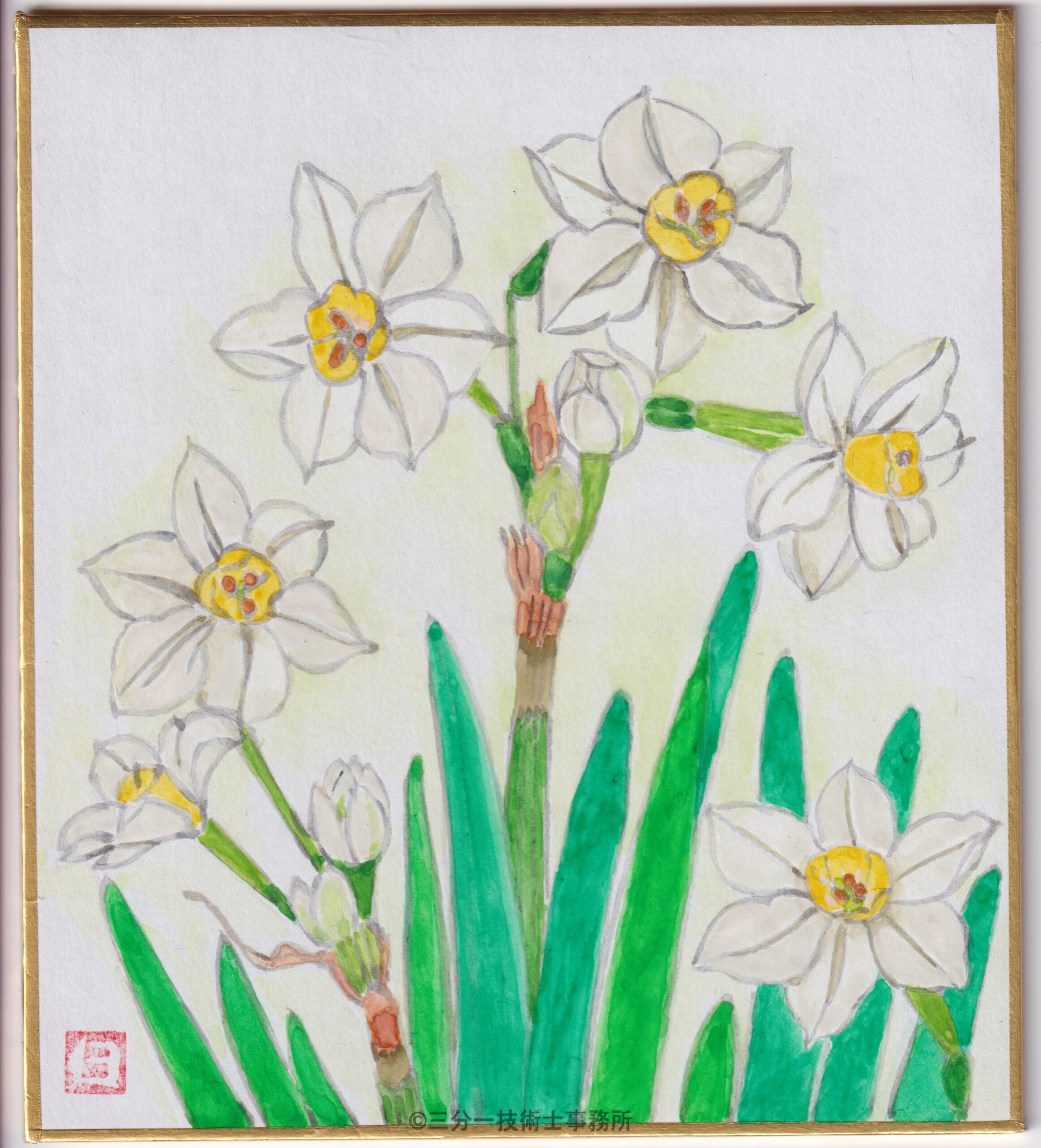
Sunsho-an Color Paper (1/4 size 136×120mm)
Year of the Dragon: Wishing for Good Fortune in the New Year 2024.1
The Dragon God is believed to dwell in water, fly through the sky, create clouds, and summon rain with its spiritual power. The jewel possessed by the dragon, known as “Ruyi’s Precious Pearl,” is said to attract good fortune and ward off disasters. I pray that this year brings you health and happiness.
New Year’s Day, Reiwa 6 (2024)
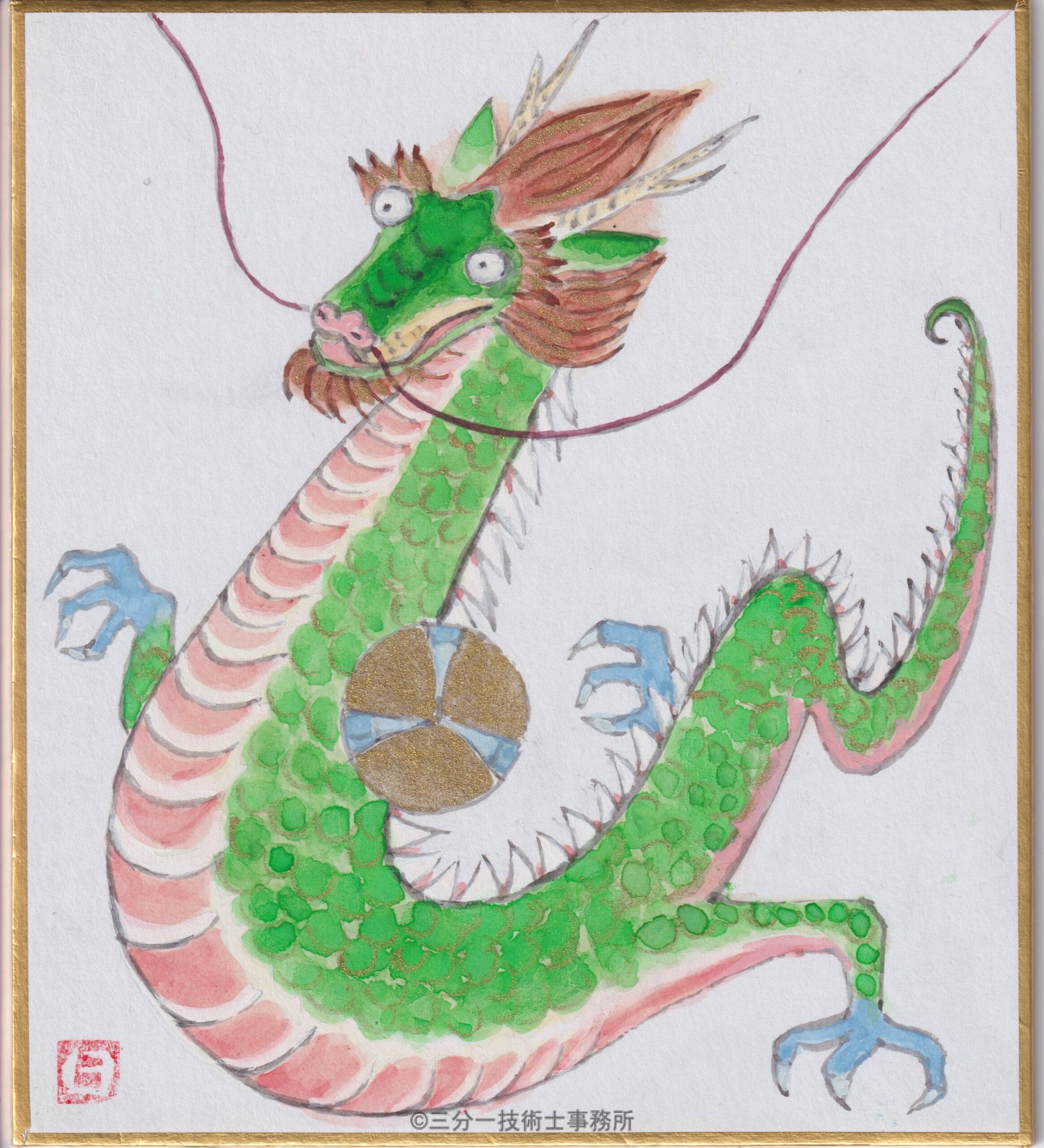
Sunsho-an Color Paper (1/4 size 136×120mm)
Camellia of the Queen Mother of the West (Seiōbo) 2023.11
The camellia of the Queen Mother of the West is cherished as a garden plant from late autumn to the onset of winter. The shape of its buds is plump and pale, earning it the nickname ‘peach’. It is said to have originated from China, where peaches are believed to ward off evil spirits. In the Japanese tea ceremony, during the opening of the hearth (robiraki), it is brought in as a tea flower.
November 15, reiwa 5
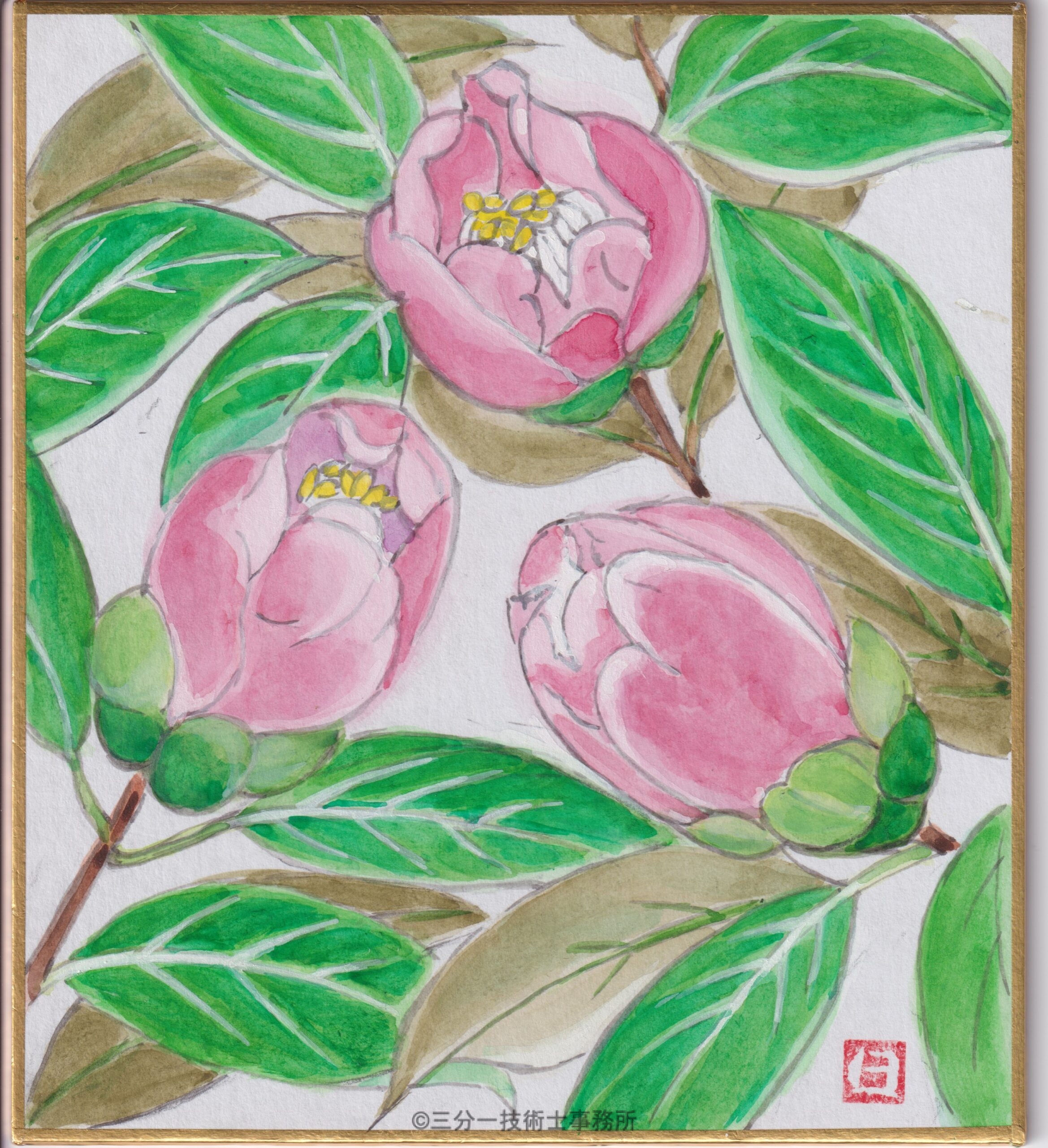
Sunsho-an Color Paper (1/4 size 136×120mm)
Grass Maple and Crow Gourd Illustration 2023.10
As autumn deepens, a warmly colored landscape emerges.
People in ancient times enjoyed the changing colors of grass leaves turning red and yellow, calling it “grass maple.”
Among them, the fruit of the crow gourd turns red, its seeds are pitch black, shaped like a mallet, and are considered a lucky charm, often referred to as “Daikokuten”.
October 7, Reiwa 5
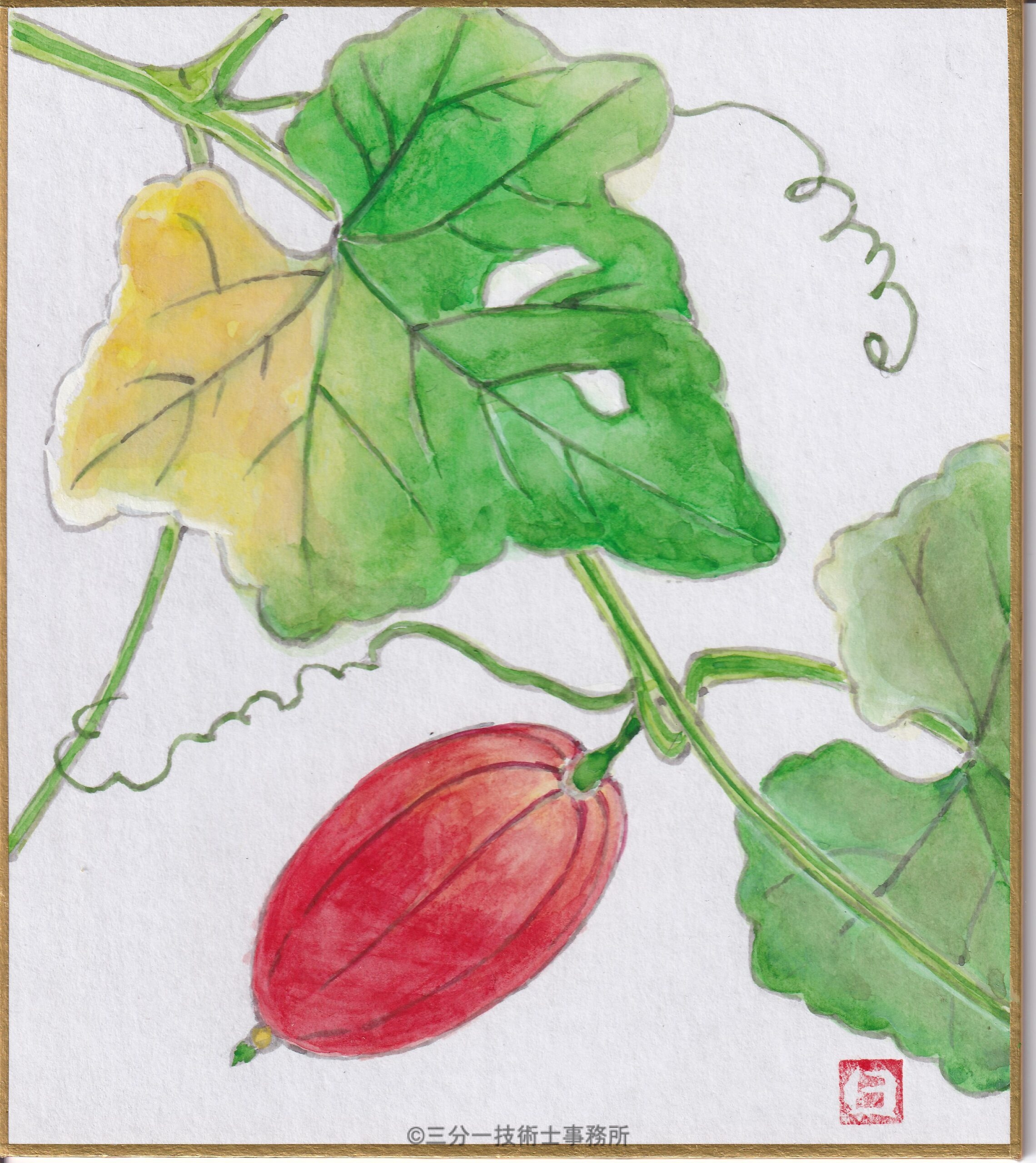
Sunsho-an Color Paper (1/4 size 136×120mm)
Bell Crickets: Suzumushi on Kudzu, September 2023
In the fields, the chirping of insects tells us of the deepening autumn. The wings of bell crickets, thin yet sturdy, are used to create sound by rubbing them together like ringing a bell; they cannot use them to fly. For this reason, the Japanese have long considered the sound of bell crickets as elegant and refined.
September 6, Reiwa 5 (2023)
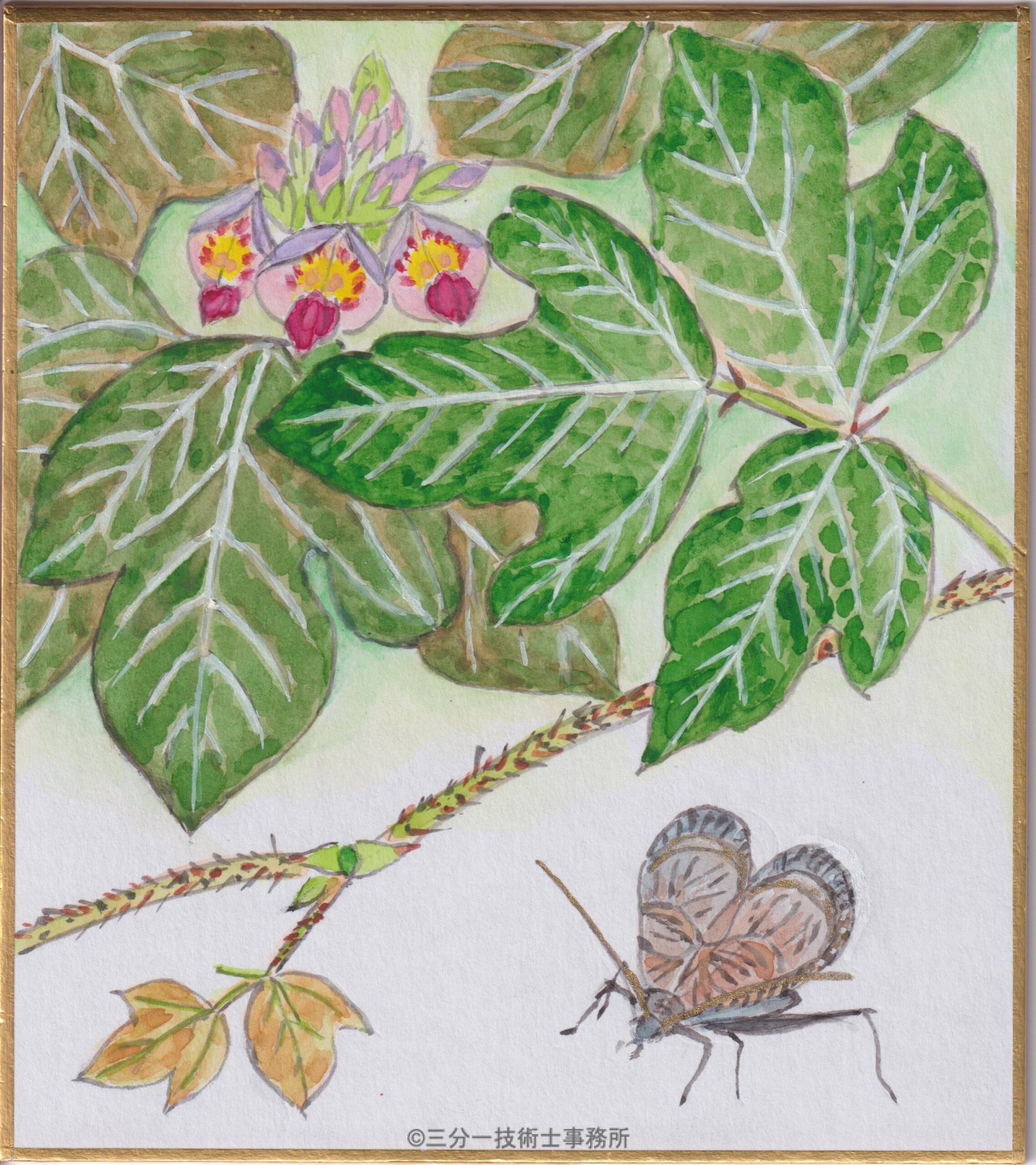
Sunsho-an Color Paper (1/4 size 136×120mm)
Silver Grass – Autumn’s Seven Herbs “Tail Flower” August 2023
Autumn’s seven herbs are for visual delight.
It all began with the poem from Manyoshu by Yamano Okura, which reads, “Flowers that bloom in the autumn fields…”
The origin of the name “Silver Grass” comes from the Japanese reading
It’s also named “Tail Flower” because it resembles an animal’s tail.
This large wild grass is used for thatched roofing.
Date: 8th August, Reiwa 5 (2023)
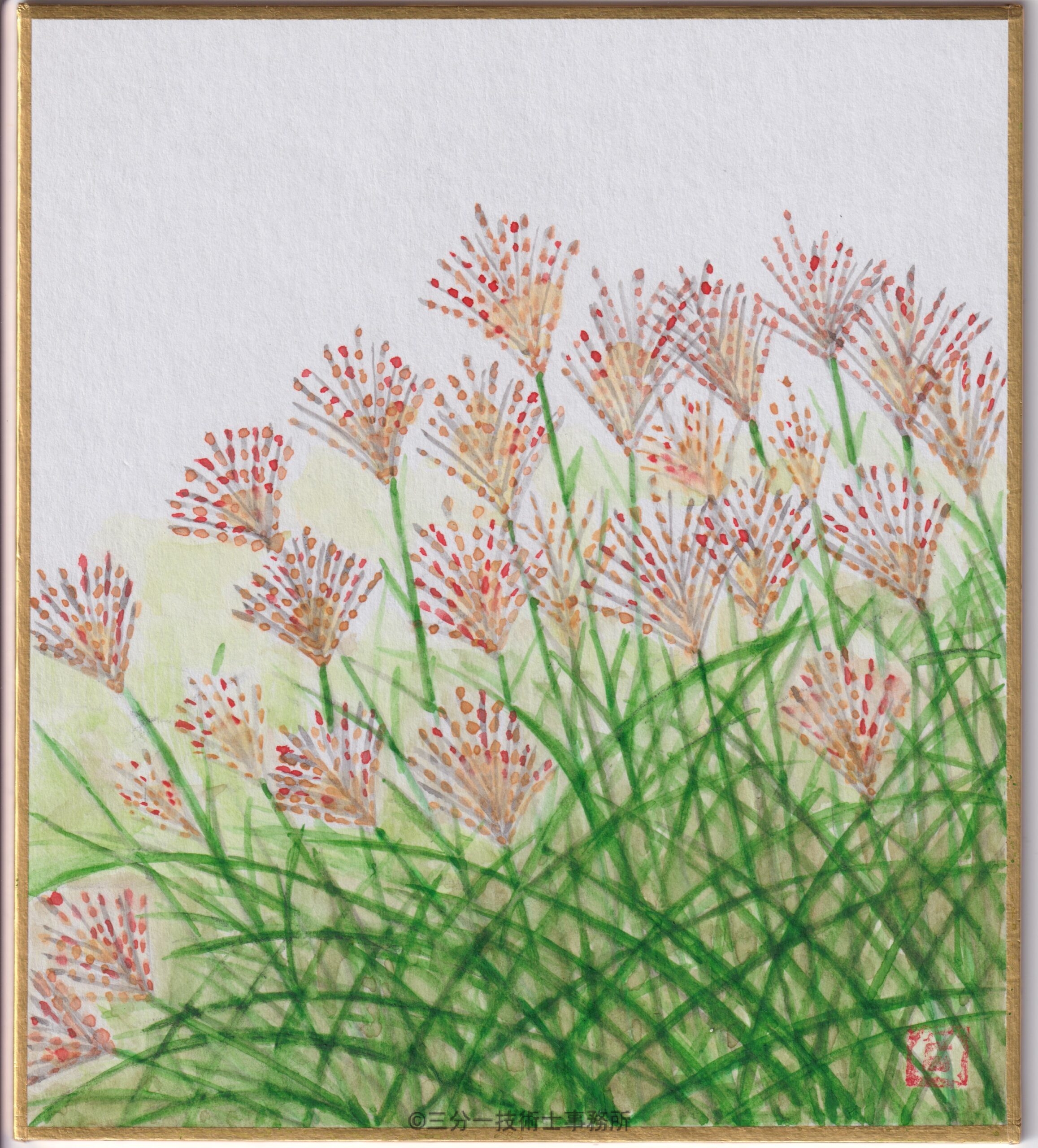
Sunsho-an Color Paper (1/4 size 136×120mm)
Morning Glory July 2023
The petals of the Morning Glory come together to form five funnel-shaped pieces. Its
The original species of Morning Glory had blue flowers, but during the Edo period, it underwent active breeding for ornamental purposes.
It can be described as a plant that embodies the coolness of summer.
Date: 8th July, Reiwa 5 (2023)
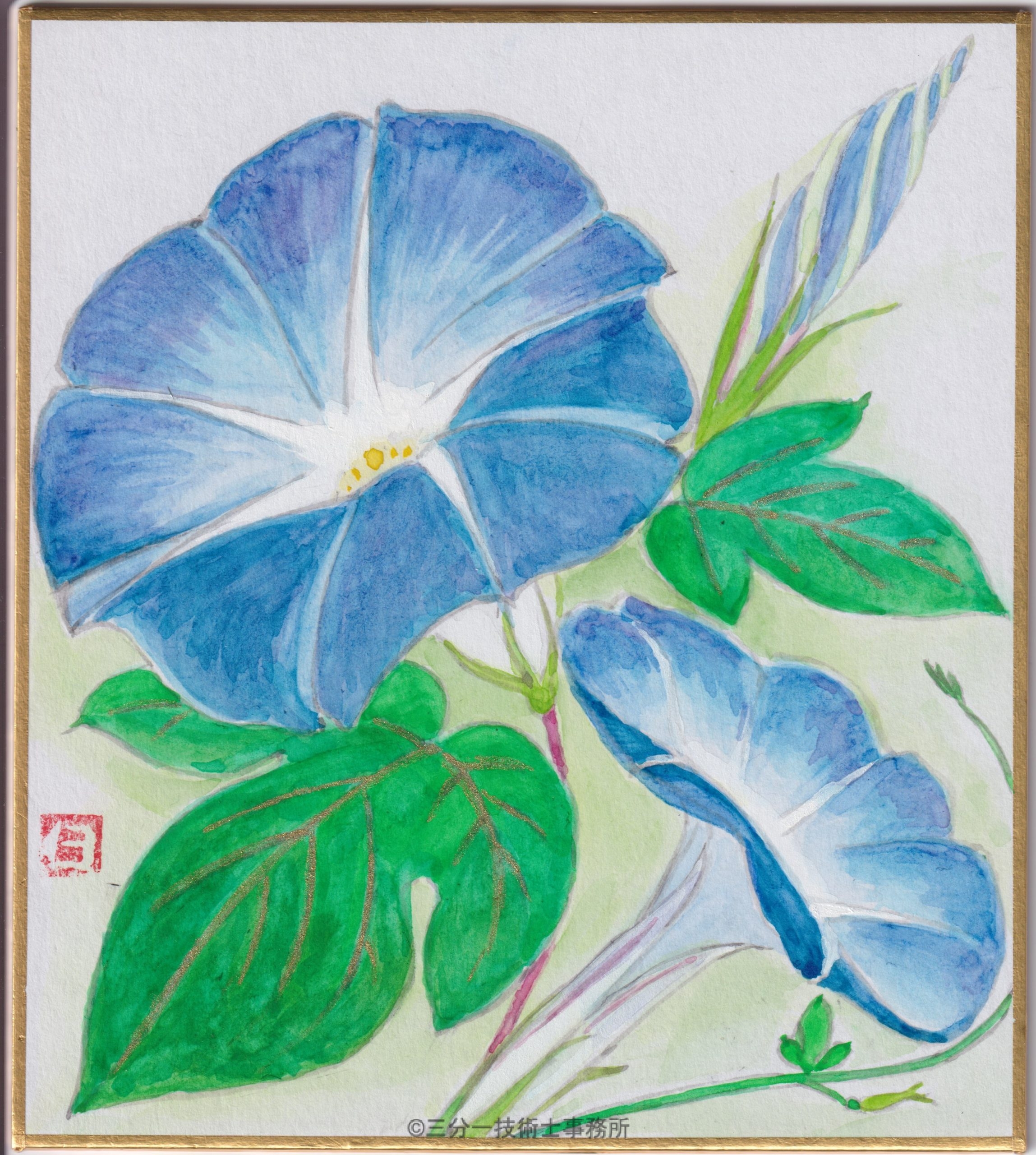
Sunsho-an Color Paper (1/4 size 136×120mm)
Frog – Illustration of Frog on a Lotus June 2023
In Japan, a country of “kotodama” (the spirit of words), there’s a play on words embedded in “
That is, “kaeru” can mean “to return” or “to come back”.
It can refer to “young frogs coming back”, “money returning”, or “returning safely”.
As a creature of good fortune, it’s also believed that the frog only jumps forward, transforming misfortunes into blessings.
Date: 6th June, Reiwa 5 (2023)
Note: The concept of “kotodama” refers to the traditional belief in the Japanese culture that words have spiritual power. The pun with “kaeru” is that the word for “frog” sounds like the verb “to return”.
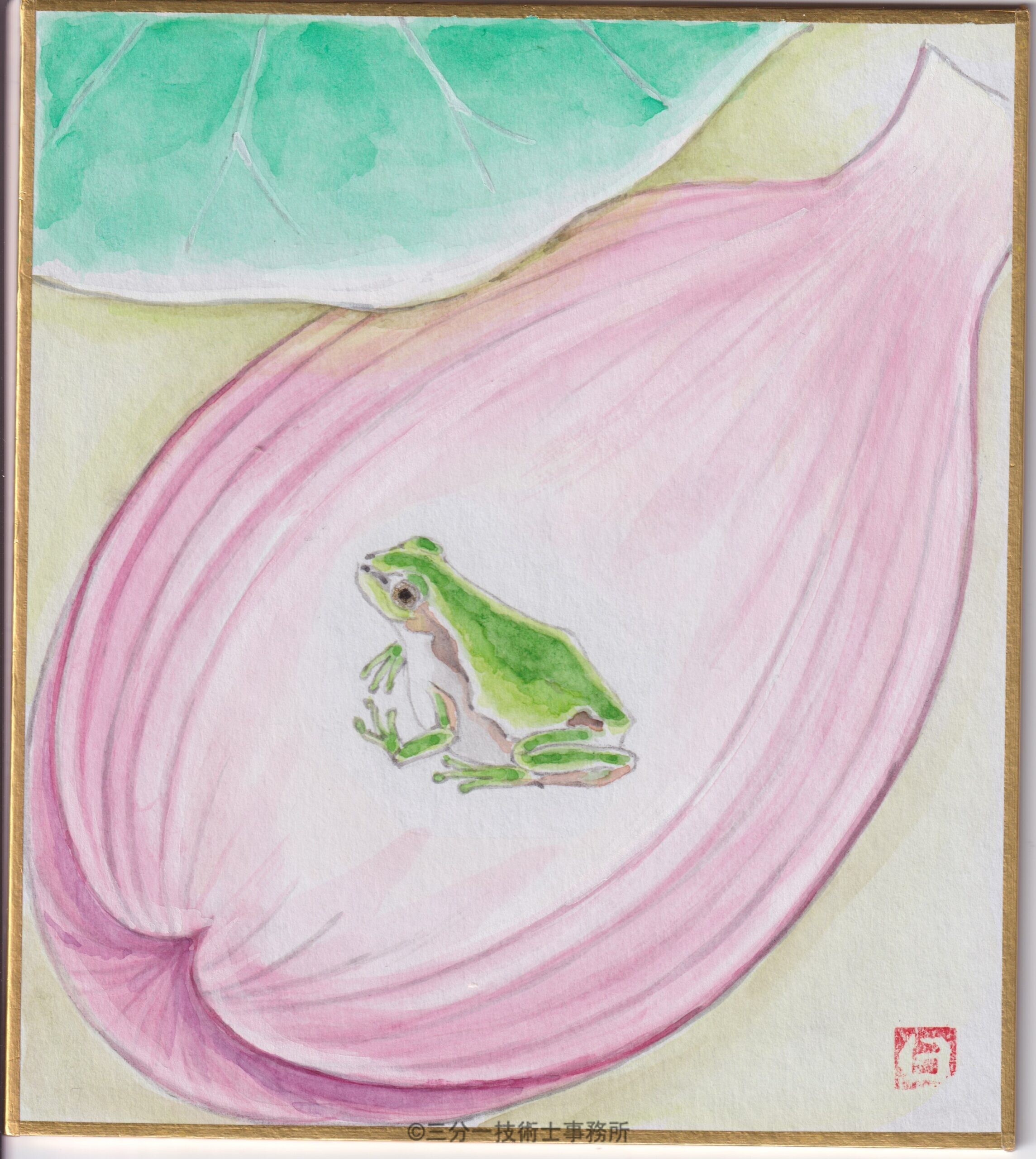 Sunsho-an Color Paper (1/4 size 136×120mm)
Sunsho-an Color Paper (1/4 size 136×120mm)
Dewflower May 2023
The flower, which resembles a folded shell, shines with morning dew and blooms at sunrise, leading to its name “Dewflower”.
This small blue flower has long been used as a dye for the underpainting of traditional kimono tie-dyeing and Yuzen dyeing, hence it’s also called “
It’s additionally referred to as “Hat Flower”.
Due to the practice of rubbing the flower’s juice onto clothing as a dye, it’s also named “
Though it’s a common plant seen at the edges of fields or alongside roads, it has a rich backstory.
Date: 9th May, Reiwa 5 (2023)
Note: The Man’yoshu, mentioned in the translation, is the oldest existing collection of Japanese poetry.
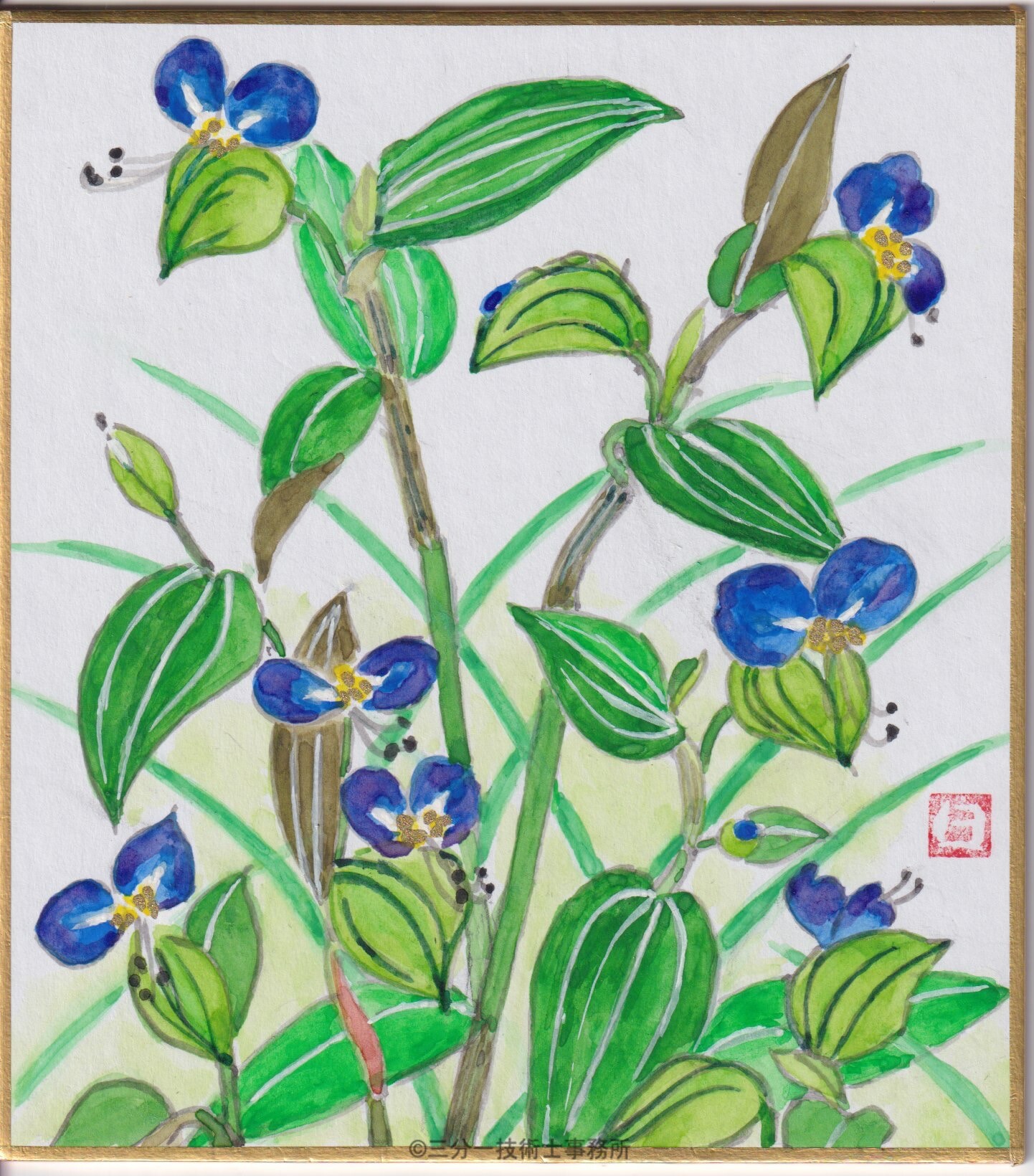
Sunsho-an Color Paper (1/4 size 136×120mm)
Wagtail April 2023
Primarily residing by the water, they can also be observed in urban areas.
They have a habit of wagging their long tails up and down, leading to the Japanese name “Ishitataki” and the English name “Wagtail”.
They feed on insects and earthworms. As they eat pests from the fields, they are regarded as beneficial birds.
They are wild birds actively present around people.
Date: 10th April, Reiwa 5 (2023)
Note: The bird “Wagtail” is known for its characteristic tail-wagging behavior, hence its name.
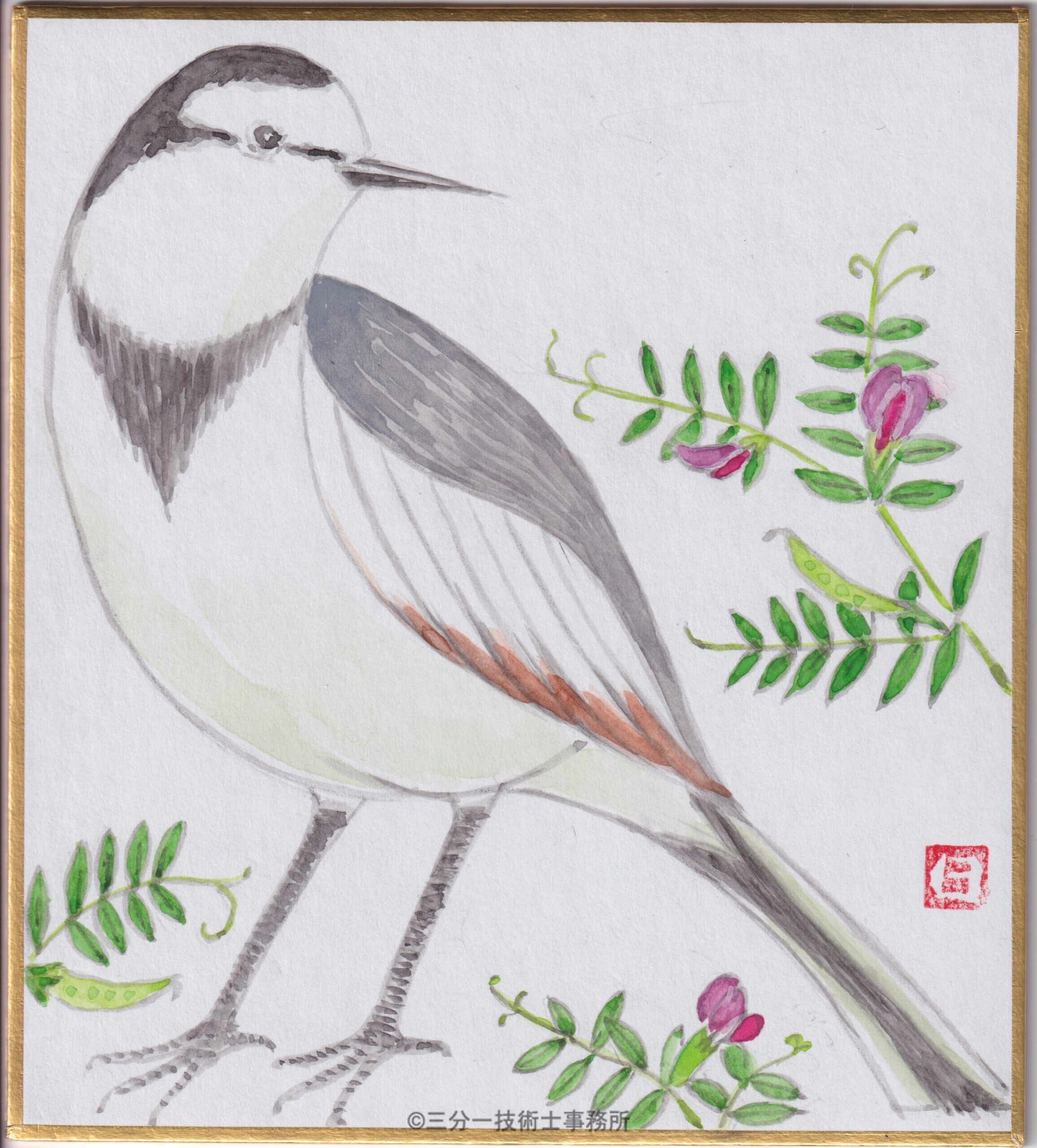 Sunsho-an Color Paper (1/4 size 136×120mm)
Sunsho-an Color Paper (1/4 size 136×120mm)
Yamazakura: The Land of Cherry Blossoms March 2023
From ancient times, the representative cherry blossom of Japan is the mountain cherry blossom.
In the spring, they grow wild in mountainous regions, blooming in white or pale pink, alongside their young leaves.
Known for their “rapid growth and strong regenerative power”, there are 10 or 11 native species.
The leaves of the “sakuramochi” are said to be from the Oshima cherry tree.
The heart is uplifted by the appreciation of the flowers.
Date: 15th March, Reiwa 5 (2023)
Note: Yamazakura is a specific type of cherry blossom native to Japan, commonly found in the mountains. Sakuramochi is a traditional Japanese confectionery wrapped in a pickled cherry leaf.
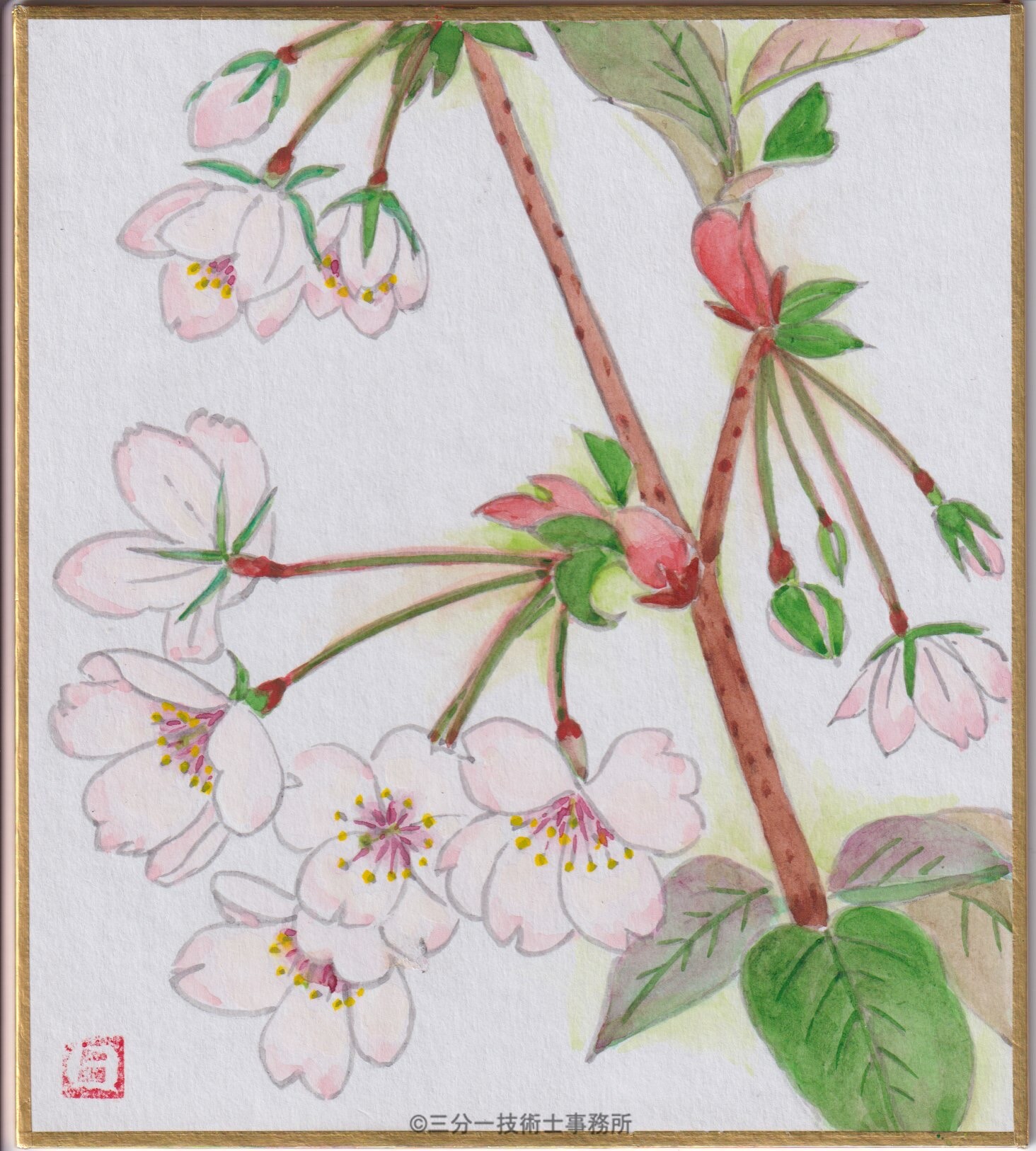 Sunsho-an Color Paper (1/4 size 136×120mm)
Sunsho-an Color Paper (1/4 size 136×120mm)
Rapeseed Blossoms February 2023
Rapeseed blossoms refer to the flowers produced by plants of the Brassica genus, such as rapeseeds, turnips, and komatsuna (Japanese mustard spinach).
The song “Oborozukiyo” (Hazy Moonlit Night) was selected as a primary school song in the third year of the Taisho era (1914).
It has been sung continuously for about a century.
Date: 8th February, Reiwa 5 (2023)
Note: “Oborozukiyo” is a famous traditional song in Japan. The relevance to rapeseed blossoms might be related to the song’s content or its association with the season in which rapeseed blossoms bloom.
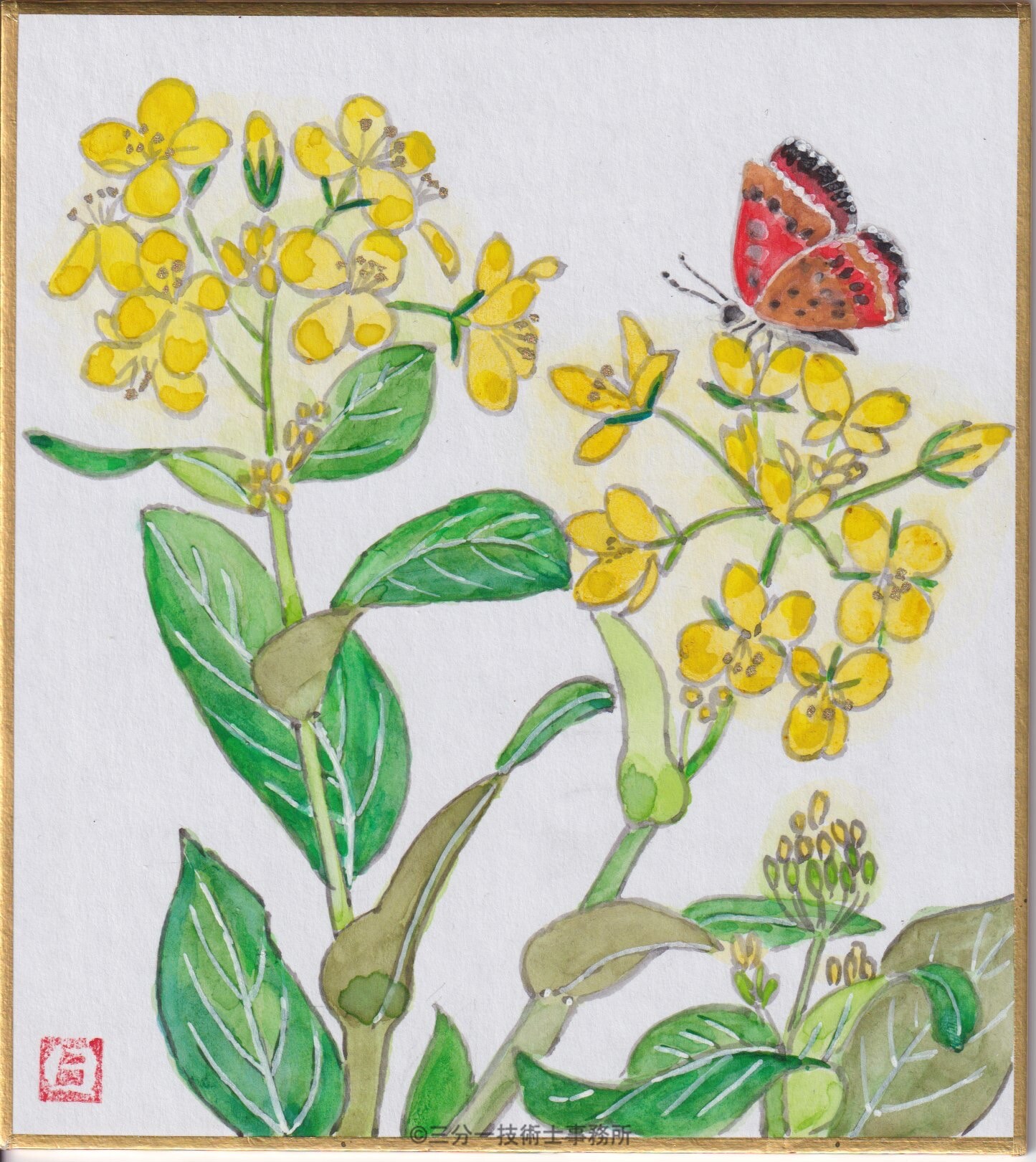 Sunsho-an Color Paper (1/4 size 136×120mm)
Sunsho-an Color Paper (1/4 size 136×120mm)
Kumazasa: A Japanese Specialty January 2023
Bamboo grass transforms into a vibrant green from spring to summer.
From autumn to winter, its leaves develop a whitish hue around the edges, as if they have been accentuated with makeup shading. This specific variety is known as “Kumazasa” (Sasa veitchii).
For reference, if the outer layer of the shoot falls off, it’s termed “bamboo,” but if the outer layer remains on the stem’s node, it’s called “bamboo grass.”
Date: 10th January, Reiwa 5 (2023)
Note: The term “Kumazasa” refers to a specific variety of bamboo grass native to Japan, which has a distinct appearance. The distinction between “bamboo” and “bamboo grass” in the provided text refers to the characteristics of their shoots.
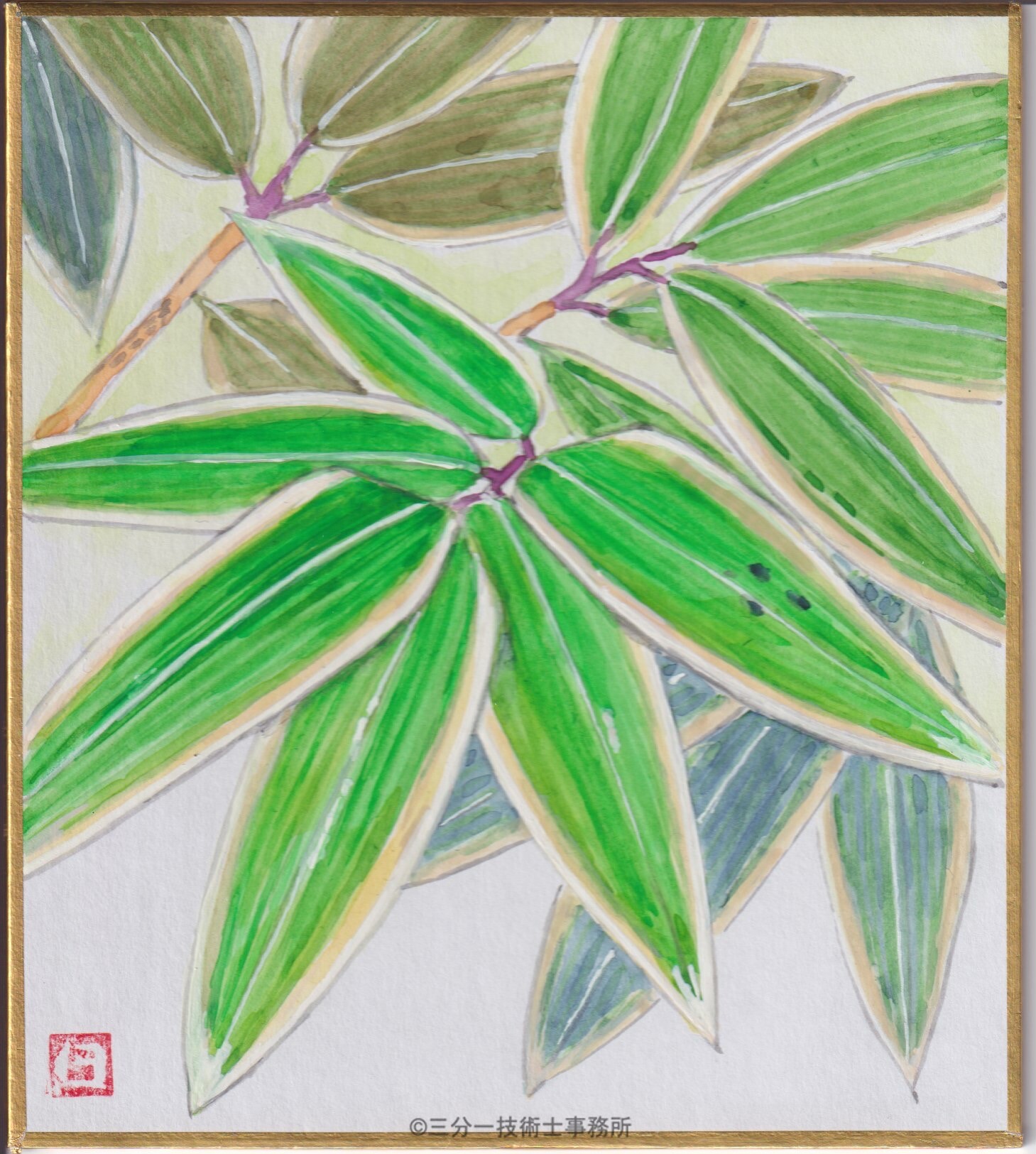 Sunsho-an Color Paper (1/4 size 136×120mm)
Sunsho-an Color Paper (1/4 size 136×120mm)
Year of the Rabbit: Wishing for Good Fortune in the New Year January 2023
The rabbit, with its long ears, is believed to gather good fortune. With its swift hind legs, it can hop away from calamities and negative energies.
Additionally, from old tales that say the rabbit lives on the moon, it is believed to bring in “fortune” (referring to the word “Tsuki”, which means moon in Japanese and plays as a pun here).
May this year bring you health and happiness. Our heartfelt prayers are with you.
Date: 1st January, Reiwa 5 (2023)
Note: In East Asian culture, there’s a common myth about a rabbit that lives on the moon, which the text references.)
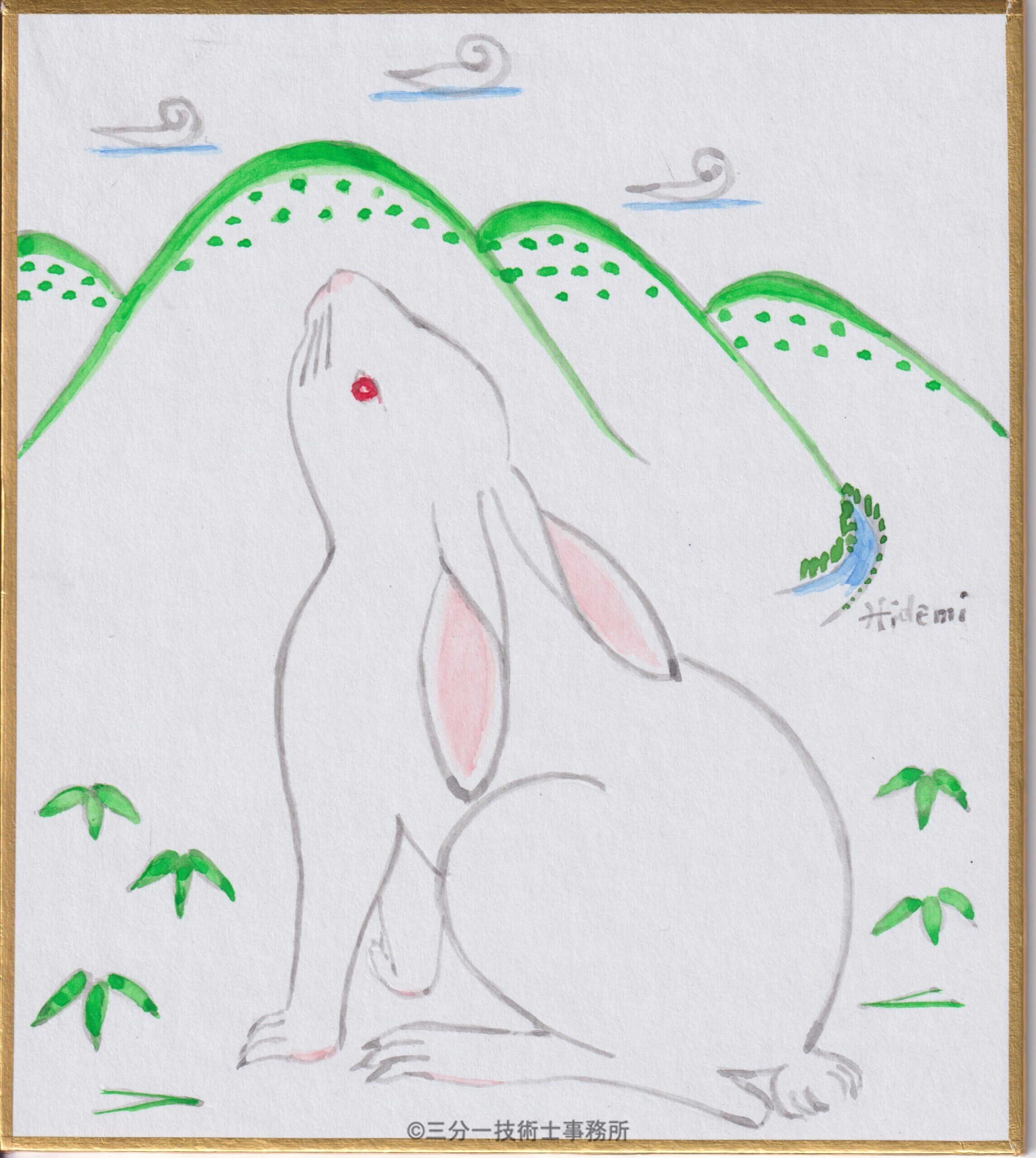 Sunsho-an Color Paper (1/4 size 136×120mm)
Sunsho-an Color Paper (1/4 size 136×120mm)
Japanese Gardenia Fruit – Gardenia jasminoides, November 2022
In the early winter garden, one can spot the orange fruit of the Japanese Gardenia.
Around June, it blooms fragrant white flowers which then form into fruits.
The dried fruit is called “Gardenia jasminoides” and is used in traditional Chinese medicine as well as a natural dye for foods.
A natural blessing that dyes chestnuts, mashed sweet potatoes, and pickled daikon radish into a golden hue.
Date: 4th November, Reiwa 4 (2022)
Note: The Japanese name for Gardenia jasminoides is “kuchinashi,” and “san-shi-shi” is another name for it. The fruit is traditionally used as a yellow dye for various food items in Japan.
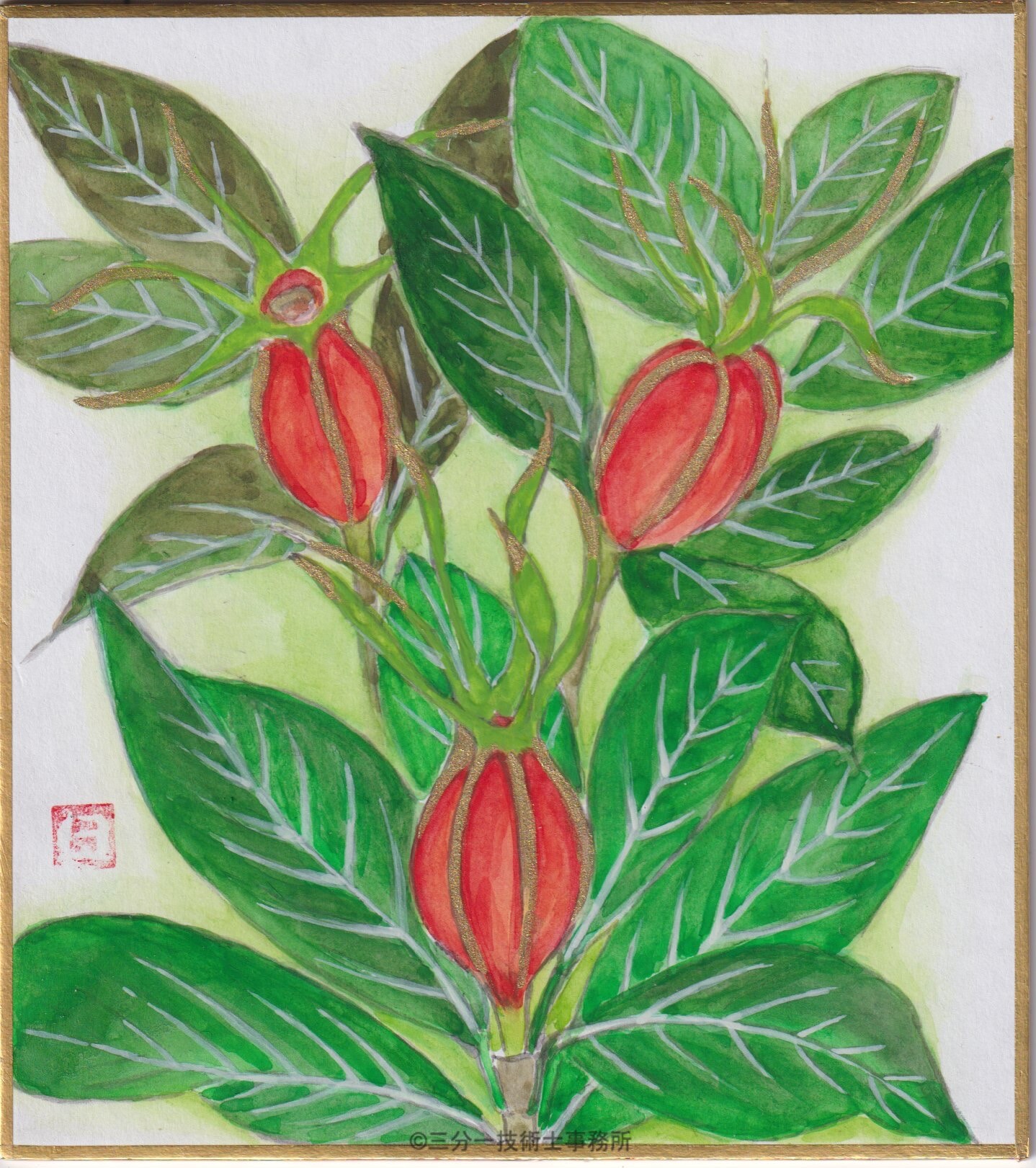 Sunsho-an Color Paper (1/4 size 136×120mm)
Sunsho-an Color Paper (1/4 size 136×120mm)
Persimmon Autumn Leaves – October 2022
In the fall, before the leaves finally fall off, they turn shades of red and yellow, preserving the rich ambiance of nature.
The origin of the persimmon’s name is believed to come from the autumn leaves’ color and the fruit’s color, “red-yellow” (Akaki), hence it was called “Kaki.”
Furthermore, to preserve persimmons for a longer period, they start the process of making dried persimmons.
Date: 5th October, Reiwa 4 (2022)
Note: The term “Akaki” refers to the colors red and yellow, and “Kaki” is the word for persimmon in Japanese.
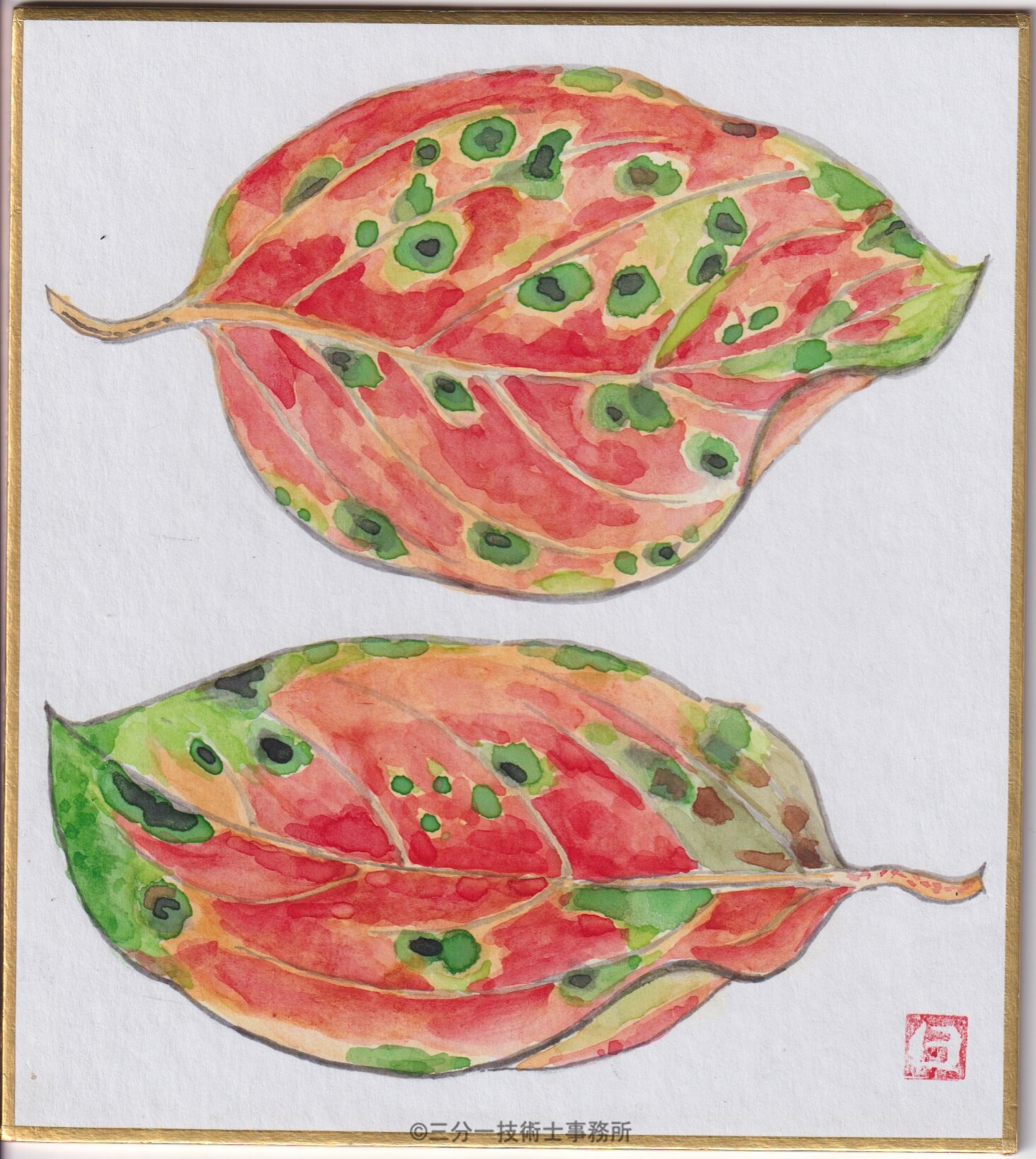 Sunsho-an Color Paper (1/4 size 136×120mm)
Sunsho-an Color Paper (1/4 size 136×120mm)
Chestnut – From the Jomon Period, September 2022
Chestnuts were a significant food source in ancient times, even before the start of farming.
Modern Japanese chestnuts are large, delicious, and a quintessential flavor of autumn.
The wood from chestnut trees, rich in tannins, is utilized for railway sleepers, shipbuilding, and as a substrate for cultivating Shiitake mushrooms. The bark and burr are used as dyes.
In the countryside, chestnut trees continue to be cherished and planted by many.
Date: 11th September, Reiwa 4 (2022)
Note: The Jomon period is the time in prehistoric Japan from about 14,000 B.C. to about 300 B.C., during which the earliest major culture of prehistoric Japan developed and flourished.
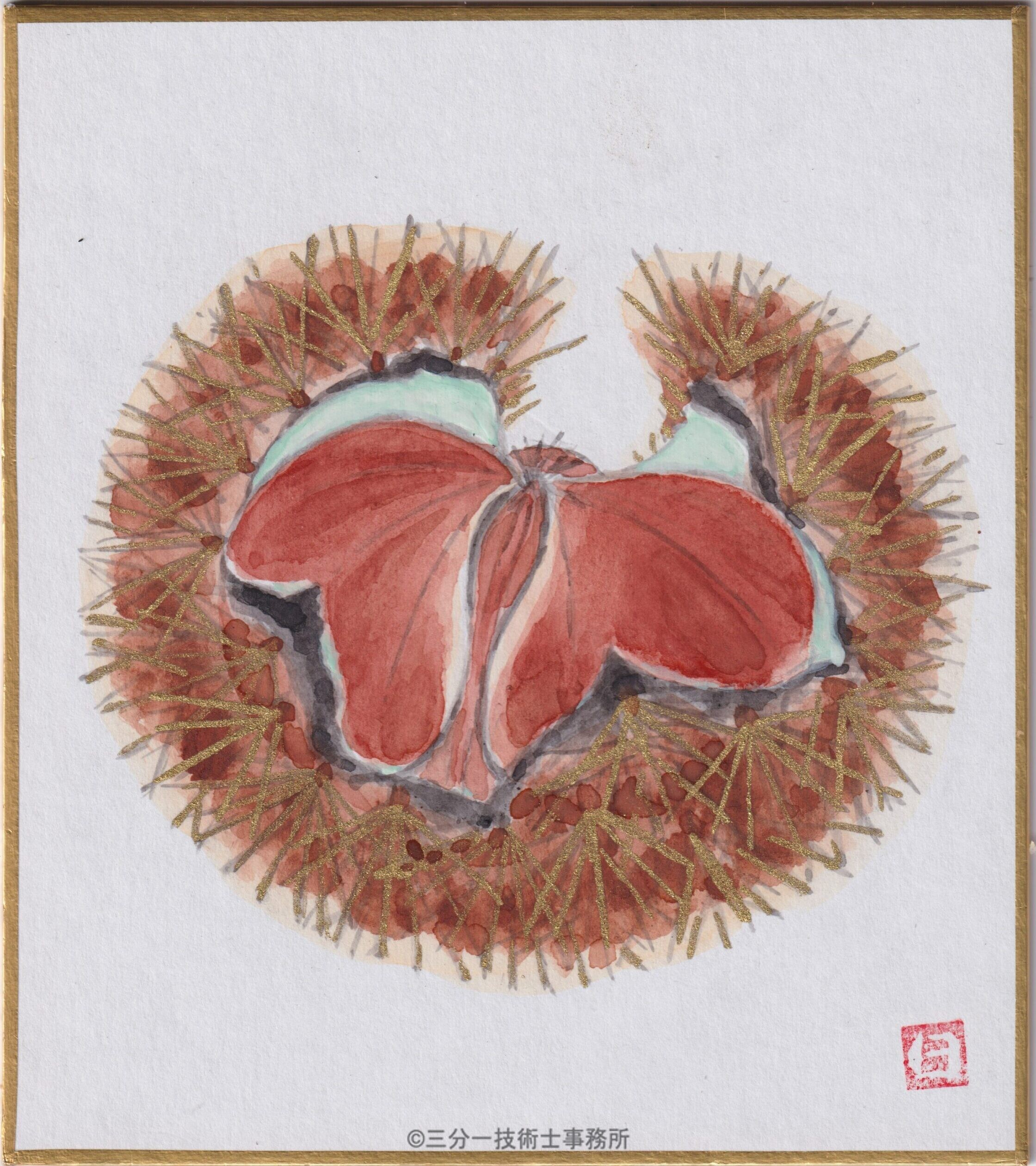 Sunsho-an Color Paper (1/4 size 136×120mm)
Sunsho-an Color Paper (1/4 size 136×120mm)
AkitsuーKageroーDragonfly 2022.8
The oldest name for a dragonfly is “Akitsu” in the Nara period. It is said that the origin of the word “Tonbo” since the Edo period is “flying stick”.
Dragonflies only move forward, and are also called “Kachimushi” and are used as lucky charms in the design of armor and accessories. And even now, children play with bamboo dragonfly.
August 4, 2020
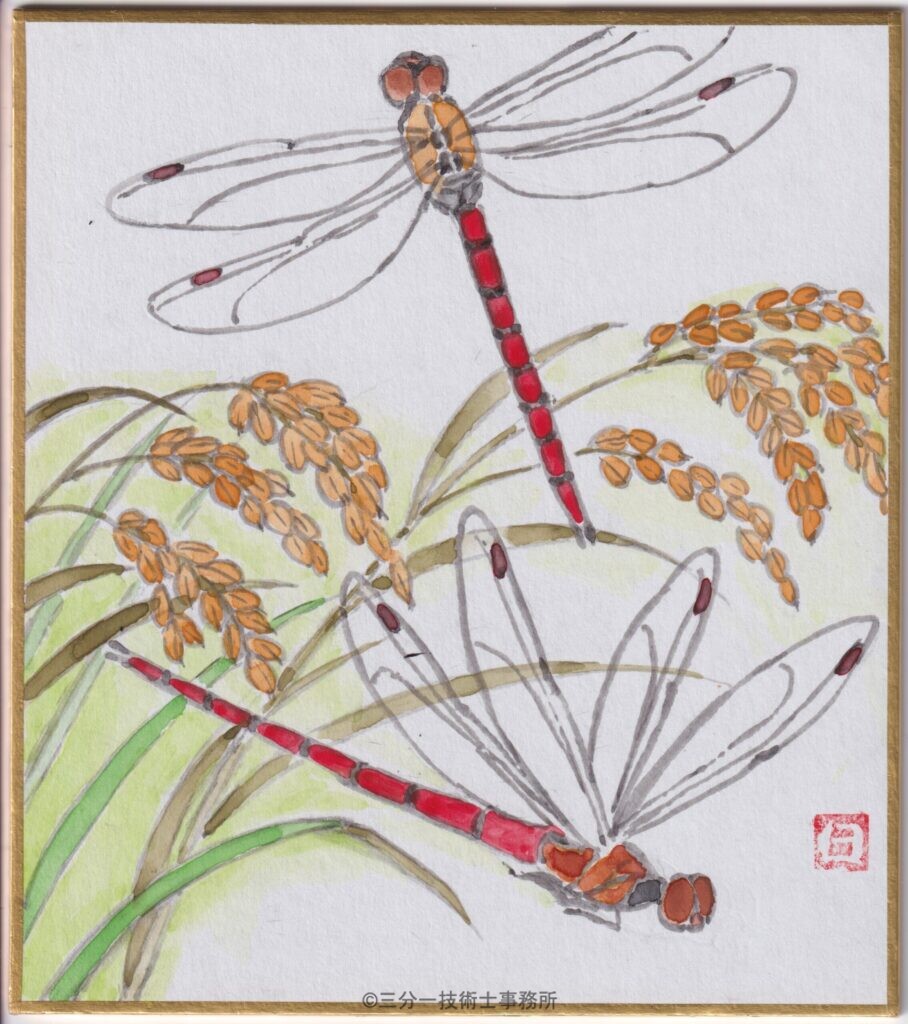 Sunshoan colored paper (1/4 size)
Sunshoan colored paper (1/4 size)
Mukuge Kinkaichijitsu 2022.7
A tree that blooms one after another during the summer. “One day flowers” that make new flowers bloom in the morning and fall all at once in the evening.
It is ephemeral, so it has a taste. There are many varieties of cinnamon tree, and it is often used as a flower in tea ceremonies. Senke Three Generations Soutan is white bottom red this flower “Sotan Mukuge”, named after it.
About 400 years ago.
July 16, 2020
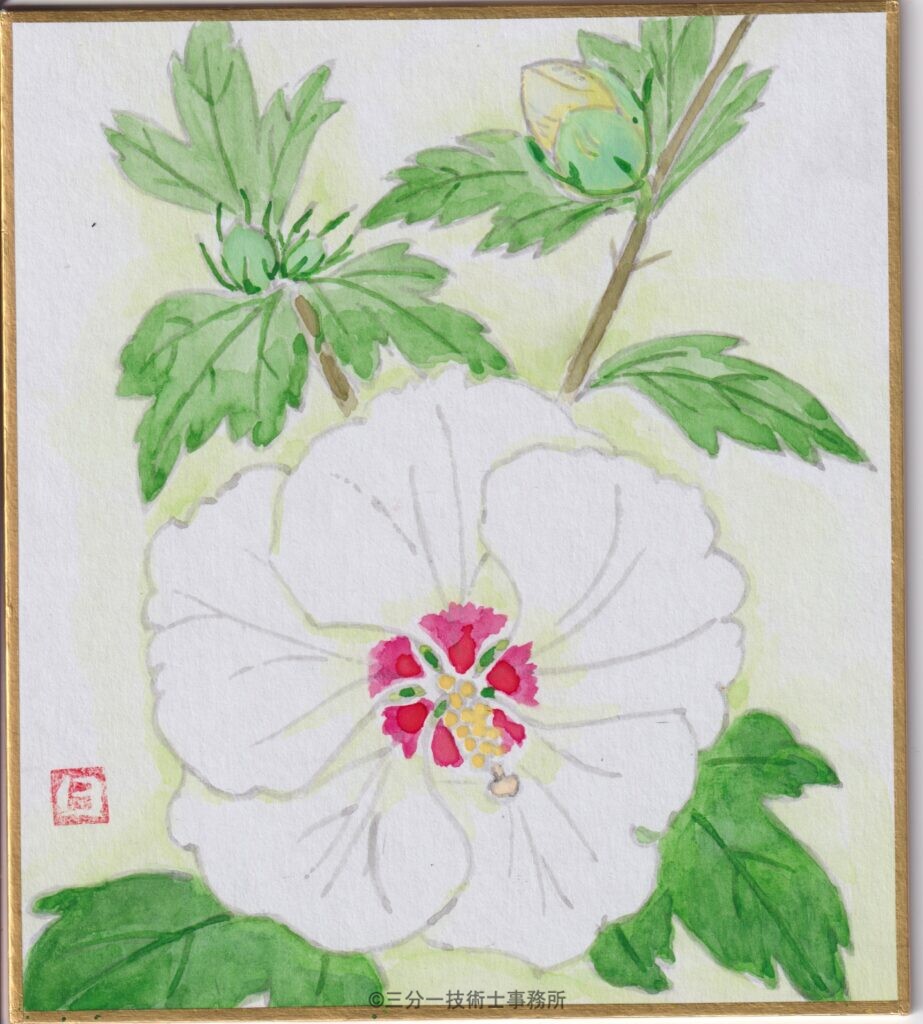 Sunshoan colored paper (1/4 size)
Sunshoan colored paper (1/4 size)
LargeLeave a wish upon a star 2022.6
It is said that since the Heian period, wishes were written in ink on oak leaves and tied to bamboo leaves during Tanabata. It is said that it was around the Meiji period that the traditional Kaji leaf was replaced with the strip of paper.
A colorful strip of paper entrusted to the stars of the night sky and still inherited, May people’s wishes come true for him.
June 10, 2020
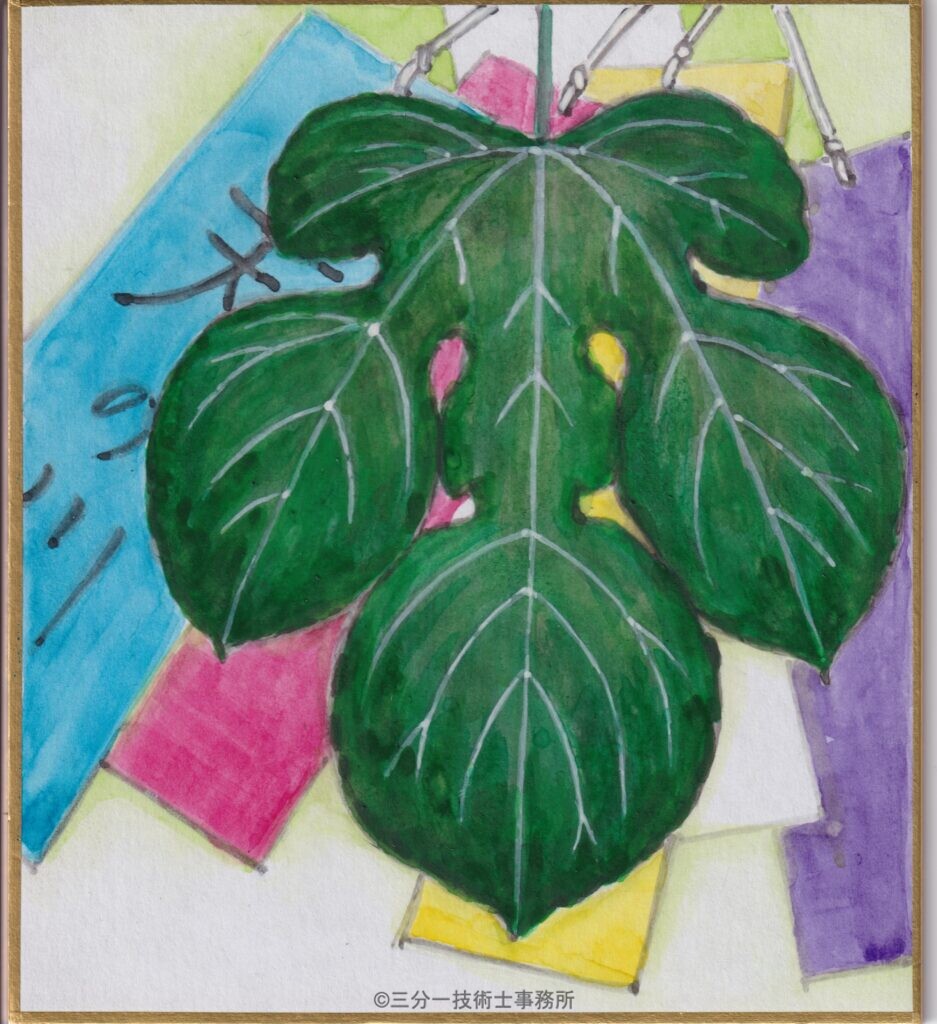 Sunshoan colored paper (1/4 size)
Sunshoan colored paper (1/4 size)
Juyaku Japanese herb no megumi 2022.5
The white cross flower is the familiar “Dokudami”
It is derived from “Dokuitami” because it is effective against poison and pain. The fragrance of fresh leaves is strong, and it is a medicinal herb that is also called “ten medicines”. Dokudami tea, made from dried leaves and stems, is said to be good for health, and fresh leaves and shochu or white liquor can be used as lotion or insect repellent spray.
The flowers of Toyaku are Mashiro and have a deodorizing effect. Yes, please had.
May 15, 2020
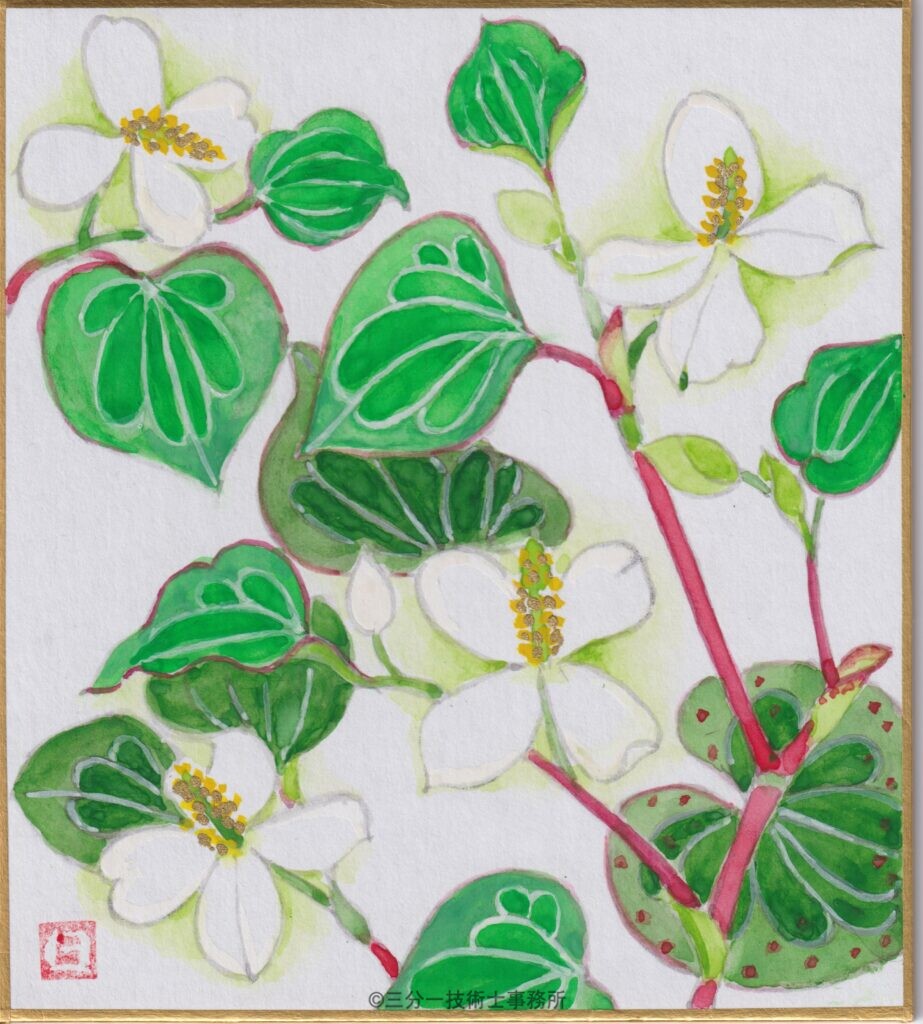 Sunshoan colored paper (1/4 size)
Sunshoan colored paper (1/4 size)
Saga aka Phalaenopsis 2022.4
When I looked down at my feet, I saw wildflowers blooming that were strong, beautiful, and bright, enduring the shade.It grows in clusters at the edges of forests, and the flowers bloom one after another for a day, and the leaves are glossy bright green and gently drooping.
April 12, 2020
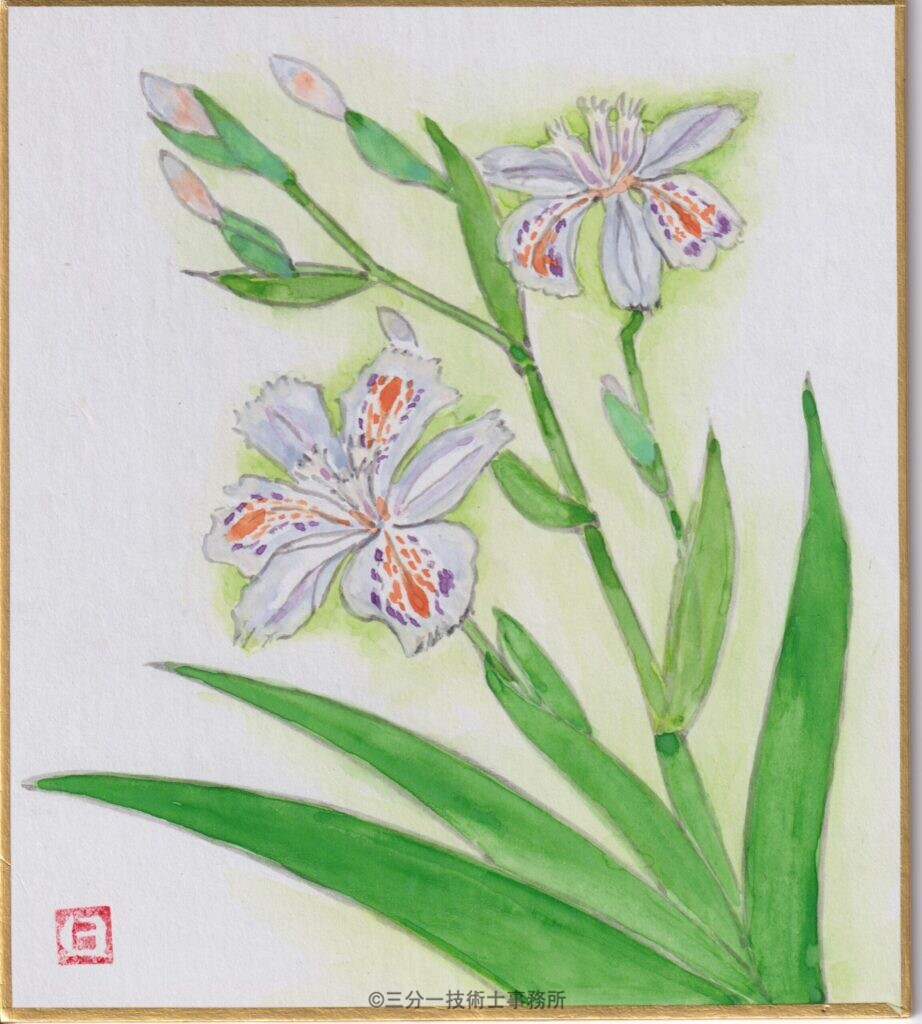 Sunshoan colored paper (1/4 size)
Sunshoan colored paper (1/4 size)
Tsubame Lucky Messenger 2022.3
At the beginning of the full-scale farming season in spring, swallows travel thousands of kilometers across the sea from southern countries toward Japan.
And they choose places where there are people and come. They gather dirt and mud to build nests under the eaves, raise their young, and fly to catch insects and carry them to their nests.
the swallow’s cry “Chui Chui Ju”. It is said that it is bitter to eat the earth and eat the insects.
March 13, 2020
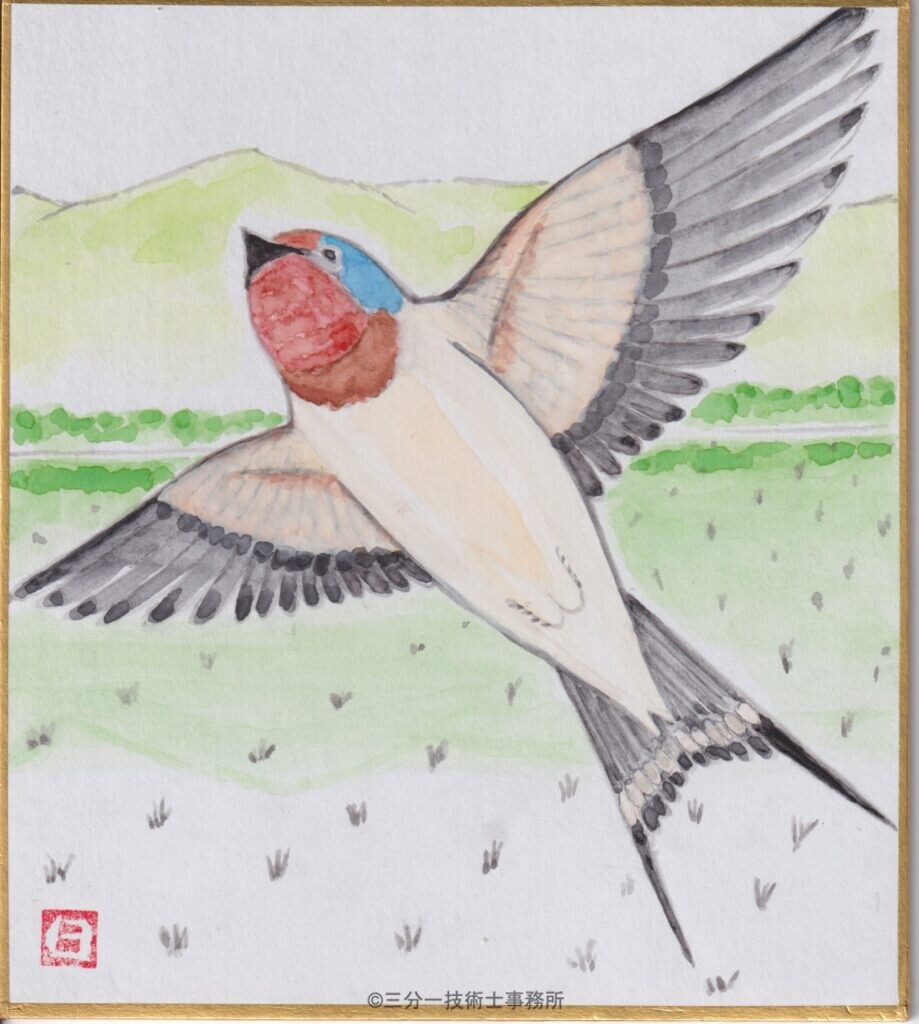 Sunshoan colored paper (1/4 size)
Sunshoan colored paper (1/4 size)
Fukinotou Spring messenger 2022.2
In early spring, a round face emerges from fuki in a corner of the satoyama bud is “fukinoto”. Butterbur is a wild vegetable, and you can eat the buds, leaves, and stems. Fukinoto is tempura and she is fuki miso, but she is bittersweet and delicious.
“Fukinotou” that seems to wrap the light of spring In the old days, people were excited.
February 11, 2020
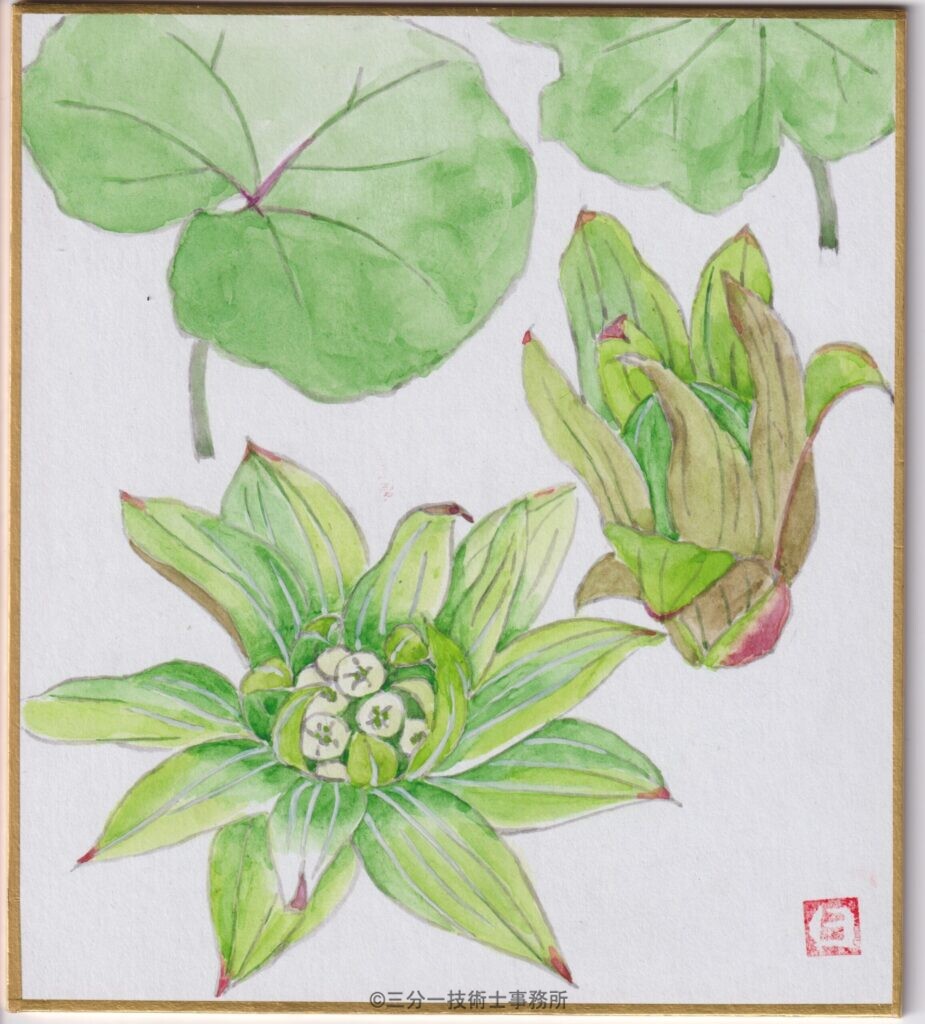 Sunshoan colored paper (1/4 size)
Sunshoan colored paper (1/4 size)
Camellia Flowering tree native to Japan 2022.1
“In winter when there are few flowers” It blooms with glossy green thick foliage and her striking flowers. “Camellia oil” is made from the black seeds and is said to be good for hair and skin. Since the grain of the wood is hard,fee, Even if it is “charcoal”, it is usefully used.
There was a good camellia that has been popular since ancient times in Japan.
January 15, 2020
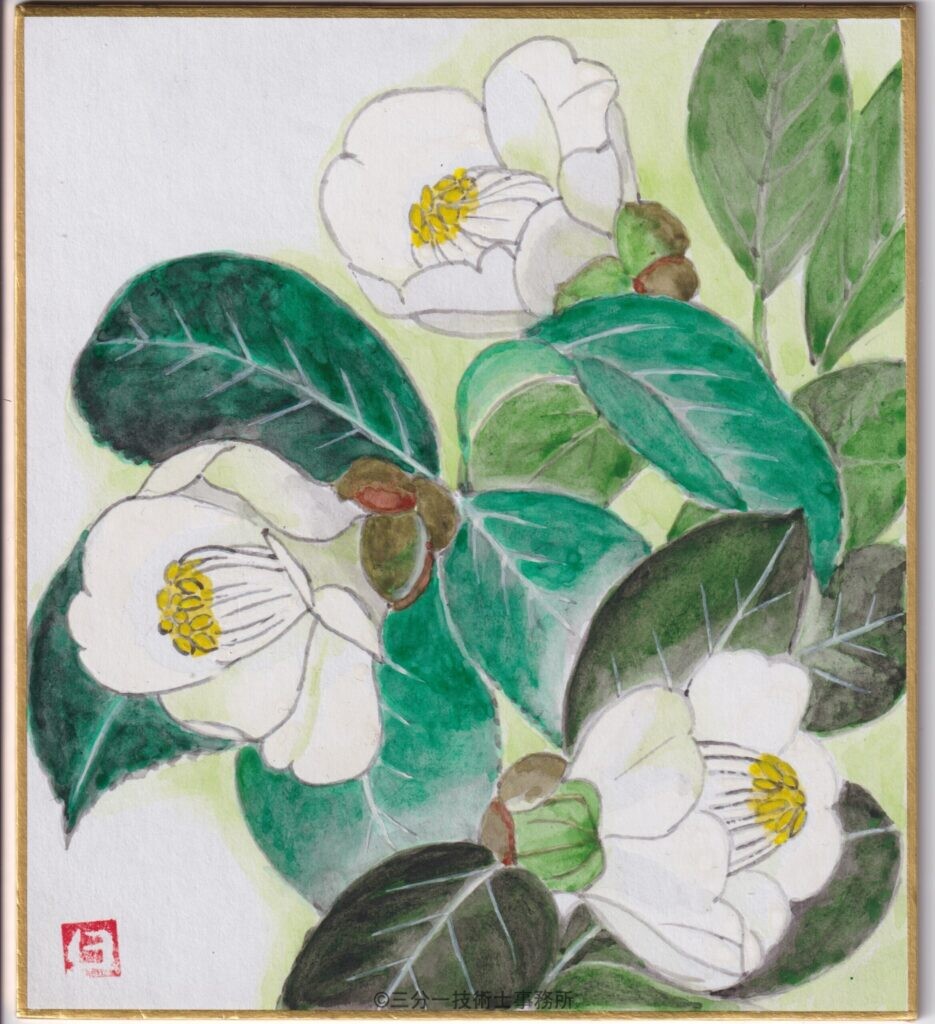 Sunshoan colored paper (1/4 size)
Sunshoan colored paper (1/4 size)
Happy New Year 2022.1
Somewhere quietly cleansed. Both the water and the air feel “clear”. The zodiac tiger glares in all directions and wards off evil spirits.
Have a healthy and happy year. I wish you all the best.
New Year’s Day 2020
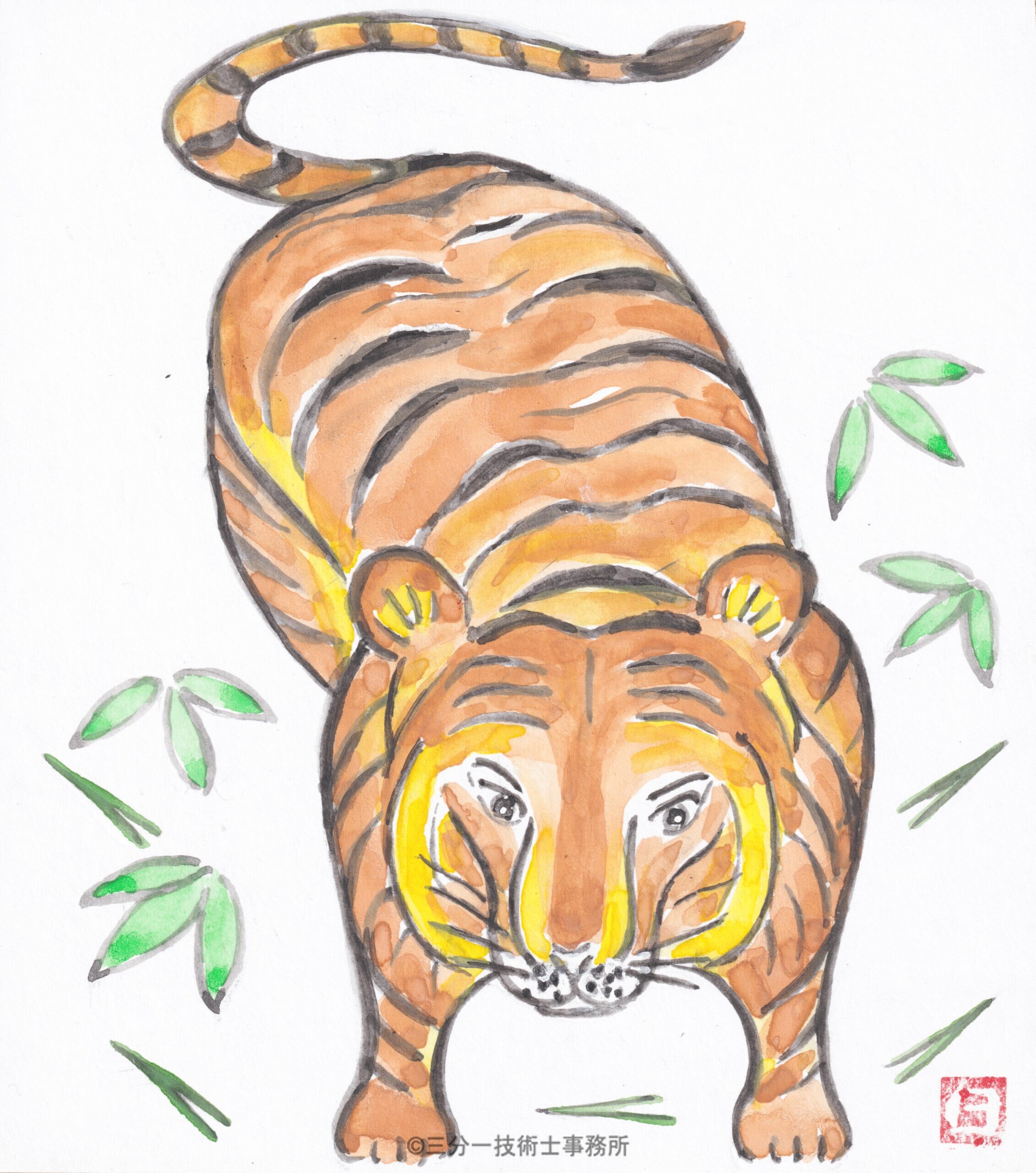 Sunshoan colored paper (1/4 size)
Sunshoan colored paper (1/4 size)
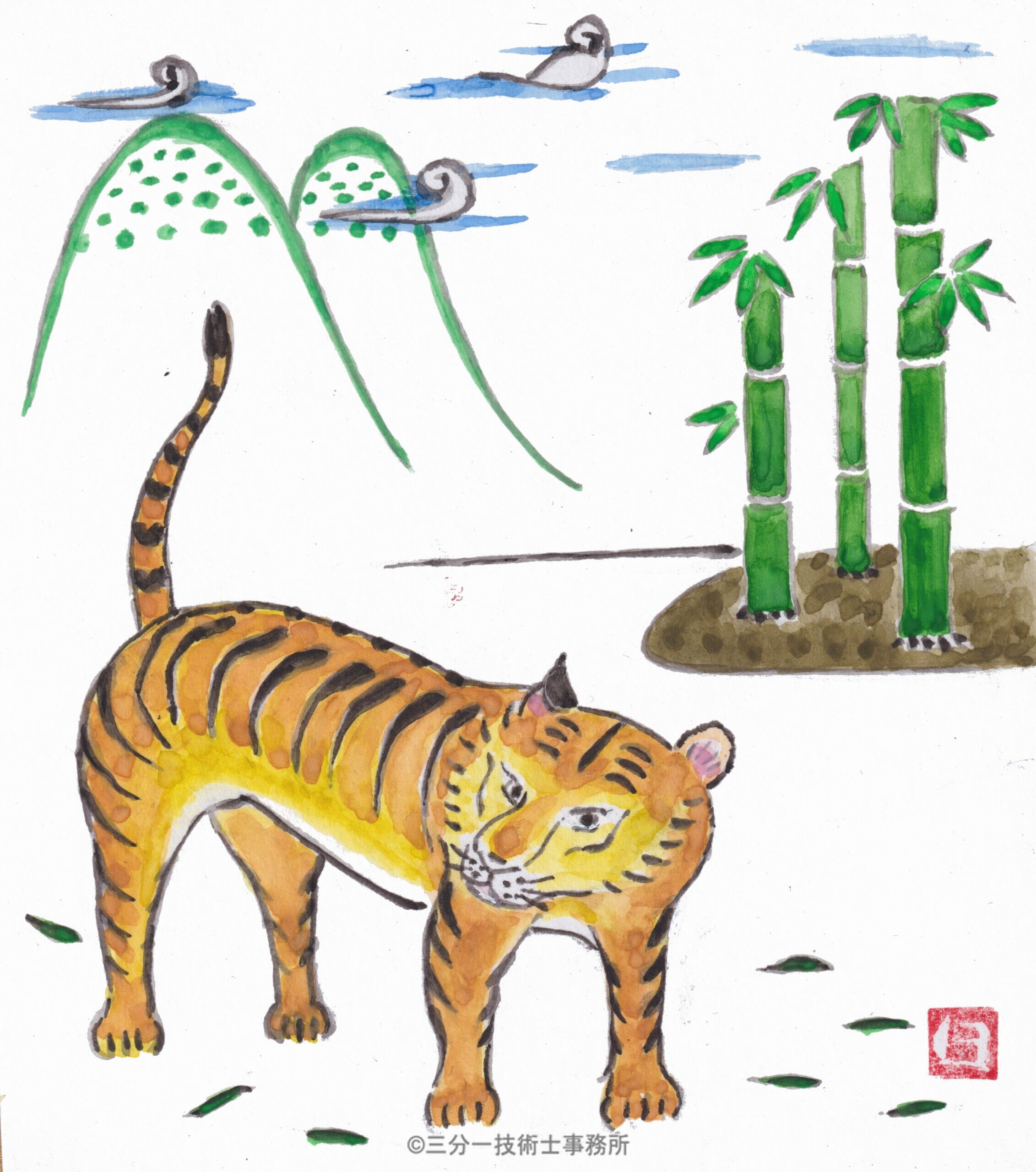 Sunshoan colored paper (1/4 size)
Sunshoan colored paper (1/4 size)
10,000 evergreen leaves forever 2021.11
A small Japanese shrub that has been loved since ancient times. It sprouts before you know it, and in winter bear red berries. Wild birds eat the fruit. Also, the seeds are dropped and germinated.
November 16, 2021
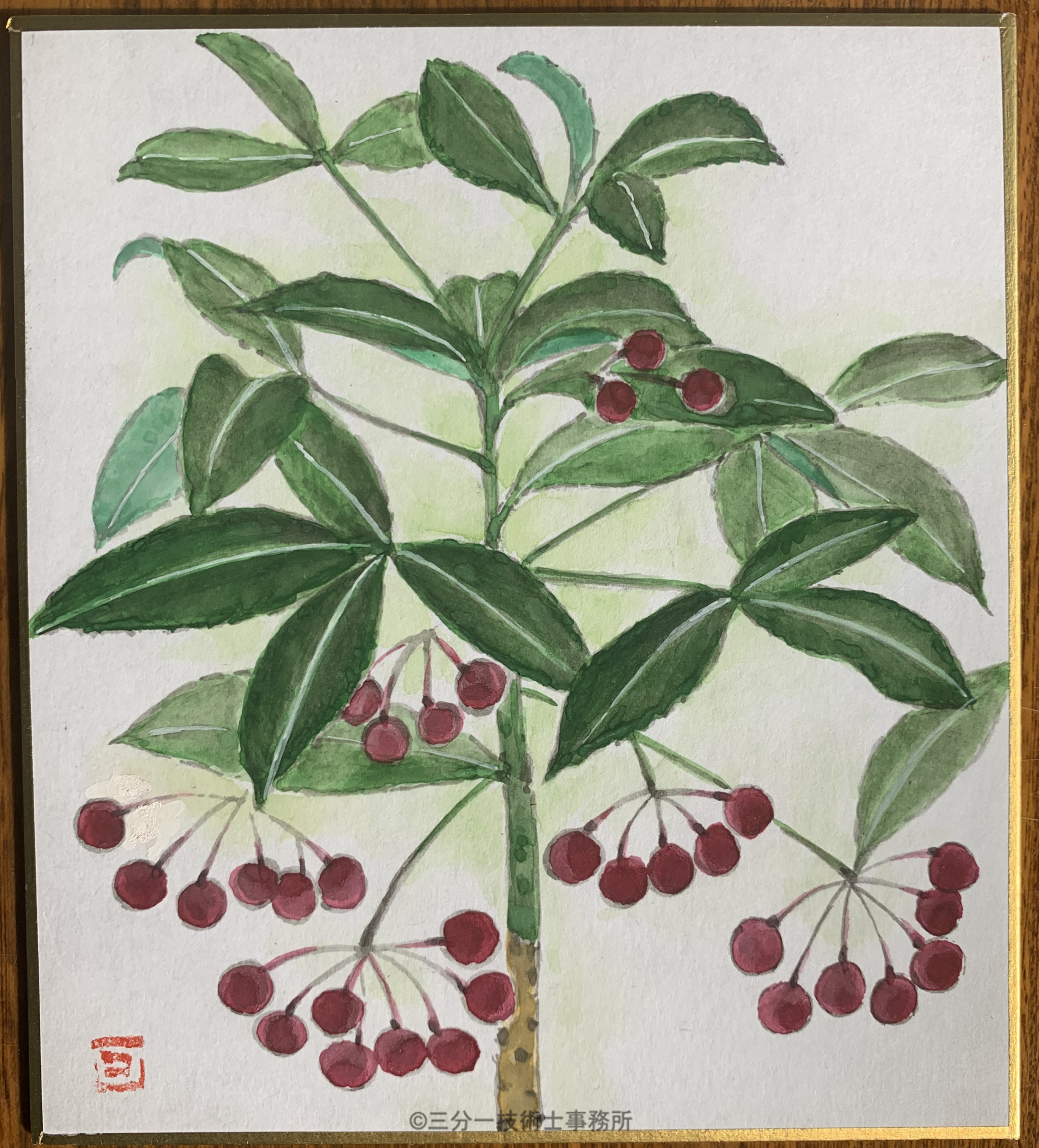 Sunshoan colored paper (1/4 size)
Sunshoan colored paper (1/4 size)
Maple colored autumn leaves 2021.10
Maple is said to have come to be called “kaede” because the shape of the leaves resembles “a frog’s hand”. In gardens and fields, the leaves of ivy, goby, and persimmon turn red, giving you a sense of the richness of nature.
October 15, 2021
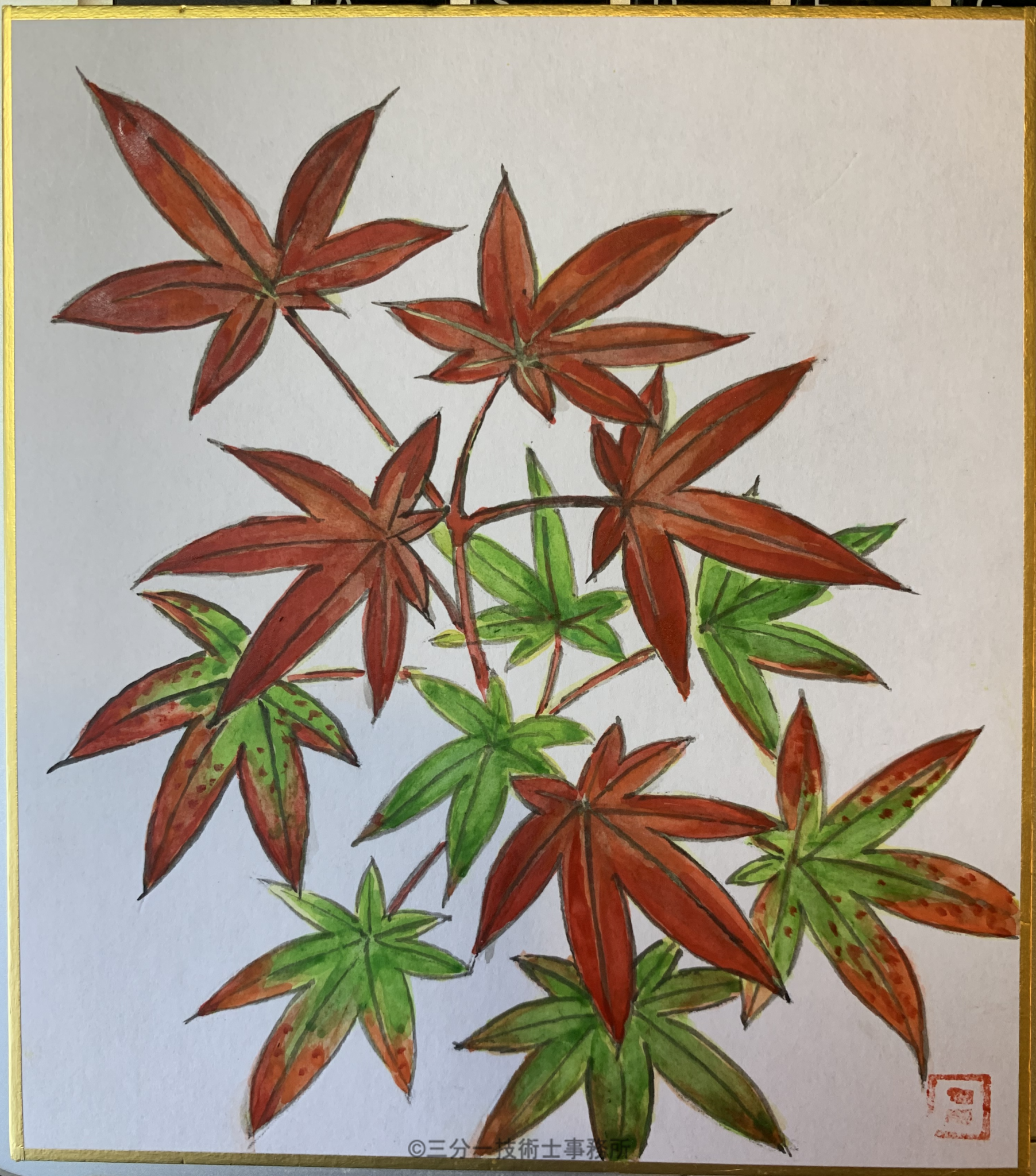 Sunshoan colored paper (1/4 size)
Sunshoan colored paper (1/4 size)
Cosmos 2021.9
Cosmos The English name for cosmos is the universe. In the clear autumn sky, the petals of her cosmos are thin and delicate, and the leaves are thin and soft like threads. Even if it is blown by the wind, even if it is trampled, it will rise again and continue to bloom with a smile.
September 24, 2021
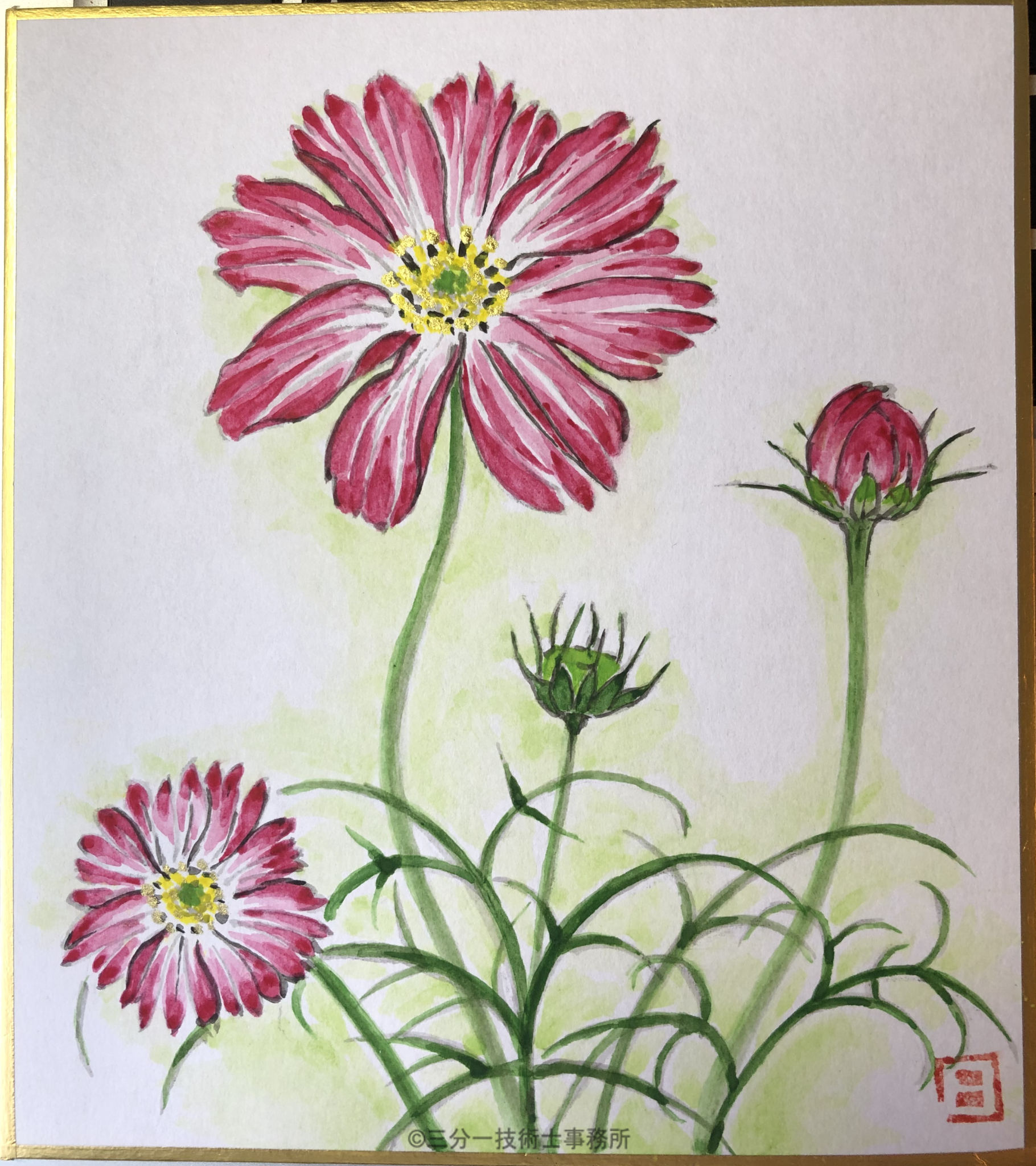 Sunshoan colored paper (1/4 size)
Sunshoan colored paper (1/4 size)
columbine and forget-me-not 2021.7
Columbine was named because the shape of the flower resembles the ramie around which the thread is spun. Forget-me-nots are popular in the West, and there are many legends in each country.
I think that the combination of ramie and forget-me-not is a pretty flower that blends in with Western style.
July 1, 2021
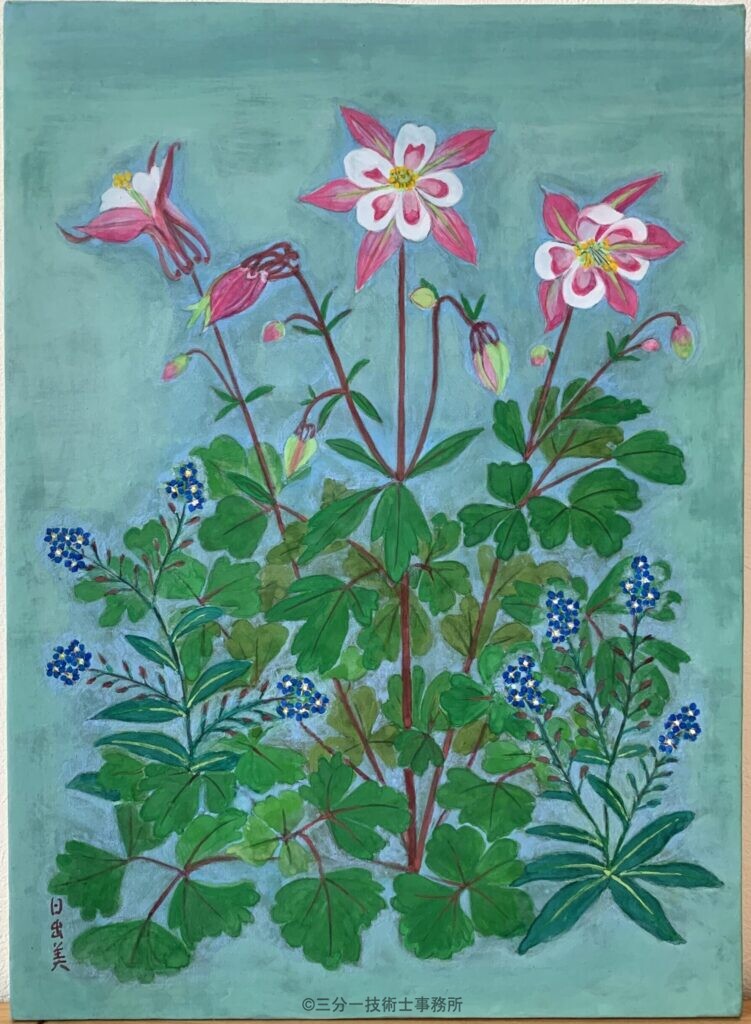 (Main image 4F)
(Main image 4F)
Naniwa rose 2021.6
The Naniwa rose is said to have been brought to Japan by merchants from Naniwa long ago. And the painters of old make pictures and designs.
I was fascinated by this flower again and wanted to draw it many times.
Please take a look.
June 1, 2021
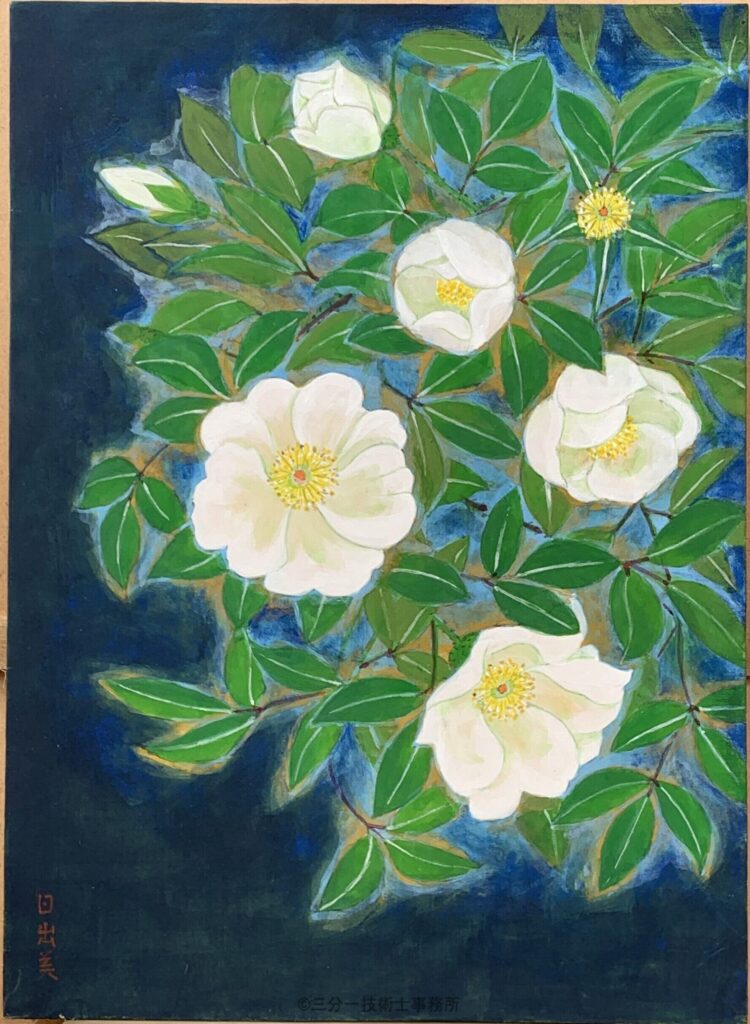 (Main image 4F)
(Main image 4F)
Flowers in spring 2021.3
Thistle and Ten Medicines
The white cross flower is a familiar dokudami that has been used as a folk medicinal herb. It is also called “Ten Medicine”. Thistle is also a medicinal herb. It is a familiar flower that blooms naturally in the mountains. When I was drawing the thistle, there was an interesting moment when it turned into fluff and flew in the sky. The thistles and ten medicines were blooming like they were playing.
Please take a look.
March 6, 2021
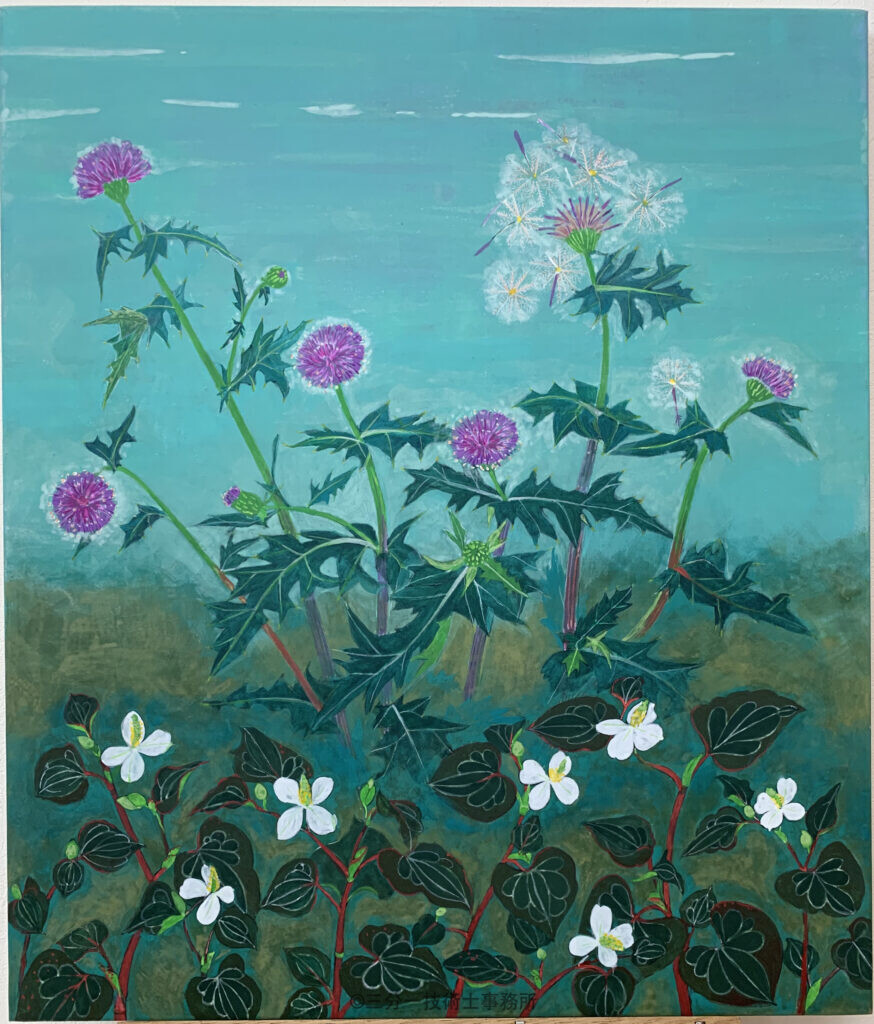 (Main image 10F)
(Main image 10F)
New Year’s Day 2021
happy new year to her
The mountains are green and the gentle breeze blows. Cows carry bales of rice home. Pine needles, bamboo grass, plums are available,
Have a prosperous, happy and healthy year. I drew it in the hope that it would be there.
January 1, 2021
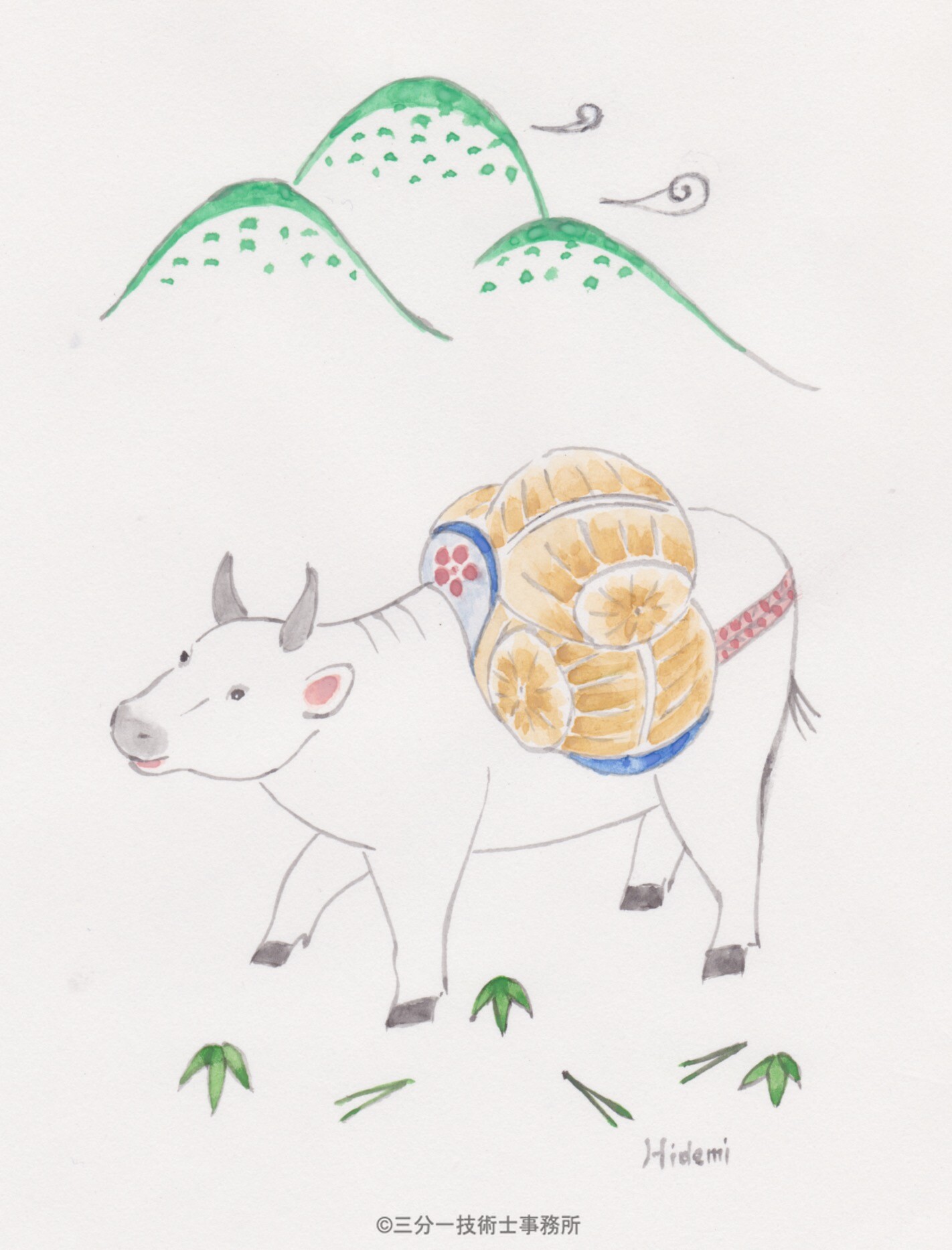
Hotarubukuro Akabana 2020.6
Light pink firefly bag swaying in the wind. It is a mountain grass that makes many flowers bloom beautifully, probably because it suits the climate of Japan. Blooms for a long time.
June 22, 2020
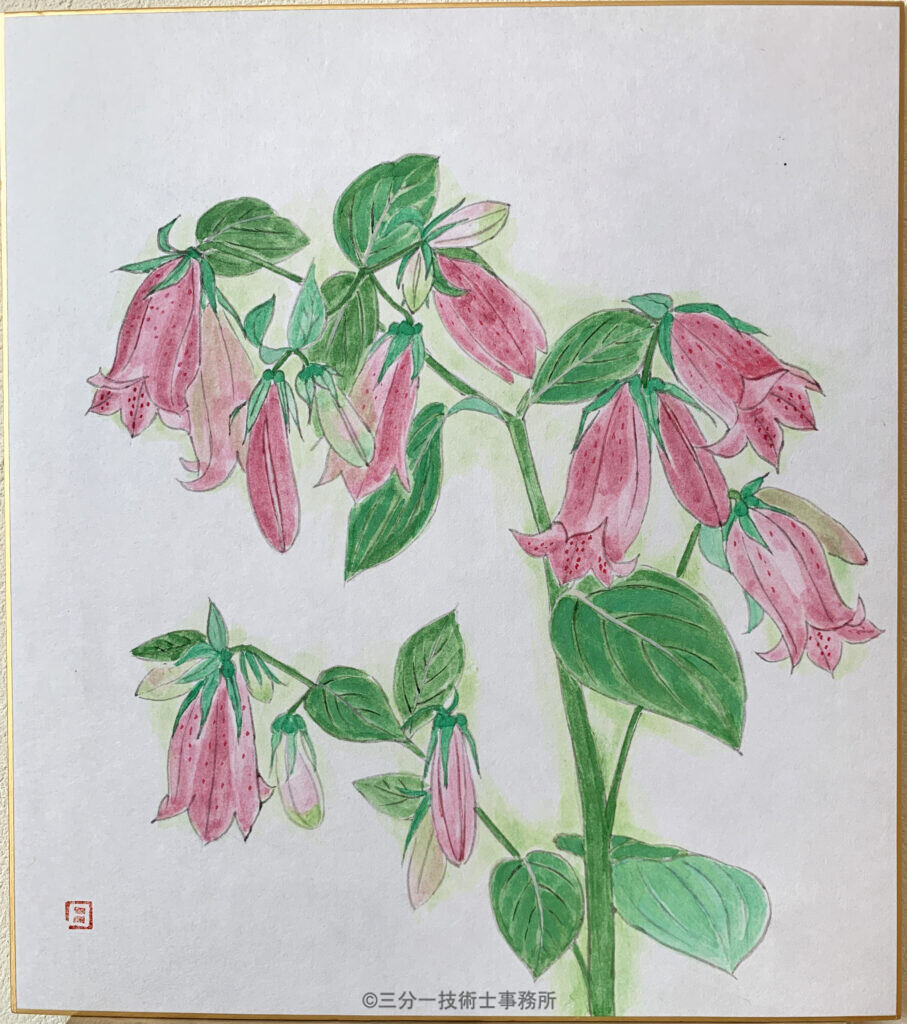 (colored paper)
(colored paper)
Naniwa rose 2020.6
It is one of the original roses (Old Rose) and has large white flowers. The buds, when they are just beginning to bloom, and when they are in full bloom, you can feel the beauty. Among roses, this is my favorite flower.
June 16, 2020
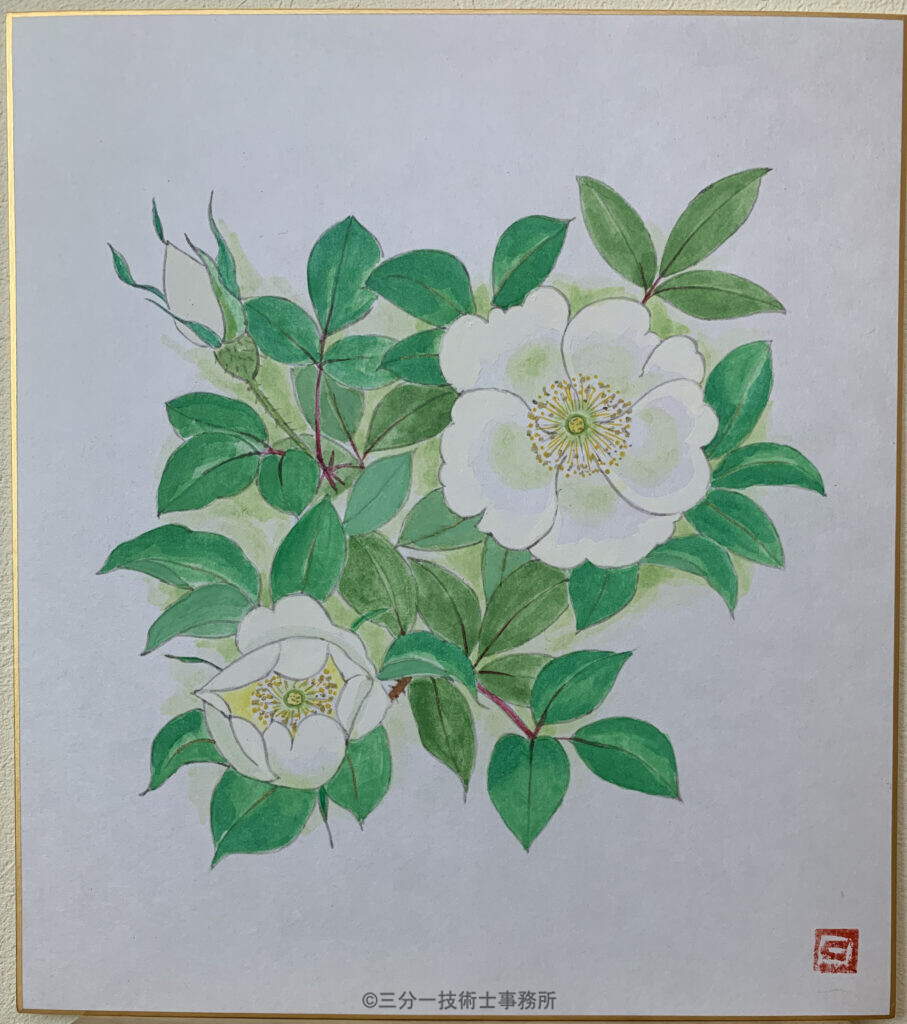 (colored paper)
(colored paper)
Flowers in spring 2020.4
I wanted to draw a white or pink bellflower that sways in the wind in the fields. Each is a 6th picture, but if you put 1 and 2 together, I would like you to see the blue sky and the flowers spreading on the ground.
April 7, 2020
Flowers in Spring: White Firefly Bag 1
Flowers in Spring: Red Firefly Bag 2
Flowers in Spring 2020
Happy New Year
I hope you have a healthy and happy year. Thank you for your continued support this year.
New Year’s Day 2020
The mouse is said to be the messenger of Daikoku-sama, one of the seven deities of good fortune.
It would be nice if you could shake her mallet and get what you want.
There are many bales of rice in the storehouse, and I painted it with the hope that the house where I live will be prosperous.
The ivy, which keeps the green forever, is a favorite plant that has lovely star-shaped leaves. Combined with a young woman, I tried to devise a soft hand.
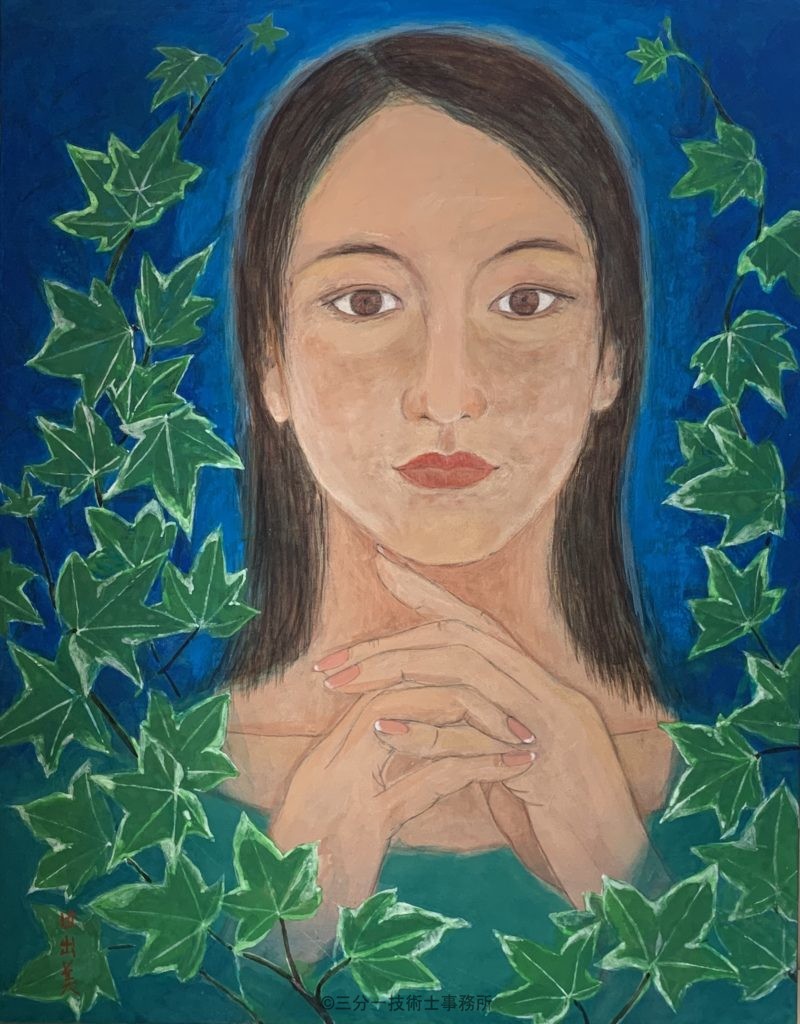 蔦 6F March 2020
蔦 6F March 2020
This Shikishi is to display in the Yoritsuki-machiai, a place where customers invited to the tea ceremony waiting for host. The theme is filled with the seasons, tastes, and feelings of the host.
17 October 2019
What is your favorite flower in autumn? When asked, there was a person who replied Higanhana.
I searched for the cluster amaryllis that started to bloom.
I wanted to draw a flower as it is in the nature field.
27 September, 2019

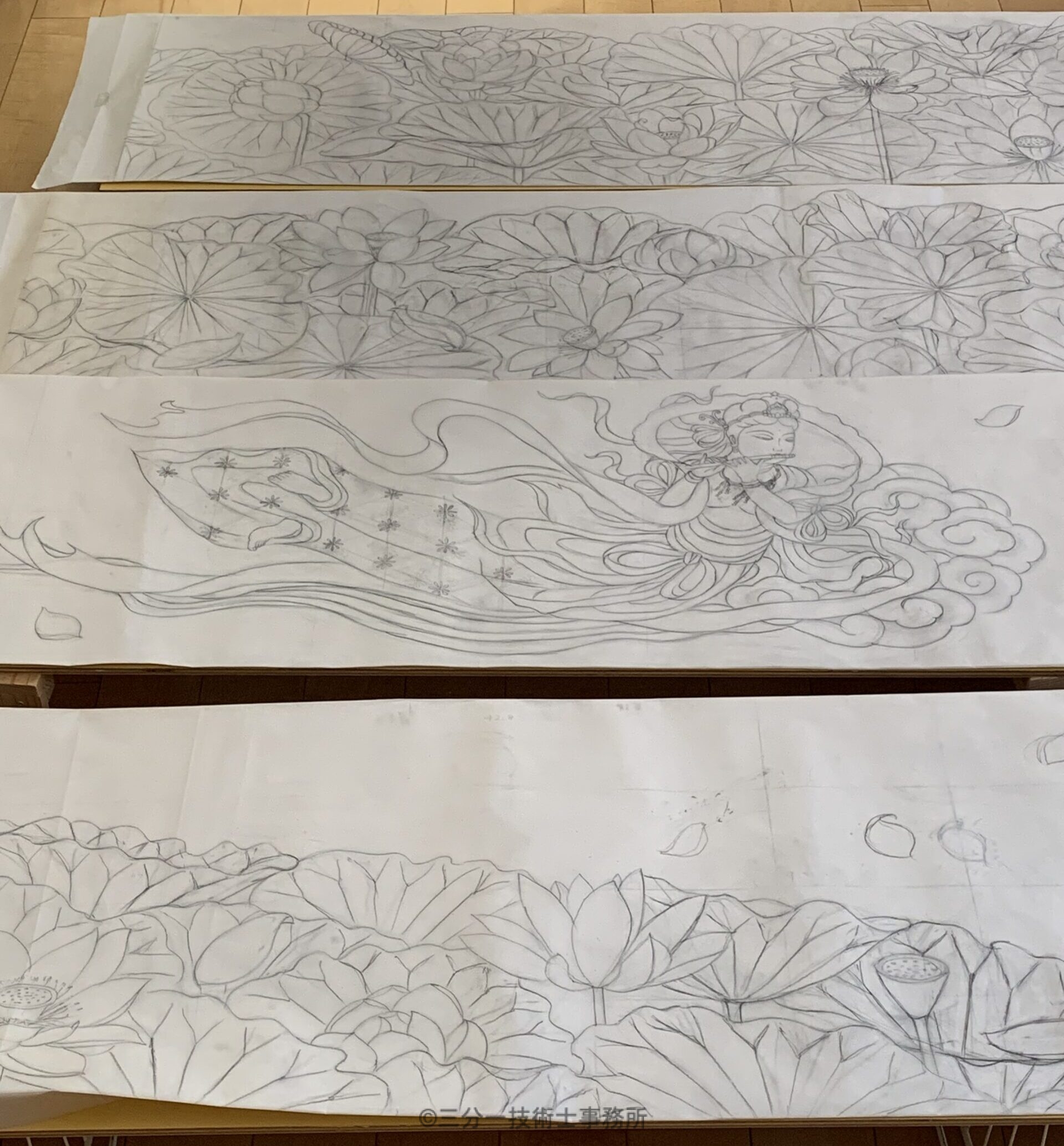
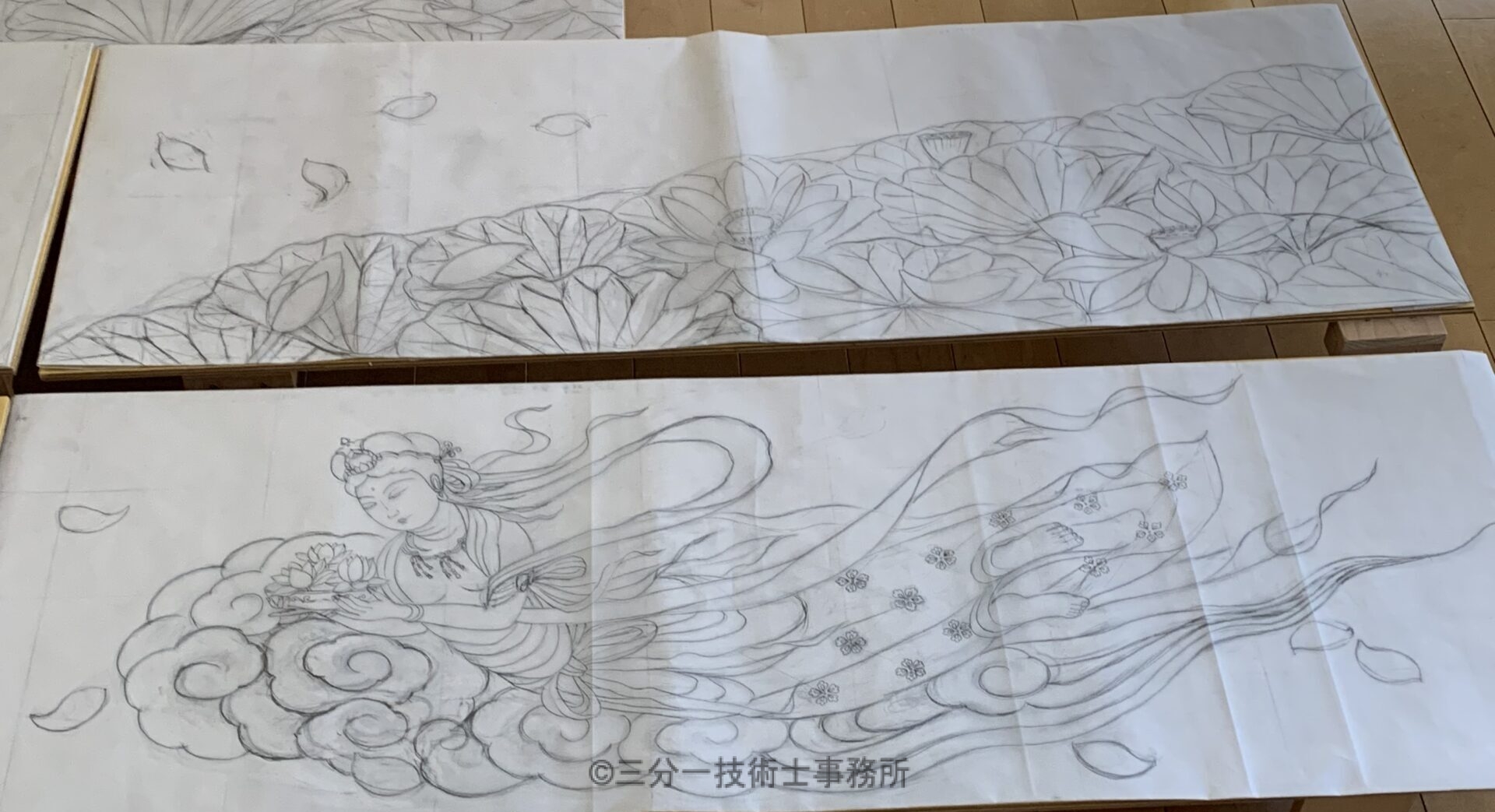
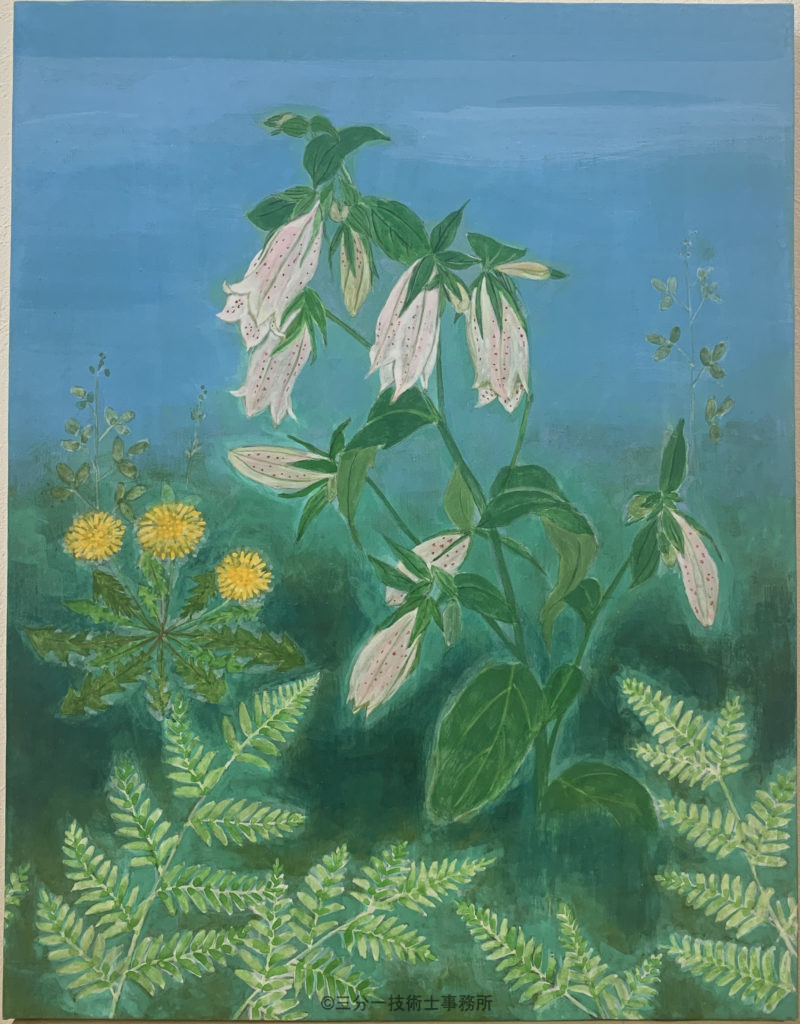
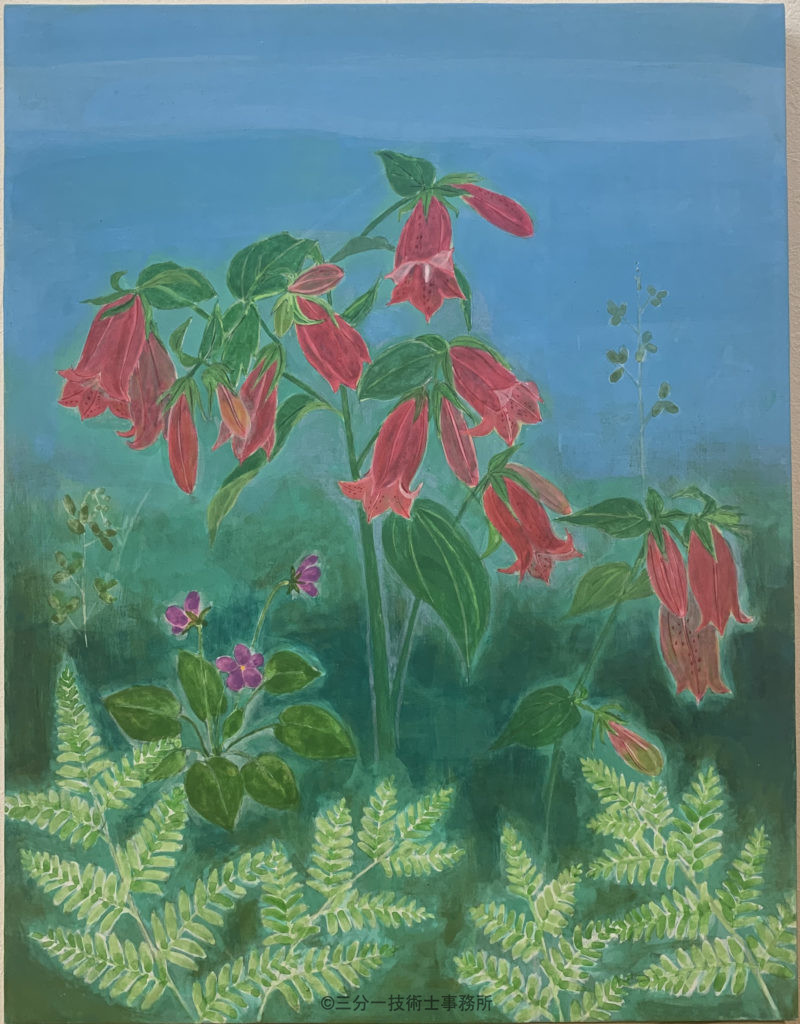
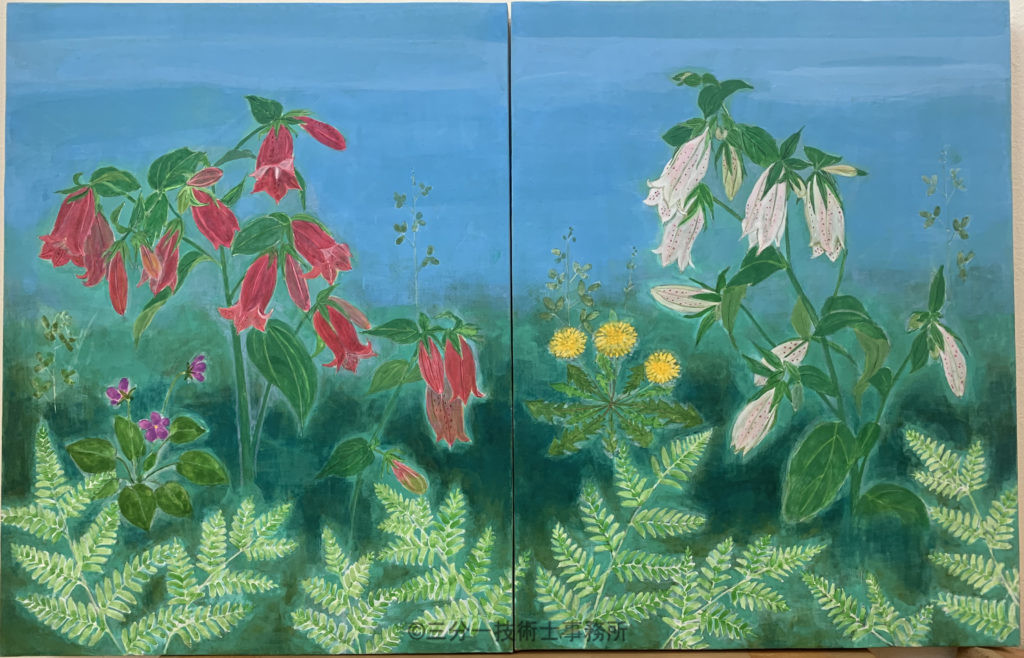

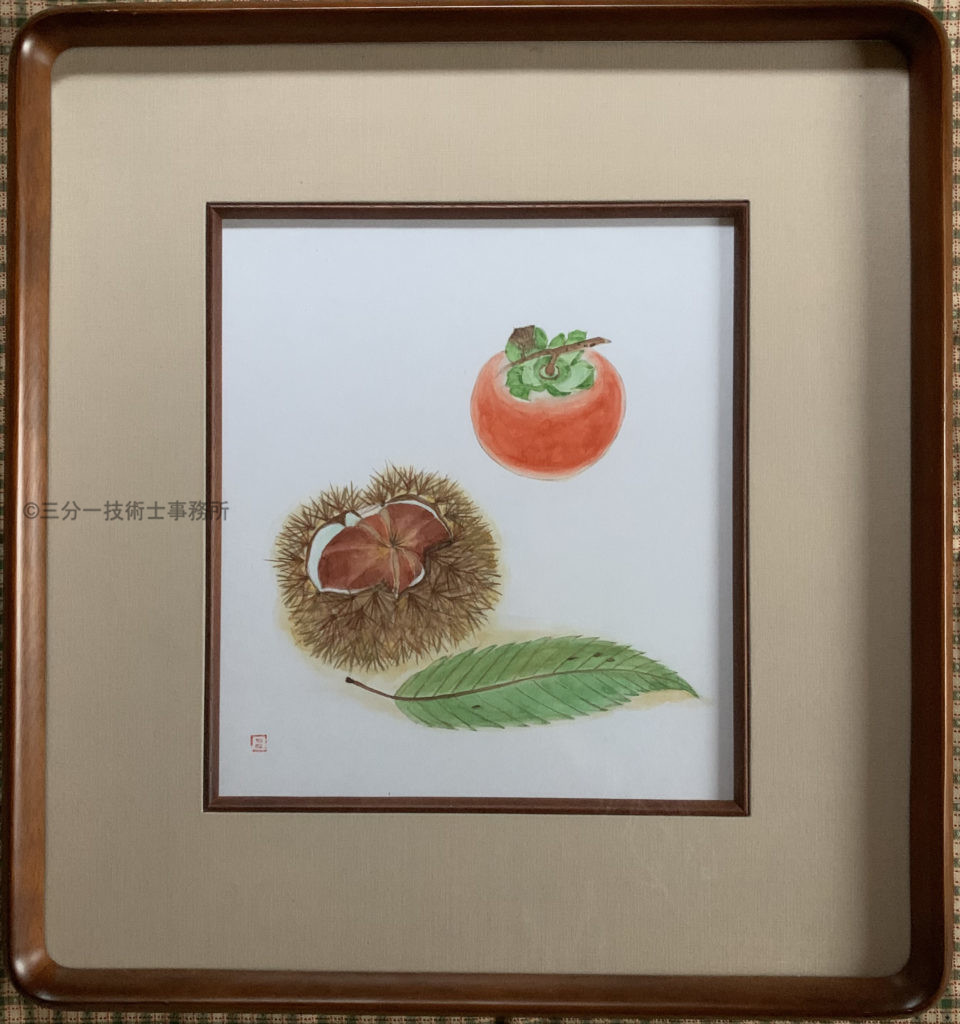
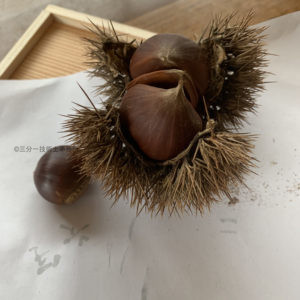
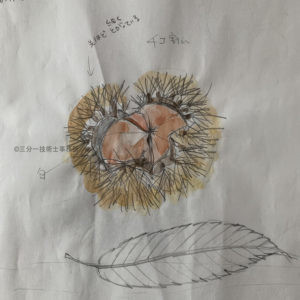
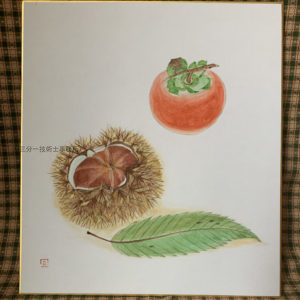
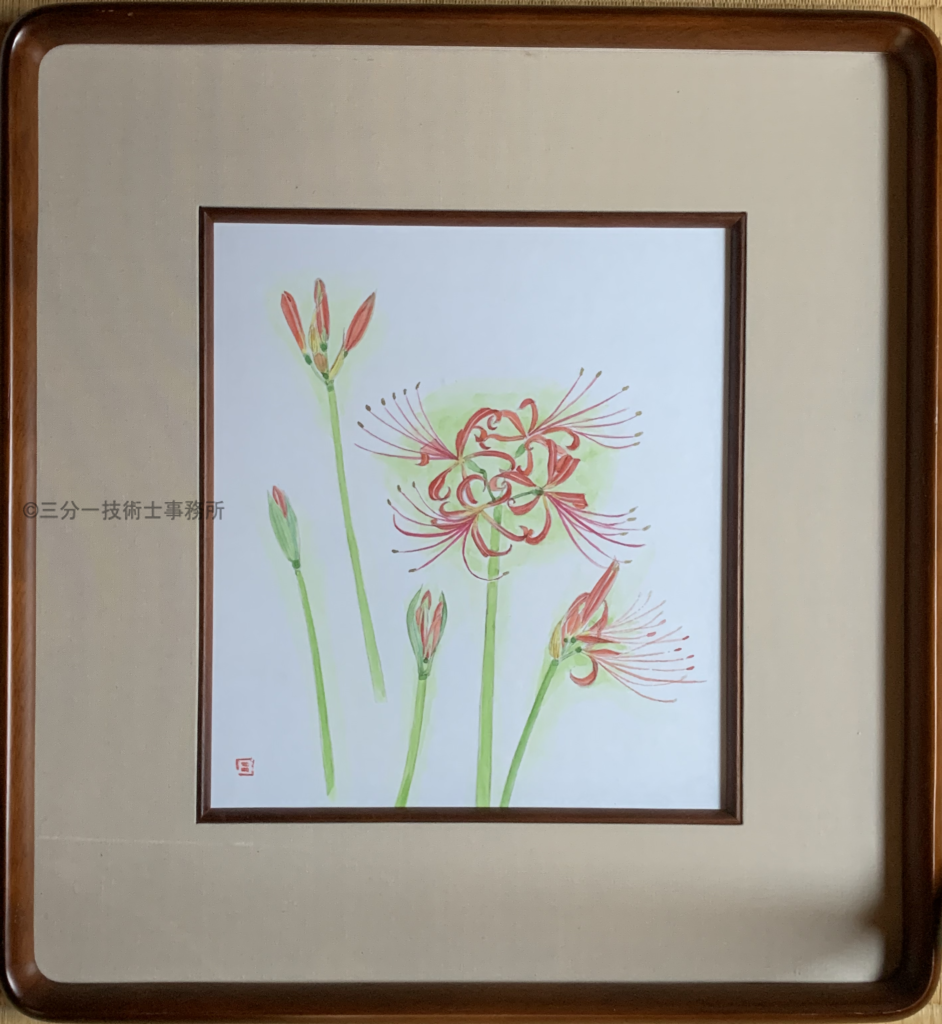
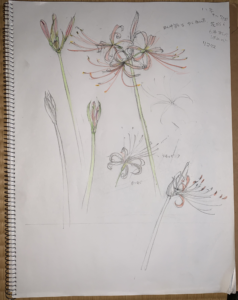



Leave a Reply